First Computer LM13WL Notebook User Manual
First International Computer Inc Notebook Users Manual
Users Manual
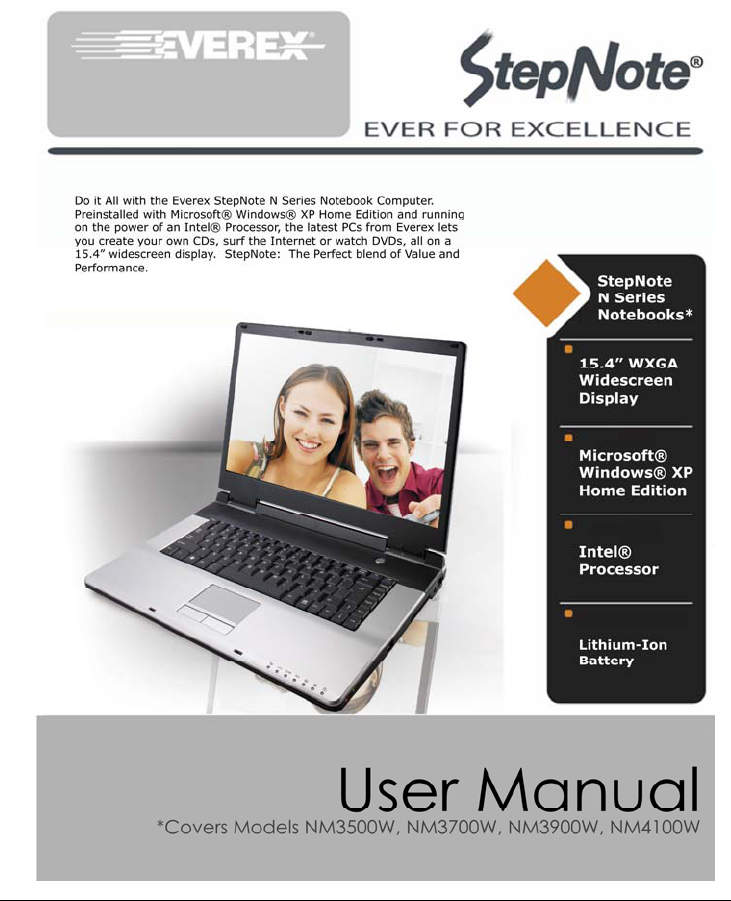
1

Notebook User Guide
2
Copyright©2006
All Rights Reserved - Printed in Taiwan
Notebook Computer User Guide
Original Issue: 2006/06
This manual guides you in setting up and using your new notebook computer.
Information in this manual has been carefully checked for accuracy and is
subject to change without notice.
No part of this manual may be reproduced, stored in a retrieval system, or
transmitted, in any form or by any means, electronic, mechanical, photocopy,
recording, or otherwise, without prior written permission.
Trademarks
Product names used herein are for identification purposes only and may be the
trademarks of their respective companies.
Microsoft, Windows XP, and Windows Sound System are trademarks of
Microsoft Corporation.
Intel ®, Intel ® Celeron ® M are registered trademark of Intel Corporation.
Sound Blaster, Sound Blaster Pro are trademarks of Creative Technology.
All other brands or product names mentioned in this manual are trademarks or
registered trademarks of their respective companies.

Notebook User Guide
3
FCC Information to User
Safety and Care Instructions
No matter what your level of experience with computers, please make sure you
read the safety and care instructions. This information can help protect you
and your computer from possible harm.
Radio and television interference
Warning: Use the specified shielded power cord and shielded signal cables
with this computer, so as not to interfere with radio and television reception. If
you use other cables, it may cause interference with radio and television
reception.
This equipment has been tested and found to comply with the limits for a
Class B digital device, pursuant to Part 15 of the FCC Rules. These limits are
designed to provide reasonable protection against harmful interference in a
residential installation. This equipment generates, uses and can radiate radio
frequency energy and, if not installed and used in accordance with the
instructions, may cause harmful interference to radio communications.
However, there is no guarantee that interference will not occur in a particular
installation. If this equipment does not cause harmful interference to radio or
television reception, which can be determined by turning the equipment off
and on, the user is encourage to try to correct the interference by one or more
of the following measures:
• Reorient or relocate the receiving antenna
• Increase the separation between the device and receiver
• Connect the device into an outlet on a circuit different from that to
which the receiver is connected.
• Consult the dealer or an experienced radio/television technician for help.

Notebook User Guide
4
You may find helpful the following booklet, prepared by the Federal
Communications Commission: Interference Handbook (stock number 004-
000-00345-4). This booklet is available from the U.S. Government Printing
Office, Washington, DC20402
Warning: The user must not modify or change this computer without
approval. Modification could void authority to this equipment.
FCC RF Exposure
FCC RF Radiation Exposure Statement:
This Transmitter must not be co-located or operating in conjunction with any
other antenna or transmitter.
This equipment complies with FCC RF radiation exposure limits set forth for
an uncontrolled environment. This equipment should be installed and operated
with a minimum distance of 20 centimeters between the radiator and your
body.
15.247 (b)(4), the EUT meets the requirement that it be operated in a manner
that ensures the public is not exposed to radio frequency energy levels in
excess of the Commission’s guidelines (1.1307, 1.1310, 2.1091 and 2.1093)
Information of the responsible party for a DoC product
Product name: Notebook PC
Model number: NM3500W
Technical Support:
Address: 6FL., No.300 Yang Gunag St.,
Neihu, Taipei, Taiwan
Telephone:+886-2-8751-8751 ext.7935
Fax: +886-2-87518822
Emaill: rex_kuo@pcg.fic.com.tw
Technical Support in the US:
Address : 5020 Brandin Court Fremont
CA 94538 USA
Telephone : +1-510-252-7755
Fax : +1-510-2528895
Email : tomwong@fic.com.tw

Notebook User Guide
5
Changes or modifications not expressly approved by the party responsible for
compliance could void the user's authority to operate the equipment
5.105 Federal Communications Commission (FCC) Requirements, Part
15
This equipment has been tested and found to comply with the limits for a class
B digital device, pursuant to part 15 of the FCC Rules. These limits are
designed to provide reasonable protection against harmful interference in a
residential installation.
This equipment generates, uses and can radiate radio frequency energy and, if
not installed and used in accordance with the instructions, may cause harmful
interference to radio communications. However, there is no guarantee that
interference will not occur in a particular installation. If this equipment does
cause harmful interference to radio or television reception, which can be
determined by turning the equipment off and on, the user is encouraged to try
to correct the interference by one or more of the following measures:
---Reorient or relocate the receiving antenna.
---Increase the separation between the equipment and receiver.
---Connect the equipment into an outlet on a circuit different from that to
which the receiver is connected.
---Consult the dealer or an experienced radio/TV technician for help.
5.21 Regulatory information / Disclaimers
Installation and use of this Wireless LAN device must be in strict accordance
with the instructions included in the user documentation provided with the
product. Any changes or modifications (including the antennas) made to this
device that are not expressly approved by the manufacturer may void the user’s
authority to operate the equipment. The manufacturer is not responsible for

Notebook User Guide
6
any radio or television interference caused by unauthorized modification of
this device, or the substitution of the connecting cables and equipment other
than manufacturer specified. It is the responsibility of the user to correct any
interference caused by such unauthorized modification, substitution or
attachment. Manufacturer and its authorized resellers or distributors will
assume no liability for any damage or violation of government regulations
arising from failing to comply with these guidelines.
IMPORTANT NOTE (CO-LOCATION)
FCC RF Radiation Exposure Statement: This equipment complies with FCC
RF radiation exposure limits set forth for an uncontrolled environment. This
device and its antenna must not be co-located or operating in conjunction with
any other antenna or transmitter.
IMPORTANT NOTE (CO-LOCATED EVALUATION
PERFORMED)
This transmitter has been demonstrated co-located operation compliance
requirement with [PRODUCT DESCRIPTION/BRAND/MODEL#].
This transmitter must not be co-located or operating in conjunction with any
other antenna or transmitter.
Canadian Department of Communications Compliance
Statement
This Class B digital apparatus meets all requirement of the Canadian
Interference-Causing Equipment Regulations.
Shielded Cables Notice
All connections to other computing devices must be made using shielded
cables to maintain compliance with FCC regulations.

Notebook User Guide
7
Peripheral Devices Notice
Only peripherals (input/output devices, terminals, printers, etc) certified to
comply with Class B limits may be attached to this equipment. Operation with
non-certified peripherals is likely to result in interference to radio and TV
reception.
Optical Disk Drive Notice
The optical disk drive is Class 1 Laser Product.
Caution
Changes or modifications not expressly approved by the manufacturer may
void the user’s authority, which is granted by the Federal Communications
Commission, to operate this computer.
Use Conditions
This part complies with Part 15 of the FCC Rules. Operation is subject to the
following conditions: (1) this device may not cause harmful interference, and
(2) this device must accept any interference received, including interference
that may cause undesired operation.
European Notice
For the following equipment: Notebook PC
Is herewith confirmed to comply with the requirements set out in the
Council Directive on the Approximation of the Laws of the Member
States relating to Electromagnetic Compatibility (89/336/EEC), Lowvoltage
Directive (73/23/EEC) and the Amendment Directive

Notebook User Guide
8
(93/68/EEC), the procedures given in European Council Directive
99/5/EC and 89/3360EEC.
The equipment was passed. The test was performed according to the
following European standards:
EN 300 328 V.1.6.1 (2004)
EN 301 489-1 V.1.4.1(2002) / EN 301 489-17 V.1.2.1 (2002)
EN 50371: 2002
EN 60950 (2002)
EN 55022: 1998+A1:2000+A2:2003
EN 55024: 1998+A1:2001+A2:2003
EN 61000-3-2: 2000
EN 61000-3-3: 1995 + A1: 2001
802.11b & 802.11g Restrictions:
- European standards dictate maximum radiated transmit power of 100mW
EIRP and frequency range 2.400-2.4835GHz;
- In France, the equipment must be restricted to the 2.4465-2.4835GHz
frequency range and must be restricted to indoor use."
Regulatory statement (R&TTE / WLAN IEEE 802.11a)
Operation of this device is subjected to the following National regulations and
may be prohibited to use if certain restriction should be applied.
5150- Austria Limited to 5150 – 5250 MHz

Notebook User Guide
9
Belgium 5250 - 5350 MHz excluded
Croatia Licence required
Italy General authorization required if used outside
own premises
Latvia Limited to 5150 – 5300 MHz, Under Study
5350MHz
Luxembourg None; General authorization required for
public service
Austria Not implemented; Military band
Bulgaria Not implemented
Croatia Not implemented
Czech
Republic
Not implemented; Planned
France Not implemented; France will implement this
band identified by the ERC DEC(99)23 when
the efficiency of the mitigation techniques
made mandatory by this Decision is ensured
Hungary Not implemented; Equipment/ Standard not
available
Italy General authorization required if used outside
own premises
Luxembourg None; General authorization required for
public service
5470-
5725MHz
Slovak
Republic
Not implemented; Military services
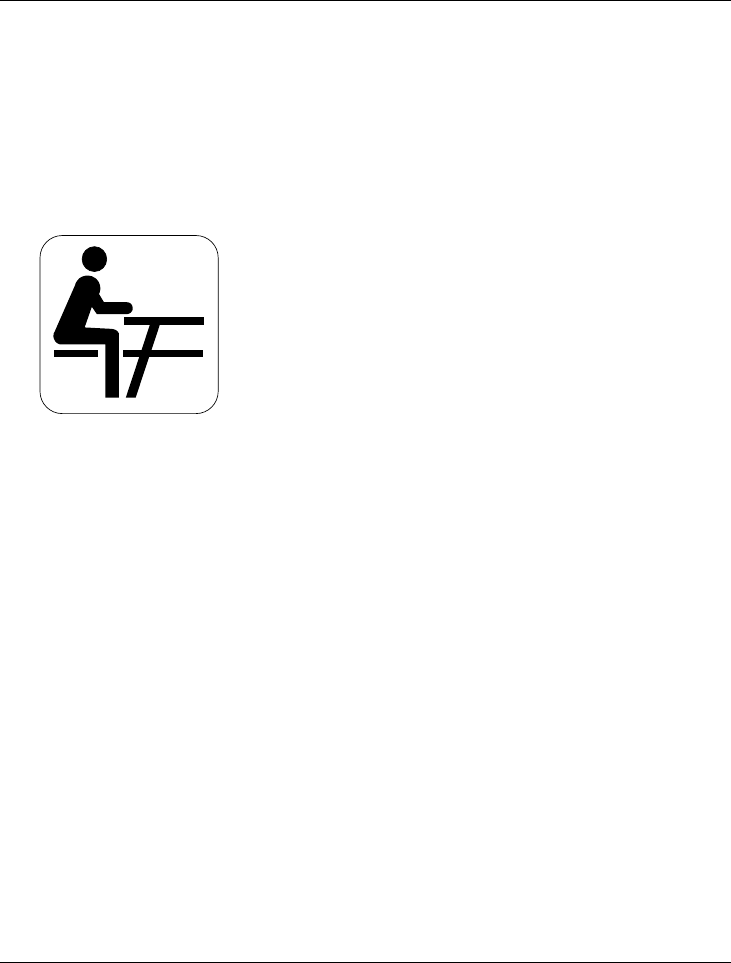
Notebook User Guide
10
About Your Notebook Computer
Congratulations for having purchased your new Everex
StepNote. This computer incorporates the latest in notebook
designs with the newest technologies available.
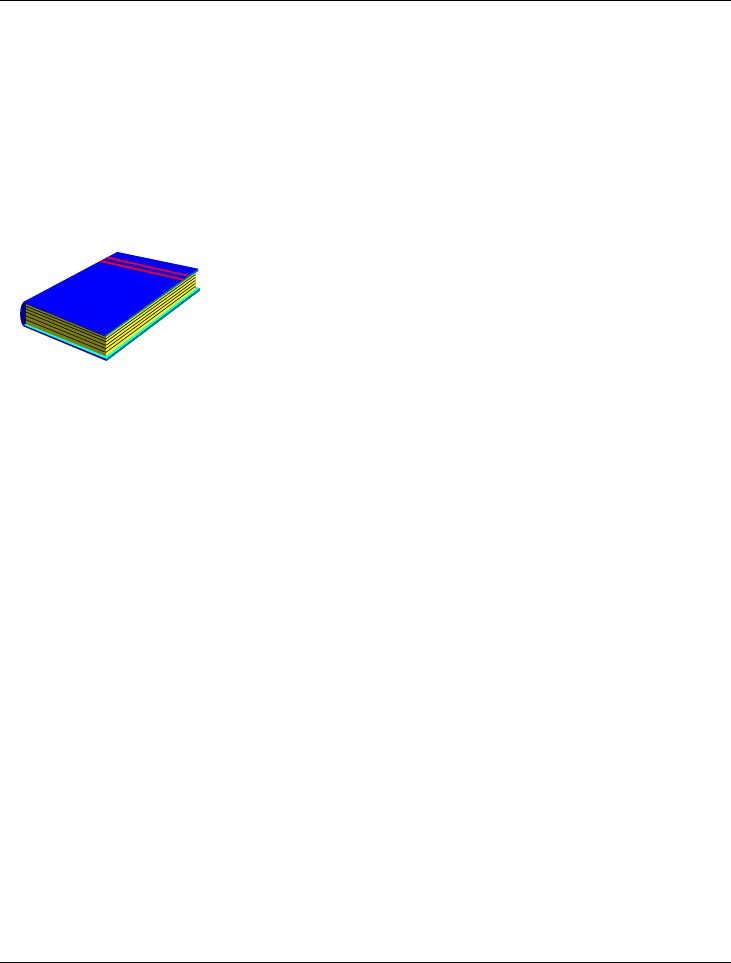
Notebook User Guide
11
About Your User Guide
Welcome to your Everex StepNote User Guide. This manual
introduces you to the basic concepts of your new computer.
Chapter 1 Introduction
Chapter 2 Getting Started
Chapter 3 Using Your Notebook Computer
Chapter 4 Multimedia Setup
Chapter 5 Connecting External devices
Chapter 6 System BIOS Setup
Chapter 7 Upgrade Options
Chapter 8 Care and Maintenance
Appendix A System Specifications and Norton Installation
Appendix B System Recovery, Driver and Norton Installation

Notebook User Guide
12
Table of Contents
ABOUT YOUR NOTEBOOK COMPUTER.......................................... 2
ABOUT YOUR USER GUIDE............................................................... 11
1 INTRODUCTION............................................................................. 17
1.1 FEATURE HIGHLIGHT .................................................................... 18
1.2 UNPACKING THE COMPUTER ......................................................... 20
1.3 THE INSIDE OF THE NOTEBOOK ..................................................... 20
Notebook Status Icons .................................................................. 23
1.4 THE FRONT SIDE OF THE NOTEBOOK............................................. 25
1.5 THE REAR SIDE OF THE NOTEBOOK............................................... 25
1.6 THE LEFT SIDE OF THE NOTEBOOK................................................ 27
1.7 THE RIGHT SIDE OF THE NOTEBOOK ............................................. 28
1.8 THE UNDERSIDE OF THE NOTEBOOK ............................................. 29
1.9 NOTEBOOK ACCESSORIES.............................................................. 32
1.10 NOTEBOOK OPTIONS ..................................................................... 33
2 GETTING STARTED ...................................................................... 35
2.1 USING THE BATTERY PACK ........................................................... 36
Extending Battery Life.................................................................. 38
2.2 CONNECTING THE AC POWER SOURCE.......................................... 39
2.3 STARTING YOUR COMPUTER......................................................... 40
2.4 ADJUSTING THE DISPLAY CONTROLS ............................................ 42
2.5 TURNING OFF YOUR COMPUTER.................................................... 42
3 USING YOUR NOTEBOOK........................................................... 43
3.1 STARTING YOUR OPERATING SYSTEM .......................................... 44
3.2 UNDERSTANDING THE KEYBOARD FUNCTIONS ............................. 44
Basic Keyboard Functions ........................................................... 47

Notebook User Guide
13
Cursor Control Keys..................................................................... 48
Screen Control Keys..................................................................... 49
Windows Hot Keys........................................................................ 49
Special Function Keys .................................................................. 49
3.3 USING THE TOUCHPAD POINTING DEVICE....................................... 50
3.4 CONFIGURING YOUR SCREEN DISPLAY ......................................... 52
Possible Display Configurations.................................................. 53
Changing the Display Properties under Windows.................................. 53
3.5 KNOWING THE POWER SAVING FEATURES .................................... 54
3.6 WORKING WITH THE BUILT-IN HDD............................................... 55
3.7 HOW TO ACCESS THE OPTICAL DRIVE........................................... 56
4 FUN WITH MULTIMEDIA .................................................................. 59
4.1 NOTEBOOK MULTIMEDIA FEATURES ............................................. 60
4.2 AUDIO SOUND SYSTEM FEATURES ................................................ 60
4.3 SETTING UP THE AUDIO DRIVER PROPERTIES ................................ 61
4.4 WINDOWS MULTIMEDIA PROGRAMS ............................................. 61
4.5 RECORDING SOUNDS ..................................................................... 62
Using an External Microphone .................................................... 65
Using the Built-in Optical Drive .................................................. 65
4.6 PLAYING AUDIO AND SOUND ........................................................ 66
Using the Windows Media Player ................................................ 67
4.7 PLAYING VIDEO AND MPEG FILES ............................................... 67
4.8 USING DVD .................................................................................. 68
5 CONNECTING TO PERIPHERALS............................................. 71
5.1 USING THE USB PORT ................................................................... 72
5.2 USING AN EXTERNAL MONITOR PORT .................................................. 73
5.3 USING THE EXTERNAL AUDIO SYSTEM.......................................... 74
5.4 USING THE LAN PORT................................................................... 75
5.5 USING THE WIRELESS LAN........................................................... 76

Notebook User Guide
14
5.6 USING THE MODEM PORT.............................................................. 76
6 CUSTOMIZING YOUR NOTEBOOK.............................................. 79
6.1 RUNNING THE BIOS SETUP PROGRAM .......................................... 80
6.2 USING THE MAIN MENU SETUP ..................................................... 82
6.2.1 Internal HDD Sub-Menu................................................... 84
6.2.2 Internal Optical Drive Sub-Menu...................................... 85
6.3 USING THE ADVANCED CMOS SETUP........................................... 87
6.4 SECURITY MENU SETUP ................................................................ 89
6.5 USING THE BOOT SETUP................................................................ 91
6.6 HOW TO EXIT THE SETUP PROGRAM.............................................. 92
6.7 HOW TO UPGRADE THE BIOS........................................................ 93
7 USING OPTIONS............................................................................. 95
SYSTEM UPGRADE................................................................................... 96
7.1 MEMORY UPGRADE....................................................................... 96
Installing a Memory Module........................................................ 97
7.2 HARD DISK UPGRADE ................................................................... 98
7.3 WIRELESS MODULE INSTALLATION............................................. 100
8 CARING FOR YOUR NOTEBOOK............................................ 101
8.1 IMPORTANT SAFETY INSTRUCTIONS ............................................ 102
8.2 CLEANING YOUR COMPUTER ...................................................... 104
8.3 MAINTAINING THE LCD QUALITY .............................................. 105
8.4 MAINTAINING YOUR HARD DISK ................................................ 105
8.5 BATTERY CARE GUIDELINES....................................................... 106
8.6 WHEN YOU TRAVEL.................................................................... 107
APPENDIX A SYSTEM SPECIFICATION...................................... 109
SYSTEM SPECIFICATION ........................................................................ 110
Processor Unit............................................................................ 110
System Memory........................................................................... 110

Notebook User Guide
15
LCD Display............................................................................... 110
VGA System ................................................................................ 110
Storage........................................................................................ 111
Audio System .............................................................................. 111
Touchpad .................................................................................... 111
Keyboard .................................................................................... 111
Flash BIOS ................................................................................. 112
I/O Ports ..................................................................................... 112
Wireless devices.......................................................................... 112
AC/DC Power Supply Adapter ................................................... 112
Battery ........................................................................................ 112
Weight and Dimension ............................................................... 112
APPENDIX B SYSTEM RECOVERY, DRIVER AND NORTON
INSTALLATION................................................................................... 113
SYSTEM RECOVERY............................................................................... 114
DEVICE DRIVERS INSTALLATION........................................................... 117
Installing Windows XP from Optical Disk Drive ....................... 117
driver installation note:.............................................................. 118
Installing the Chipset Driver...................................................... 118
Installing the VGA Device Driver .............................................. 118
Installing the Audio Device Driver............................................. 119
Installing the Modem Device Driver.......................................... 119
Installing ENE - Keyboard Controller driver ............................ 120
Installing the Wireless LAN Device Driver................................ 120
Installing the LAN Device Driver............................................... 121
NORTON INSTALLATION ........................................................................ 121
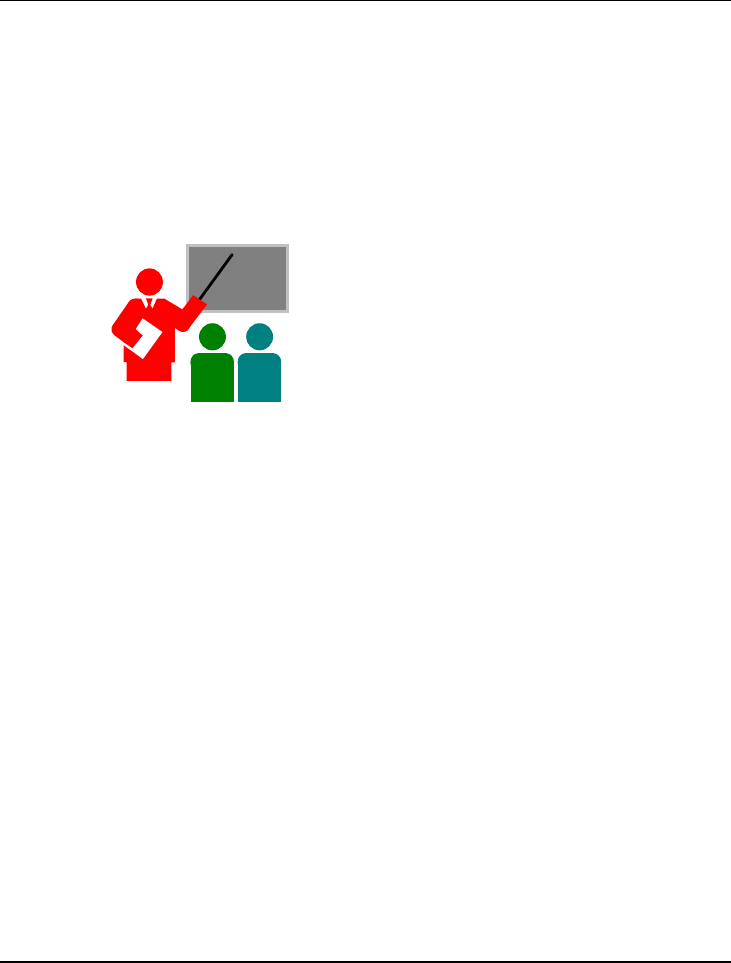
Introduction1
17
1 Introduction
Your Everex Computer is a fully Windows®
compatible portable computer. With the latest
features in mobile computing and multimedia
technology, this notebook is a natural choice for uses
seeking portability and performance.
Your Everex StepNote N Series Notebook runs a
wide variety of business, personal productivity,
entertainment and professional applications and is
ideal for use in the office, home and on the road.

Notebook User Guide
18
1.1 Feature Highlight
Before we identify each part of your Everex StepNote Notebook, we will first
introduce you to other notable features of your computer.
Processing Unit
• Your notebook runs on Intel® Celeron® M Dothan microprocessor that
is integrated with 1MB L2 Cache. Check with your dealer on the CPU
type and speed.
• Fully compatible with an entire library of PC software based on operating
systems such as Windows XP.
Memory
This notebook provides two memory slots for installing DDRII SDRAM 200-
pin SODIMM modules up to 2GB using 256MB, 512MB or 1024MB DDRII
SDRAM modules.
Wide Screen LCD Display
Provides extraordinary 15.4"1280 x 800 (16:10) wide screen LCD display. It is
the best choice for you to watch DVD movie.
Wireless LAN
IEEE 802.11b/g, Mini PCI Module (BTO)
Optical Drive
Provides the DVD Dual or DVD/CD-RW Combo.

Introduction1
19
USB 2.0
Provides three USB2.0 ports for fastest I/O data transmission.
Graphic System
Provides blazing graphics controller embedded in VIA VN800 chipset
PCI Local Bus Architecture
• 32-bit PCI Enhanced IDE optimizes the data transfer between the CPU
and PATA hard disk drives. Support ultra DMA ATA-133 PIO Mode up
to PIO Mode 4, bus mastering for LBA Scheme.
Audio System
Full-duplex 16-bit stereo audio system output. Sound Blaster compatible.
Flash BIOS
Flash BIOS allows you to easily upgrade the System BIOS using the Phoenix
Flash utility program.
Power and System Management
• Integrated SMM (System Management Mode) on system chipset that shuts
down components not in use to reduce power consumption. To execute
power management, you can set up the parameter in Power Options
properties by pointing your mouse to Control Panel of Windows.
• Closing the Notebook computer (lowering the cover) allows you to
suspend the system operation instantly and resume at the press of the
power button.
• System Password for User and Supervisor included on the BIOS SETUP
Program to protect unauthorized use of your computer.

Notebook User Guide
20
1.2 Unpacking the Computer
Your computer comes securely packaged in a sturdy cardboard shipping
carton. Upon receiving your computer, open the carton and carefully remove
the contents. In addition to this User Guide, the shipping carton should also
contain the following items:
; The Notebook Computer
; An AC Adapter and AC Power Cord
; Li-Ion Battery Pack
; CD with Driver Utility and User Guide
Carefully inspect each component to make sure that nothing is missing and/or
damaged. If any of these items is missing or damaged, contact Everex (see
Page 120). Be sure to save the shipping materials and carton in case you need
to ship the computer or store for an extended period of time.
1.3 The Inside of the Notebook
The notebook computer is compact with features on every side. First, look
at the inside of the system. The following sections describe inside features.
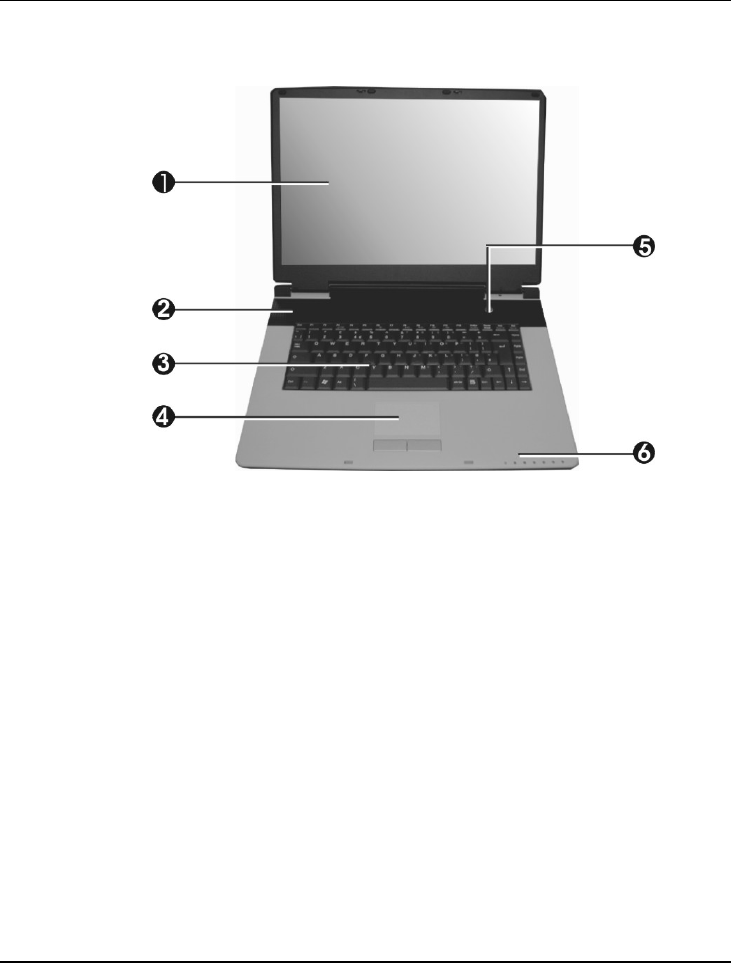
Introduction1
21
1. Color Widescreen LCD Display 2. Built-in Stereo Speaker
3. Keyboard 4. Touchpad Pointing Device
5. Power On/Resume Button 6. LED Indicators
• Color Widescreen LCD Display
The notebook computer comes with a color LCD that you can adjust for a
comfortable viewing position. The LCD is 15.4” TFT color LCD with
1280x800 (Wide XGA with ratio 16:10) resolution panels. The features of
the Color LCD Display are summarized as follows:
TFT color LCD with Widescreen 15.4” 1280x800 (Wide XGA)
resolution panels.
Capable of displaying 16M colors (32-bit true color).
LCD display control hot-keys allows you to adjust the brightness of
the LCD.

Notebook User Guide
22
Simultaneous display capability for LCD and external desktop
computer monitor.
• Built-in Stereo Speaker
Integrated mini stereo speaker provides sound and audio output for your
multimedia presentations or listening pleasure.
• Keyboard
Standard QWERTY-key layout and full-sized 87 keys keyboard with
Windows system hot-keys, embedded numeric keypad, 6 hot keys,
inverted "T" cursor arrow keys, and separate page screen control
keys.
Wide extra space below the keyboard panel for your wrist or palm to
sit-on comfortably during typing.
• Touchpad Pointing Device
Microsoft mouse compatible with two Touchpad click buttons. The two
select buttons located at each side support tapping selection and dragging
functions. These buttons work like a standard computer mouse. Simply
move your fingertip over the Touchpad to control the position of the
cursor. Use the selection buttons below the Touchpad to select menu
items.
• Power On/Resume Button
Switches the computer power on and off, or resumes whenever it is in
Suspend mode.
• LED Indicators
Keeps you informed of your notebook computer’s current power status
and operating status. Description of the status icons appears in the latter
part of this section.
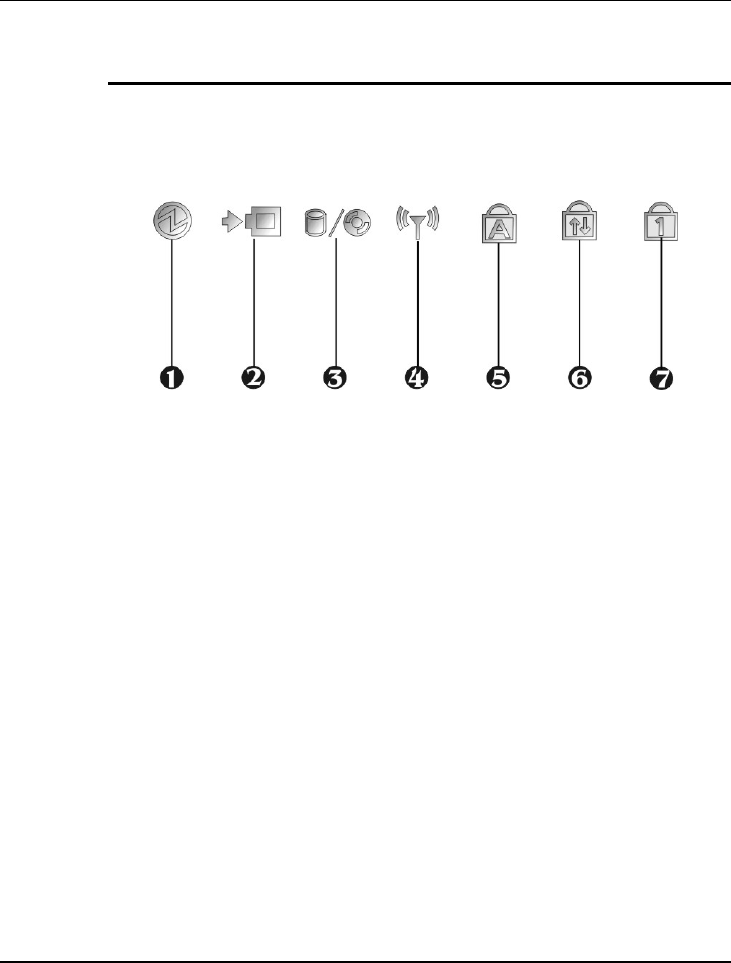
Introduction1
23
NOTEBOOK STATUS ICONS
The Status LED Panel keeps you informed of the notebook’s current power
and operating status. Each LED is marked with an icon to designate the
system status.
1. Power Indicator 2. Battery Charging LED
3. Drive Access 4. Wireless LAN Access
5. Caps Lock 6. Scroll Lock
7. Num Lock
• Power Indicator
Lets you know that power to the system is turned on. This LED is
positioned so that you can see the power state whether the LCD panel is
opened or closed.
Lights green when the system is powered on.
Lights green blinking when the system is in Standby mode.
Lights yellow when the battery power is low.
Lights orange when the battery power is critical low.
• Battery Charging LED
Lights to indicate battery in charging status.

Notebook User Guide
24
Lights orange to indicate that the battery is in charging.
When the light is off, it indicates the battery is fully charged or no
battery installed.
• Drive Access
When LED turns on indicates that the system is accessing the Hard Disk
or Optical Disk Drive.
• Wireless LAN Access
When LED turns on indicates that the wireless LAN module is activated.
When LED lights off, it indicates that the function is disabled.
• Caps Lock
When LED turns on indicates that the Caps Lock key on the keyboard is
activated. When activated, all alphabet keys typed in will be in uppercase
or capital letters.
• Scroll Lock
When LED turns on indicates that the Scroll Lock key on the keyboard is
activated. The Scroll Lock key has different functions depending on the
software you are using.
• Num Lock
When LED turns on indicates that the Num Lock key on the keyboard is
activated. When activated, the embedded numeric keypad will be enabled.
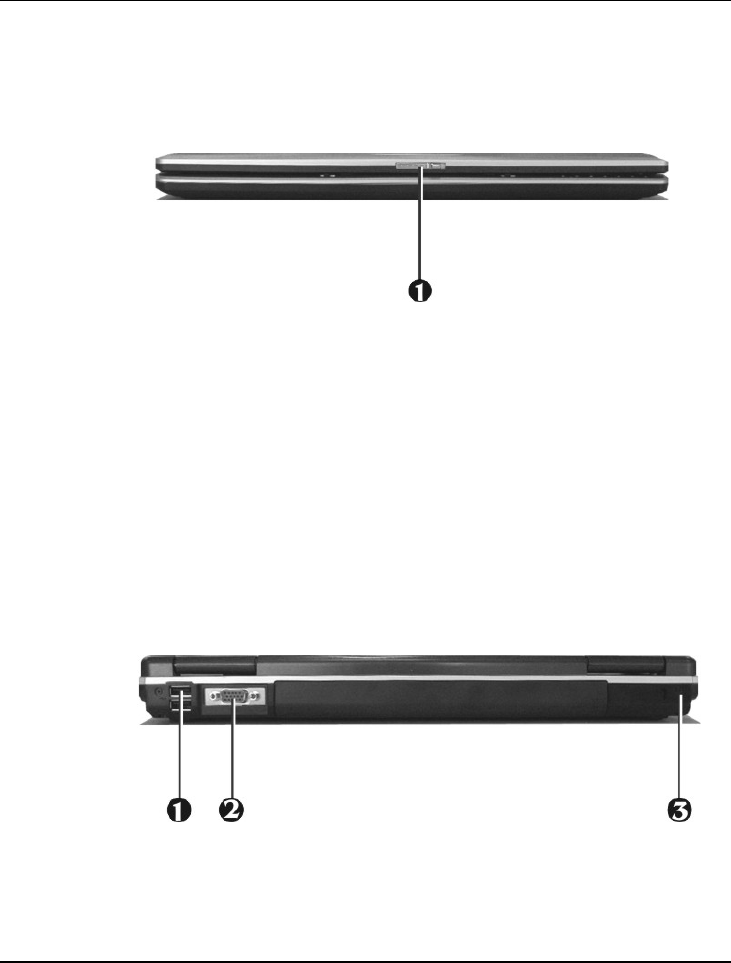
Introduction1
25
1.4 The Front Side of the Notebook
1. Cover Switch
• Cover Switch
The cover (LCD panel) is locked when it is closed. Slide the button right
aside to release the latch for opening the cover of the computer.
1.5 The Rear Side of the Notebook
The system ports at the back of your notebook computer can connect various
devices. Each port is described in detail:
1. USB 2.0 Ports 2. VGA Port 3.Kensington Lock Hole

Notebook User Guide
26
• USB 2.0 Ports
The Universal Serial Bus (USB) port allows you to connect USB 2.0-
compliant devices (for example, printers, scanners and so on) to your
notebook computer.
• VGA Port
Lets you attach an external monitor or projector for wider display. You
can run the LCD display and the external monitor simultaneously or
switch it to monitor only using the display hot-key.
• Locking Device Keyhole
Lets you attach a Kensington security system or a compatible lock to
physically secure your notebook computer.
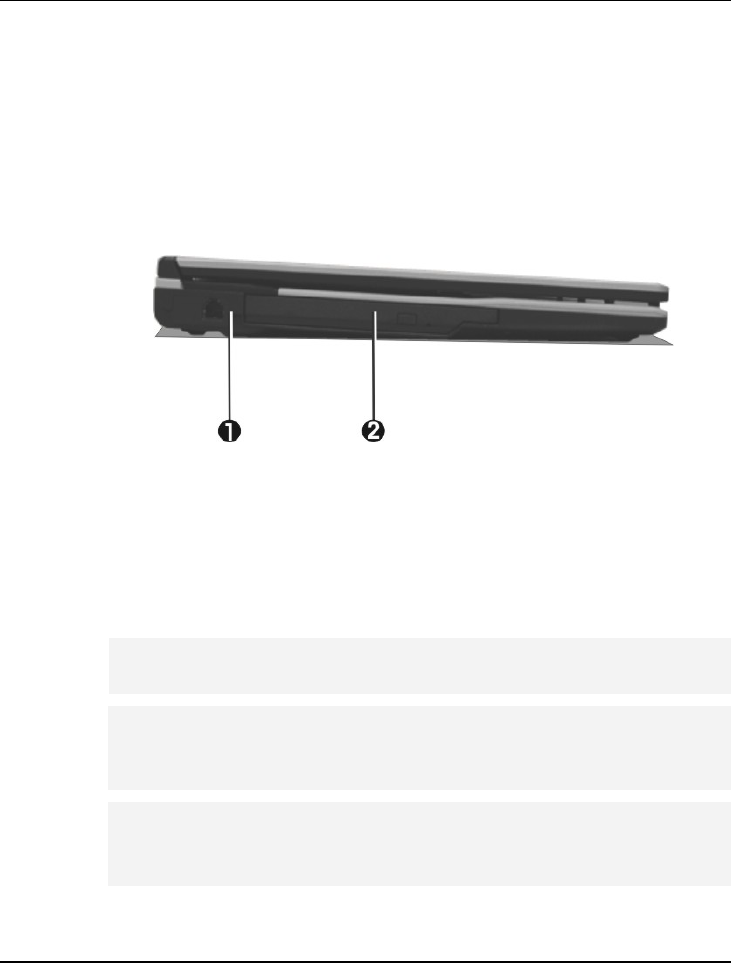
Introduction1
27
1.6 The Left Side of the Notebook
The left side of your notebook computer provides the features shown in the
following figure.
1. Modem Port 2. Optical Disk Drive
• Modem Port
A 56K internal fax/data modem is installed. It keeps you connected to the
outside world through phone line.
For electrical safety concerns, only use telephone cables rated 26AWG or
higher.
When using your telephone equipment, basic safety precautions should always
be followed to reduce the risk of fire, electric shock and injury to persons,
including the following:
1.
Do not use this product near water, for example, near a bath tub, wash
bowl, kitchen sink or laundry tub, in a wet basement or near a swimming
pool.
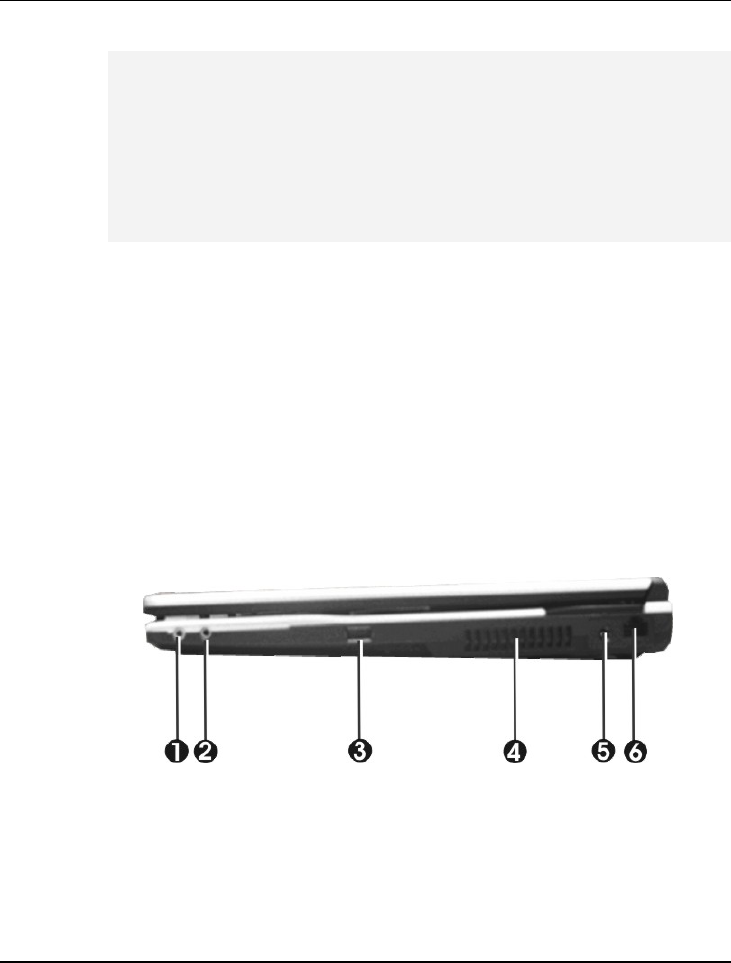
Notebook User Guide
28
2.
Avoid using a telephone (other than a cordless type) during an electrical
storm. There may be a remote risk of electric shock from lightning.
3.
Do not use the telephone to report a gas leak in the vicinity of the leak.
4.
Use only the power cord and batteries indicated in this manual. Do not
dispose of batteries in a fire. They may explode. Check with local codes for
possible special disposal instructions.
• Optical Disk Drive
Allows you to load and start programs from a compact disc (CD) or a
digital video disc (DVD) and play conventional audio CDs. It also can
make CD/DVD by using CD-R/RW or DVD-R/RW.
1.7 The Right Side of the Notebook
The right side of the notebook computer offers the features shown in the
following figure.
1. Microphone Jack 2. Headphone Jack
3. USB 2.0 Port 4. Air-Outlet Vent
5. DC Power Port 6. LAN Port

Introduction1
29
Right Side Features
• Microphone Jack
Allows you to connect an external microphone for monophonic sound
recording directly into your notebook computer.
• Headphone Jack (with SPDIF out)
Lets you plug in a stereo headphone, powered speaker, or earphone set
with 1/8 inch phono plug for personal listening. (The SPDIF transmits
digitized audio signal by optical fiber. The external audio amplifier can get
the best audio quality without loss.)
• USB 2.0 Port
The Universal Serial Bus (USB) port allows you to connect USB 2.0-
compliant devices (for example, printers, scanners and so on) to your
notebook computer.
• Air-Outlet Vent
Emits the heat out of your computer and keeps it within operating
temperature.
• DC Power Port
Lets you connect the AC power adapter in supplying continuous power to
your notebook and recharging the battery.
• LAN Port
An internal 10Base-T/100Base-TX Ethernet LAN module connects your
computer to other computers/networks through a local area network
(LAN).
1.8 The Underside of the Notebook
The bottom of the notebook computer offers the following features.
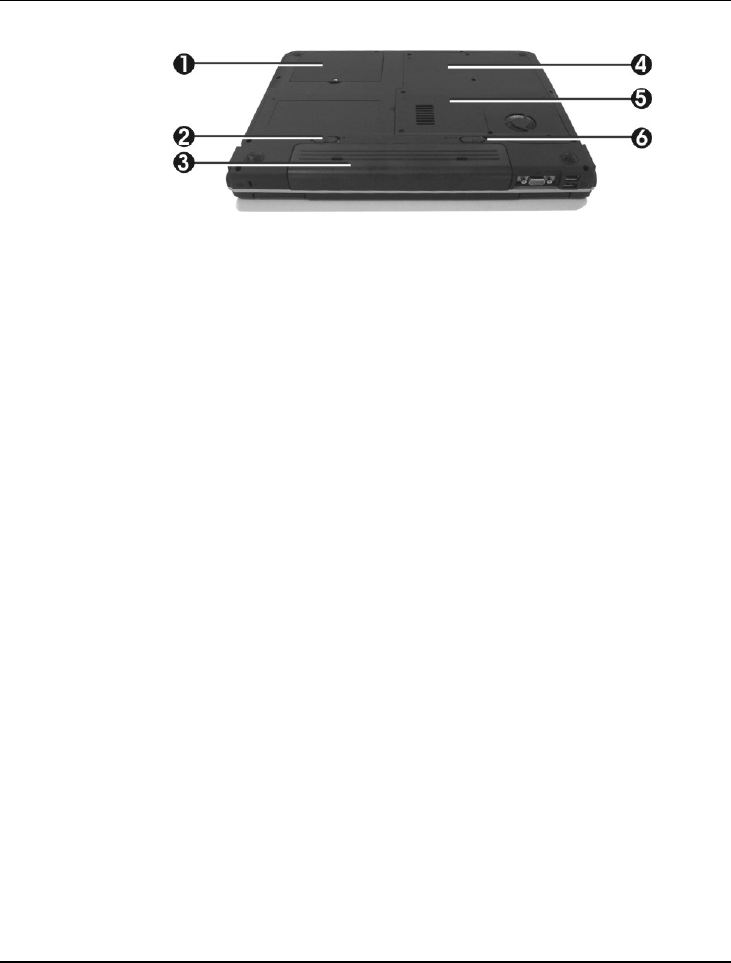
Notebook User Guide
30
1. Hard Disk Compartment 2. Battery Lock Latch
3. Battery Bay 4. Wireless LAN Compartment
5. Memory Compartment 6. Battery Release Latch
Bottom of the System
• Hard Disk Compartment
Open this cover of this compartment to replace with other Hard Disk
Drive. Please refer to Chapter 7 for how to replace it.
• Battery Lock Latch
Push the latch to the right side to lock and secure the battery. This action
is available to release the battery when the battery lock latch has located to
unlock status at the left side.
• Battery Bay
Equipped with a choice of Lithium-Ion (Li-Ion) battery pack.
• Wireless LAN Compartment
This compartment is for installing Wireless LAN module to enable the
Wireless LAN function. We strongly suggest that Wireless LAN module
should be installed only by certified dealer.
• Memory Compartment
There are two SO-DIMM memory slots in the bottom side.

Introduction1
31
• Battery Release Latch
To release the battery, first locate the Battery Lock Latch at the left side in
unlock status, then push the Battery Release Latch to the right end to
remove the battery pack.

Notebook User Guide
32
1.9 Notebook Accessories
AC Adapter
The AC Adapter supplies external power to your notebook computer and
charges the internal battery pack simultaneously. The AC adapter has an auto-
switching design that can connect to any 100VAC ~ 240VAC power outlets.
Change the power cord if you are going to use your notebook in countries with
different connector outlets.
When you connect the AC adapter, it charges the battery whether or not the
notebook computer is powered on.
Battery Pack
Aside from the AC adapter, your computer can also be powered through the
internal battery pack. The battery pack uses rechargeable Lithium-Ion (Li-Ion)
battery cells that provide long computing hours when fully charged and power
management enabled. You should always leave the battery inside your
computer even when using the AC adapter as it also acts as a back-up power
supply in case power from the AC adapter is cut off. It is also very important
to have the battery pack always charged to prevent battery cell degradation.

Introduction1
33
1.10 Notebook Options
DVD/CD-RW Combo Device Pack
This device pack can write data to CD-R or CD-RW CD for you to backup the
data and also can read DVD/CD title.
DVD dual (Dual Rewritable DVD combo) Device Pack
This device pack combines following two standard packs. Using the suitable
media, you can make any format of CD or DVD as you want.
DVD-RW combo:
This device pack can write data to CD-R or CD-RW and DVD-R or DVD-
RW media and also can read DVD/CD title. This media is commonly used on
DVD video player.
DVD+RW combo:
This device pack can write data to CD-R or CD-RW and DVD+R or
DVD+RW media for you to backup the data and also can read DVD/CD
title. This media is commonly used on newer DVD video player.

Getting Started 2
35
2 Getting Started
Your Notebook is designed and pre-configured for
easy setup and use. This chapter describes the
installation steps you should follow to get the
notebook up and running as quickly as possible.

Notebook User Guide
36
2.1 Using the Battery Pack
The notebook is designed to operate with one of the following power sources:
• With AC power using the AC adapter connected to an electrical outlet.
• With a Lithium-Ion (Li-Ion) battery pack.
You should use the AC adapter whenever it is possible, relying on the battery
pack only when AC power is unavailable.
Before you use your notebook computer, install and recharge the battery pack
first. The rechargeable Li-Ion battery pack allows you to operate the notebook
without an external power source. When you connect the AC power adapter,
the battery immediately starts to recharge. For maximum battery performance,
fully discharge the battery before recharging it the first time. To do so, unplug
the AC adapter, turn off power management features (through Setup and
Windows), and turn on the system. Once the battery is fully discharged, plug in
the AC adapter and recharge the battery.
If you do not discharge the battery completely, it fails to accept a full recharge.
Li-Ion battery is vulnerable, do not charge it with other power adapter, or it
may cause fire or explosion.
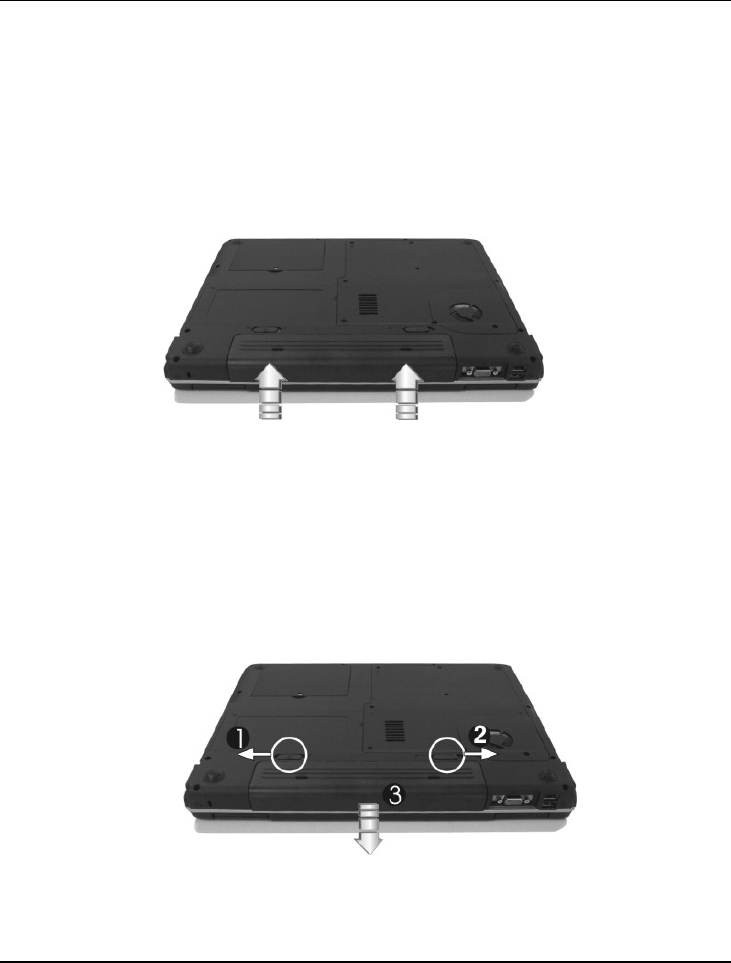
Getting Started 2
37
Installing the Battery Pack
This notebook provides the most convenient way to install the battery pack
into your computer. With the extended nose directed toward the
compartment, insert and push the battery pack.
Removing the Battery Pack
To remove the battery pack, slide the lock latch to the end of left side to
unlock the battery lock latch (1), then slide the battery release latch to the end
of right side to release the battery latch (2), and take out the battery pack with
your finger (3) simultaneously.

Notebook User Guide
38
Replacing the Battery Pack
When your notebook estimates that the battery only has enough charge to
continue for a few minutes, it will alert you with a battery low warning beep. If
you are consuming a lot of power by using the audio system, the hard disk
drives, and optical disk drive, your notebook might run out of charge much
sooner than you expect. You should always respond to the battery low
indication by connecting to AC power or turning off your notebook, or
suspending your notebook to disk. If you do not do so, the notebook will
automatically suspend to disk and turn off. The contents of the memory will
store in the hard disk drive. You will be unable to restart the notebook until
you have connected to the AC adapter or installed a charged battery. To
replace the battery pack, refer to the previous sections on "Installing the
Battery Pack" and "Removing the Battery Pack."
For Window XP, the suspend mode (Hibernate or Standby) can be chosen
at Power Options of Windows's Control Panel)
Be sure to save your data before replacing the battery pack or connecting
the AC adapter. Failure to do so can result in data loss.
EXTENDING BATTERY LIFE
It is important to be aware of the simple things for extending the life of the
system main battery while you are on the road. You should find a working
place where the external lighting is not too bright and turn down the screen
brightness. Also, you can choose the available mode on the Power
Management item of the Control Panel in Windows.
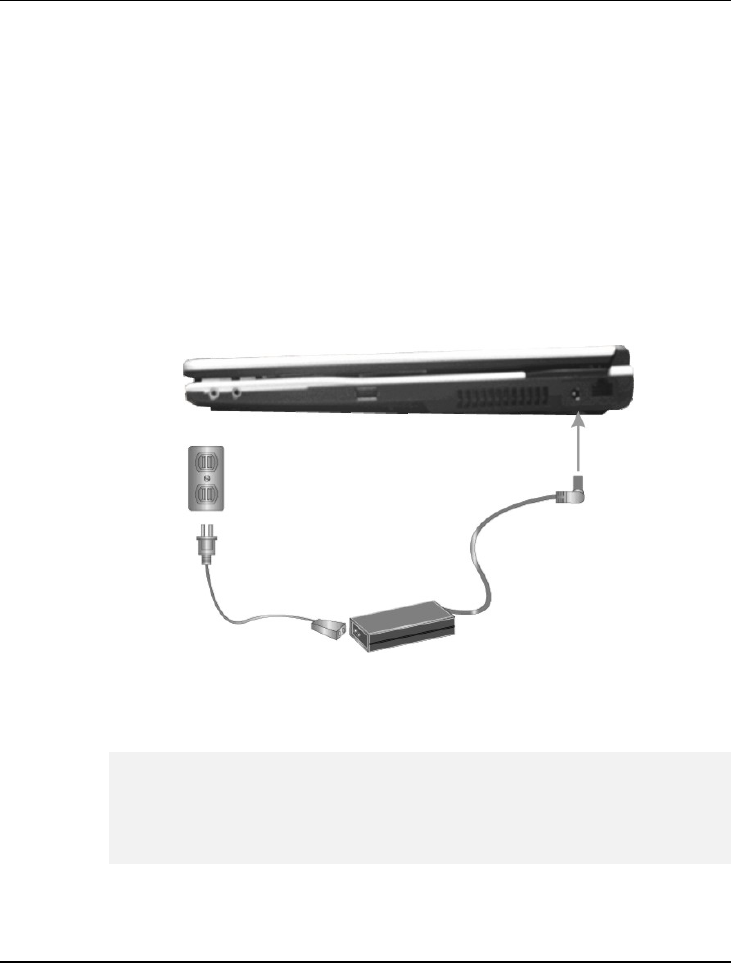
Getting Started 2
39
2.2 Connecting the AC Power Source
The AC adapter provides external power source to your computer and charges
the internal battery pack at the same time. The AC adapter also has an auto-
switching design that can connect to any 100VAC ~ 240VAC power outlets.
To connect the power adapter:
1. Plug the AC power cord into the power socket of the AC power adapter.
2. Plug the other end of the AC power cord to a live AC wall outlet.
3. Plug the connector of the AC adapter to the DC-IN port found at the left
side of the computer.
Whenever possible, it is advisable to always have the AC adapter connected
to the notebook and the battery pack installed. This ensures continuous
power supply and prevents any data loss incurring from sudden power
breakdown.

Notebook User Guide
40
y For the power supply of this equipment, an approved power cord has to
be used.
y Make sure the socket and any extension cord(s) you use can support
the total current load of all the connected devices.
y Before cleaning the computer, make sure it is disconnected from any
external power supplies (i.e. AC adapter).
2.3 Starting Your Computer
The Power/Resume button is found on the top of the base unit. Press the
Power/Resume button to start your computer and check that if the Power
LED turns on.
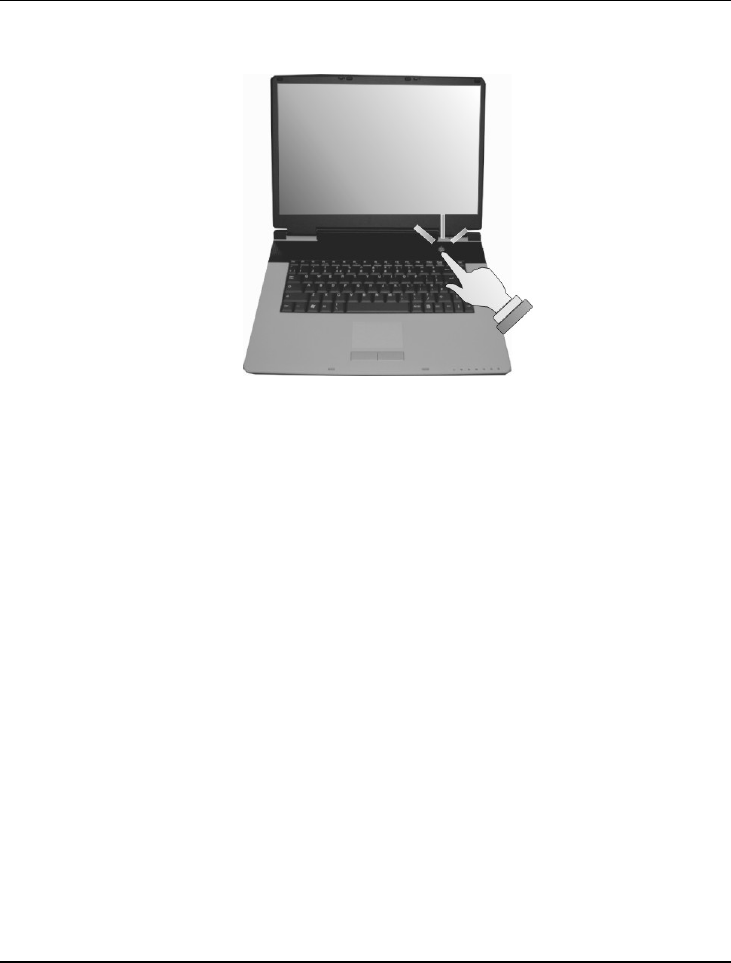
Getting Started 2
41
After a few seconds, the computer’s display will turn on and your computer
will begin to execute the Power On Self Test or POST to check if all system
components are running properly. Any error found during the test will be
displayed on the screen and may generate short beep sound as well.
After the test, the screen will also display a message "press <F2> to enter
SETUP". You don’t need to run this program at the moment as your dealer
already made the necessary settings for your computer optimal operation.
Refer to Chapter 6 on running the SETUP program later.
After the test has completed, your computer will start to search and boot up
the operating system from your hard drive. The notebook computer normally
comes with a Windows operating system pre-installed in your hard drive.
Consult the Windows manual on how to use the program. If not, contact your
dealer for assistance.

Notebook User Guide
42
2.4 Adjusting the Display Controls
The LCD brightness adjustment is controlled by <Fn> +<F8> and <Fn> +
<F9> keys respectively. You need to press these hot-key controls after
powering on your notebook to suit your viewing pleasure.
The Brightness hot-key control adjusts the brightness on the LCD. The
brightness hot-key control will not set the LCD completely dark or bright; it
provides sufficient lighting to the LCD to match the external lighting of the
surrounding. The brighter the room, the more you need to increase the
brightness of the LCD.
2.5 Turning off Your Computer
If you are not going to use the computer for a while, it is best to turn off the
power of the computer. Before turning off the power, you need to first close
all application programs and shut down the operating system.
After turning off the computer, make it a habit to leave the LCD panel open
for a while whenever used for an extended period of time. This allows the
inside parts of the computer to cool off. Closing the panel will force the heat
up against the LCD screen, which may degrade the LCD when done regularly.
More importantly, never close the LCD panel for a long period of time when
computer is on and power saving features are disabled.
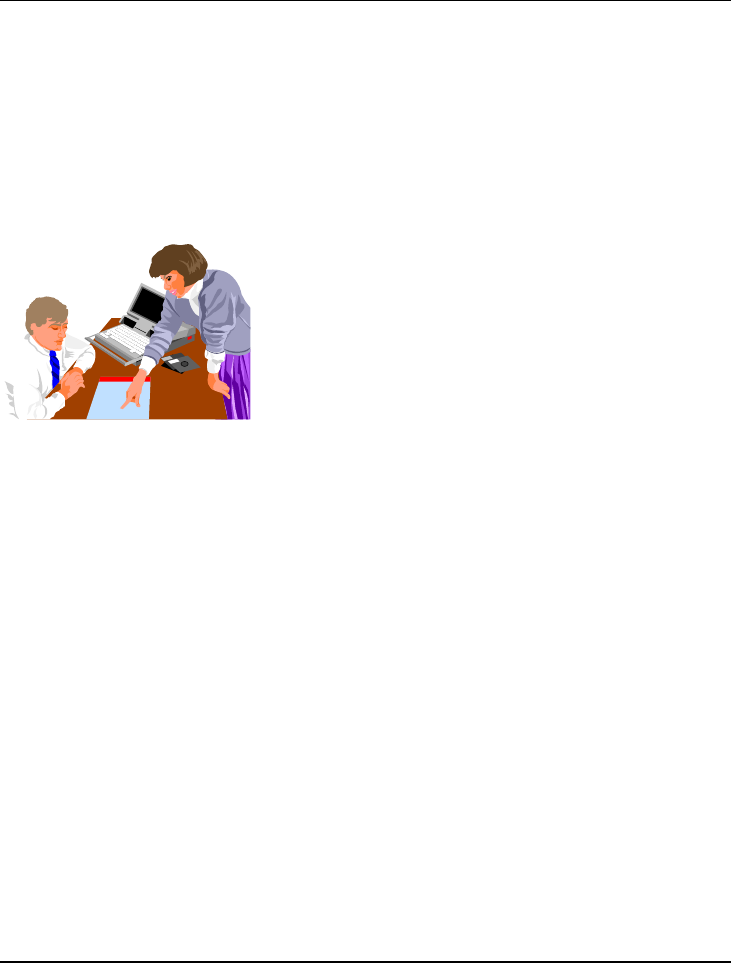
Using Your Notebook 3
43
3 Using Your Notebook
This chapter describes how to operate the standard
built-in features of the Everex StepNote. If you are
unfamiliar with personal computers or the Microsoft®
Windows® operating system, in addition to this chapter,
we recommend reading the Windows® Help and Support
page located on your computer.

Notebook User Guide
44
3.1 Starting Your Operating System
The operating system is the software foundation for your computer. It is the
platform for all your software application programs to run on. The most
popular operating system today is Microsoft® Windows®. The StepNote
computer comes with an operating system pre-installed and needs only to be
setup and configured during initial use.
3.2 Understanding the Keyboard
Functions
Your notebook computer is equipped with an 87 keys keyboard that provides
all the functionality of a full-sized 101 or 102-key keyboard. Aside from the
standard typewriter-layout keyboard of your computer, there are a number of
extra features and function controls on the built-in keyboard including
Windows system hot keys.
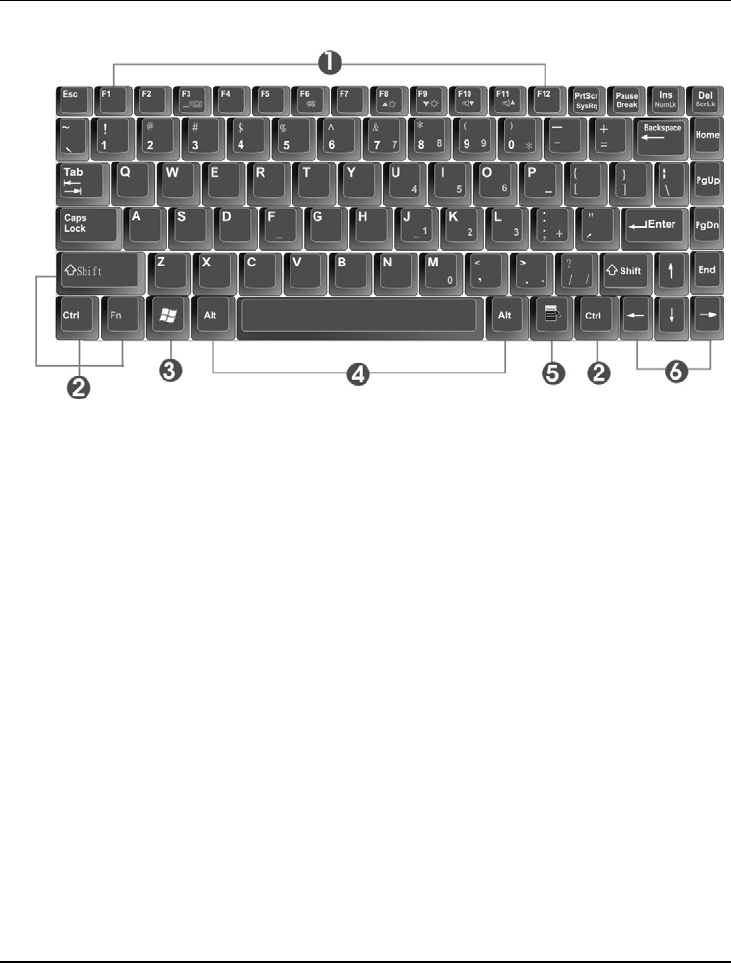
Using Your Notebook 3
45
1. Function Keys 2. Control Keys
3. Windows Start Menu Key 4. Control Keys
5. Windows Shortcut Key 6. Cursor Control Keys
Keyboard
Key features and operations are described below:
• Function Keys
Function keys are application-driven, like F1 through F12 can be found on
the keyboard. These keys work together with the Fn key to activate special
functions. Some keys (printed in blue on keypad) are preprogrammed with
dual functions.
• Control keys — Ctrl, Alt, Fn, and Shift are controls used in conjunction
with other keys to change their functions. To use control keys, press and
hold the control key while pressing another key. For example, "Press Ctrl-
C" means to hold down the Ctrl key and type the letter C. Key
combinations work especially to the application you are running.

Notebook User Guide
46
• Windows keys
Use the following two keys to facilitate your work:
Start Menu key
Displays the Start menu.
Shortcut/Application key
Provides quick access to shortcut menus. This key acts like a right
mouse button.
• Cursor Control keys
Cursor control keys let you position the cursor on the screen where you
want. In the screen, the cursor is a blinking underline, block, or vertical
bar depending on the application. The cursor indicates where the next text
typed is inserted.
• Typewriter keys
Typewriter keys (also called alphanumeric keys) are used to enter text and
characters. Keys with blue print on them behave differently when
combined with control keys.
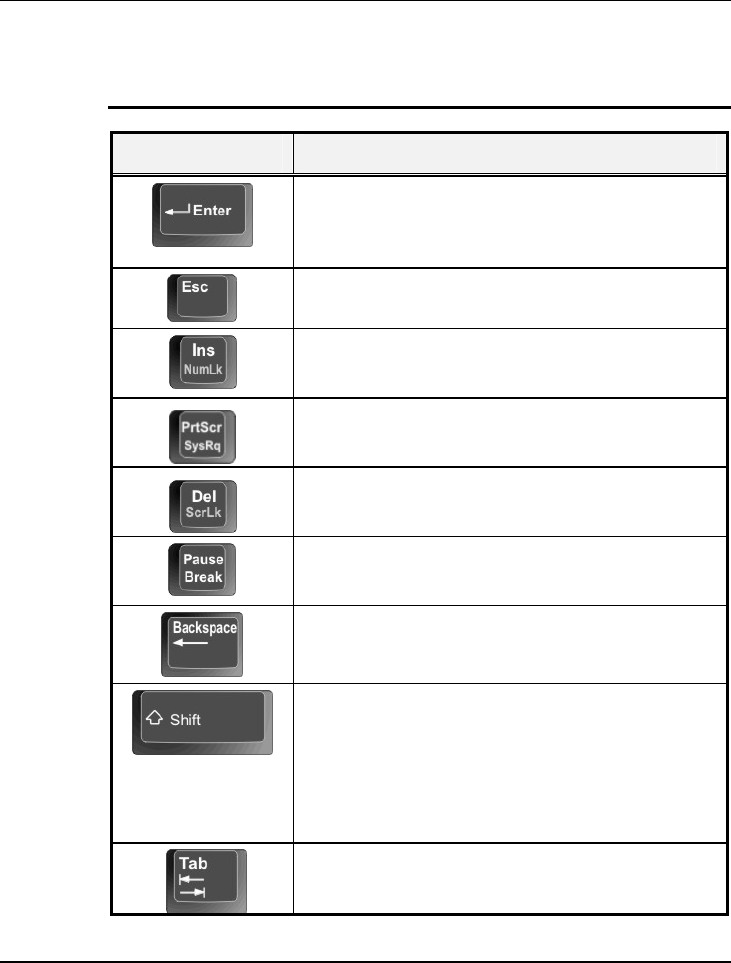
Using Your Notebook 3
47
BASIC KEYBOARD FUNCTIONS
Keypad Function Description
<Enter> key. Execute a command. Within many
text editing application programs, the <Enter> key
inserts a hard carriage return, just like what ordinary
typewriter does.
<Esc> key. Press this key to cancel or escape from
a command or function.
<Ins> key. Known as the Insert key. Press this key
to toggle the keyboard data entry from insert to type
over mode.
<PrtScr> key. Known as the Print Screen key. Press
this key to map the whole screen to share memory for
your specific usage.
<Del> key. Known as the Delete key. Press this key
to delete the character to the right of the cursor, or
delete marked texts or items.
<Pause> key. Press this key to temporarily halt
execution of a command. Pressing any other key to
resume execution of a command.
<Backspace> key. Press this key to delete the
character to the left of the cursor.
<Shift> key. Press this key in combination with
alphabet letters to produce uppercase letters in
typing. Use this key in combination with those two-
character keys (found on the second row of the
keyboard) to produce the upper marked keys. Also
used in most application program in combination
with other keys to execute a certain command.
<Tab> key. Press this key to move the cursor to the
next tab stop on the right. This key works much the
same as in ordinary typewriter.
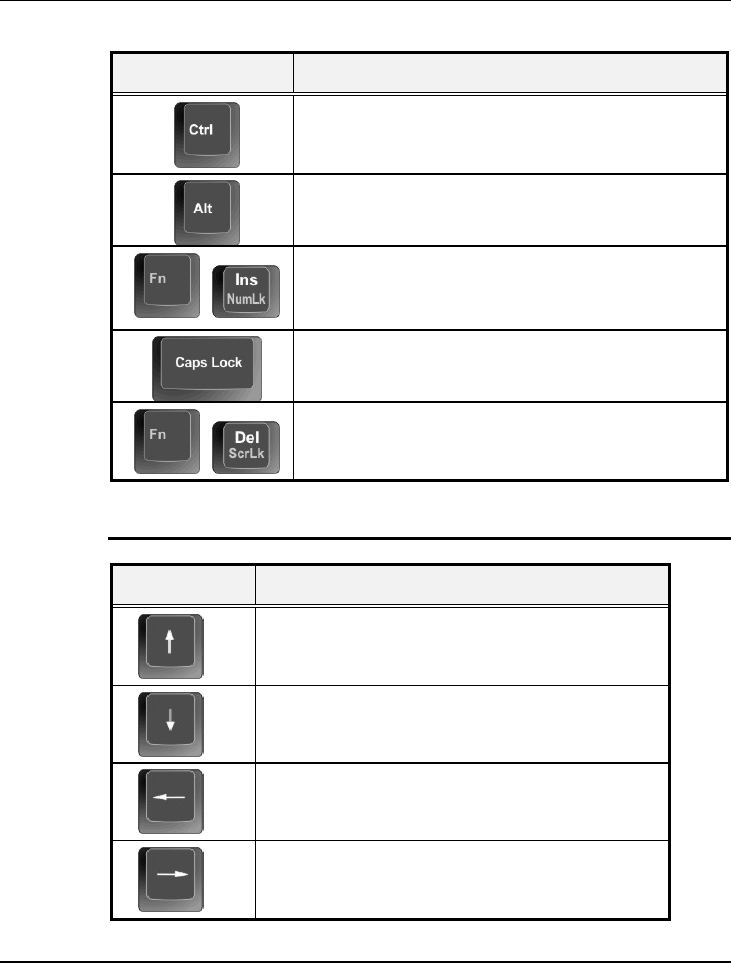
Notebook User Guide
48
Keypad Function Description
<Ctrl> key. Known as the Control key. Used in
most application program in combination with other
keys to execute a certain command.
<Alt> key. Known as the Alternate key. Used in
most application program in combination with other
keys to execute a certain command.
+
<Fn> + <Num Lock> key. Activates the
embedded 15-key numeric keypad. The keys are
color coded blue.
<Caps Lock> key. Used in most application
program to always activate uppercase alphabet
characters.
+
<Fn> + <Scroll Lock> key. Used in most
application program to scroll the screen without
having to move the cursor.
CURSOR CONTROL KEYS
Keypad Function Description
Up arrow key. Moves the cursor up one line at a
time.
Down arrow key. Moves the cursor down one
line at a time.
Left arrow key. Moves the cursor to the left one
space at a time.
Right arrow key. Moves the cursor to the right
one space at a time.
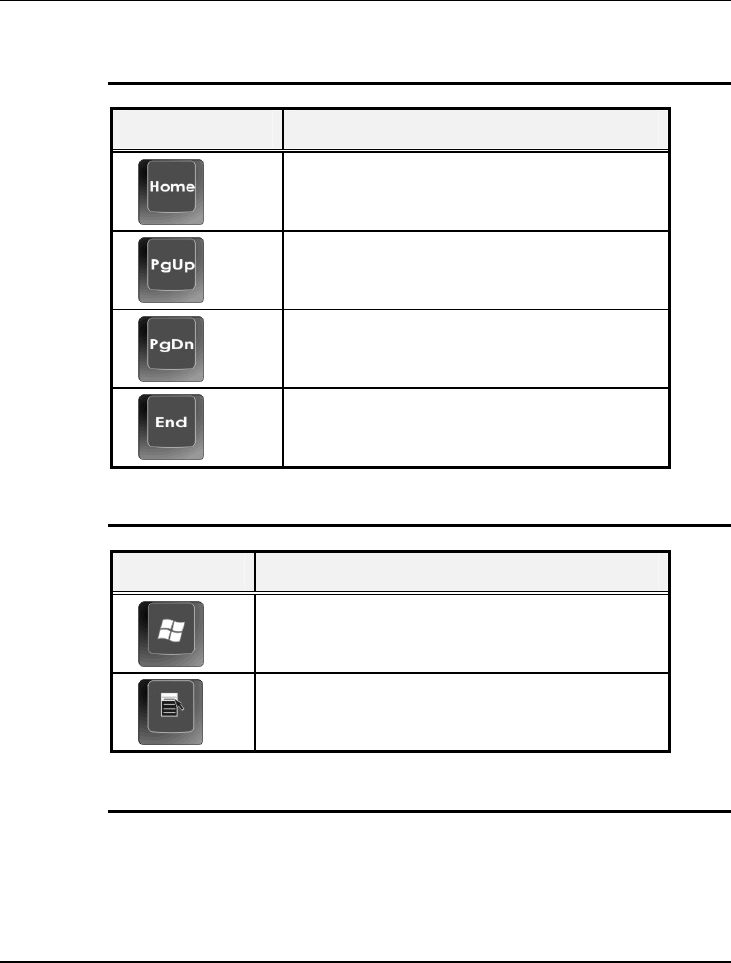
Using Your Notebook 3
49
SCREEN CONTROL KEYS
Keypad Function Description
<Home> key. Moves the cursor to the
beginning of a screen or line.
<PgUp> key. Moves the cursor up one
screen at a time
<PgDn> key. Moves the cursor down one
screen at a time
<End> key. Moves the cursor to the end of a
screen or line.
WINDOWS HOT KEYS
Keypad Function Description
<Start> key. Pulls up the Windows Start menu.
<Right Click> key. Performs a mouse right-click
function for Windows system.
SPECIAL FUNCTION KEYS
The notebook has special system function keys that activate key serving dual
functions. When pressed in conjunction with the <Fn> key, these keys set
specific system parameters and are sometimes referred to as "hot keys".
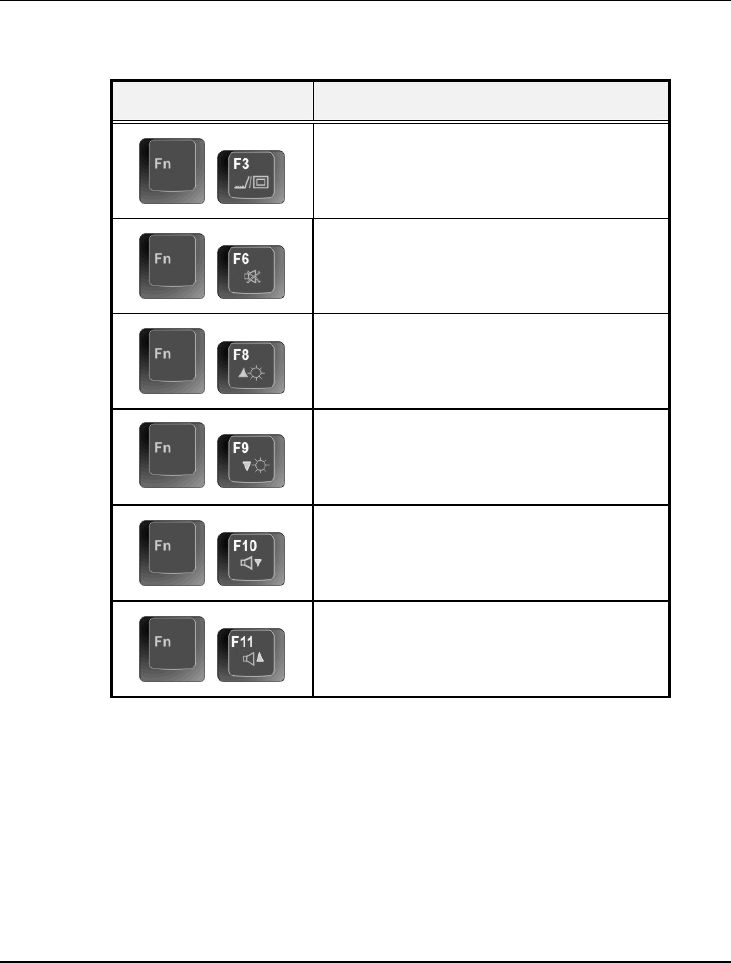
Notebook User Guide
50
Keypad Function Description
+
Switches display between LCD, CRT, or
LCD and CRT simultaneously.
+
To shut down or resume the built-in
system speaker volume.
+
Increases the brightness of LCD display
incrementally.
+
Decreases the brightness of LCD display
incrementally.
+
Decreases the audio volume of the
notebook incrementally.
+
Increases the audio volume of the
notebook incrementally.
3.3 Using the Touchpad Pointing Device
Your computer comes with a built-in Touchpad pointing device that is found
on the center of the palm-rest surface.
The Touchpad offers a number of options that let you customize how it
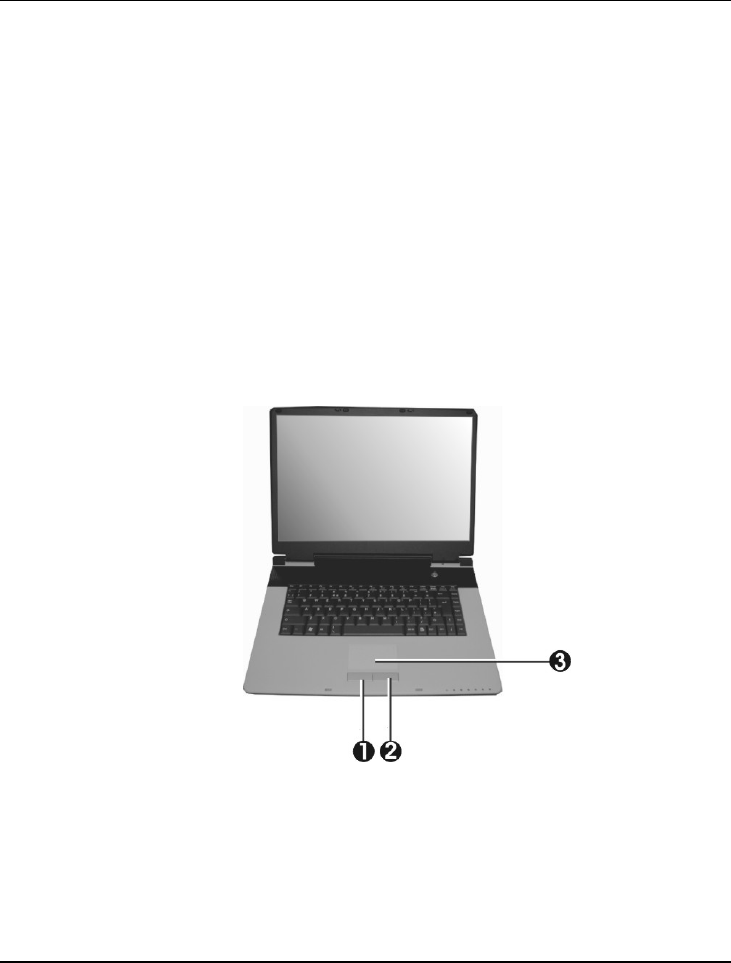
Using Your Notebook 3
51
functions. To access these options, locate the Control Panel and double click
on the Mouse icon. The options let you control the size and color of the
cursor, cursor speed, the accepted double-click speed, and selection button
orientation.
The Touchpad works a mouse pointing device replacement that is used under
Windows-based operating system. You can use the standard Microsoft driver
that is compatible with the Touchpad device and is normally used under
Windows-based operating system. However, if you want to utilize the added
features of the Touchpad, you may want to try installing its own device driver
that comes with added utilities for enhancing the function of the device.
1. Left Selection Button 2. Right Selection Button
3. Touchpad
Touchpad Features

Notebook User Guide
52
Here how to use the Touchpad pointing device:
1. The rectangular surface acts like a miniature duplicate of your display
screen. To move the mouse cursor, place the finger lightly on the sensor
pad and move in the desired direction. If you reach the end of the pad, lift
your finger and place it back down on the other side of the pad.
2. To select an item, click on the item by pressing the left button control or
by simply tapping on the surface once. A light, quick tap always works
best. To execute an item, click the left button twice or do a quick double
tap on the surface.
3. To simulate holding the mouse button down (dragging an icon or
selection), use the tap-and-drag gesture. This feels much like a double-
click, except that the finger remains on the pad after the second tap: Tap,
lift, tap, hold and move. The simulated button remains held as long as the
finger remains on the pad.
Avoid spilling any liquid on the Touchpad surface and always keep the
Touchpad surface and pointing finger dry from sweat built-up. Also do not
expose Touchpad to any magnetic source object.
3.4 Configuring Your Screen Display
The VGA display function of your notebook is based on a high performance
AGP local bus controller and is fully VGA compatible. This controller offers a
large set of extended functions and higher resolutions especially useful when
you are connecting an external high-resolution and high-frequency CRT or
LCD.
Please Refer to Section 5 "Installing the Notebook Device Drivers" of Chapter
2 in this manual for the procedures on how to install the VGA device driver
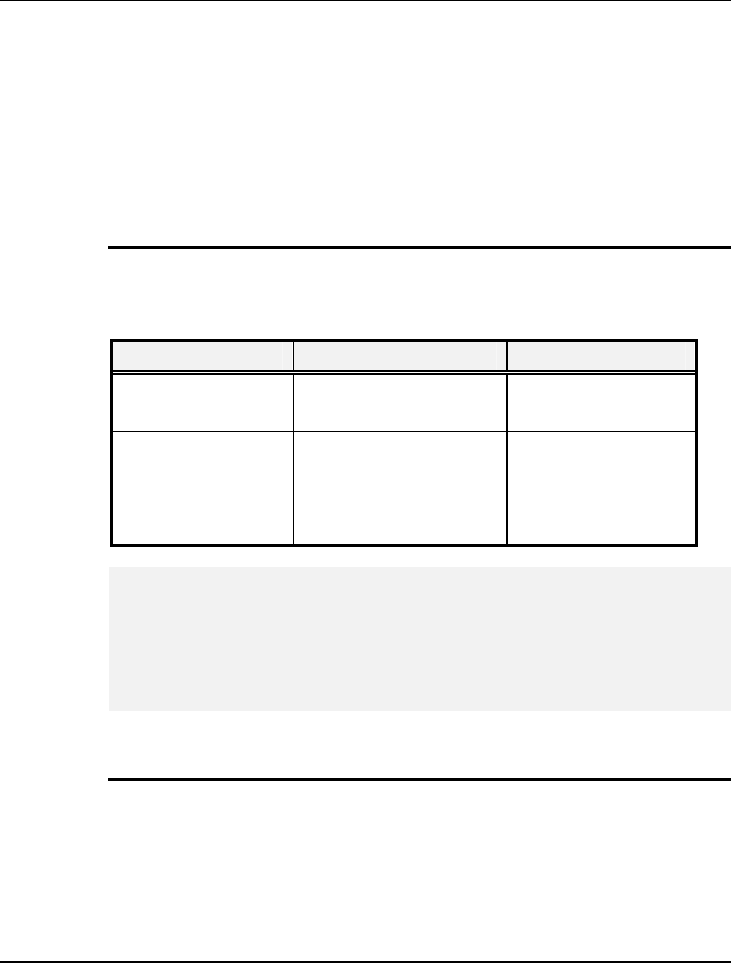
Using Your Notebook 3
53
under Windows. After installing the VGA driver, you would then configure the
display resolution or screen size to match your LCD display panel. This
notebook computer model provides Wide screen 15.4” 1280x800 (Wide XGA)
resolution panels. You would also probably want to set the amount of color
output to display sharper images and photos.
POSSIBLE DISPLAY CONFIGURATIONS
The table below shows you the possible display resolution you can set when
using either the LCD display or the external monitor (CRT):
Display Possible Resolution Maximum Colors
Widescreen
15.4” WXGA LCD
1280x800
(Maximum Resolution)
16 million colors
CRT Only 800x600
1024x768
1152 x 768
1280x1024
16 million colors
16 million colors
16 million colors
16 million colors
65,536 or 64K colors is also equivalent to 16-bit high color while 16 million or
16M colors is equivalent to 32-bit true color.
You can use the <Fn> + <F3> hot-key to switch the display between LCD
only, CRT only, or both LCD and CRT display.
CHANGING THE DISPLAY PROPERTIES UNDER WINDOWS
To change the display properties of your screen under Windows system, just
right-click on the desktop area and select Properties or go to the Control Panel
and click on the Display icon. The Display Properties dialog box will appear on

Notebook User Guide
54
your screen. Click on the Settings tab to set your desired configuration. Make
sure to follow the configuration table above.
If you cannot configure the display properties, change the display driver
first as mentioned on Section 5 "Installing the Notebook Device Drivers" of
Chapter 2 in this manual. Consult your dealer for the latest Windows VGA
driver.
3.5 Knowing the Power Saving Features
Aside from its superior performance, one of the great features in your
notebook computer is the ability to conserve power. Your computer is
designed to incorporate intelligent and advanced power management functions
that turn off power of most components when system is idle or not in use.
This feature not only gives you longer battery life but also cools the systems
and components as well. For more information on how to control the power
management features of your computer, refer to the Power Options function
in Control Panel of Windows.
The definitions of Standby Mode, Hibernation Mode, and Shutdown are
depicted as follows:
Standby Mode
Standby Mode is mainly for power saving. When the Standby Mode is
activated, your display and hard drive are shut down and all open applications
and documents are stored in RAM (Random Access Memory). This allows
your notebook to wake up quickly, but a low level of power is required to
maintain this suspended state. How quickly your system powers down into
Standby mode is up to you by setting proper times in Power Options of
Control Panel in Window. While the notebook is in Standby mode, the LED

Using Your Notebook 3
55
of power indicator flashes. To resume your working again, you can press the
power button to return your work to the screen where you left off.
Hibernation Mode
In Hibernation mode, all system devices are powered down and the contents
of RAM are stored on your hard drive. Hibernate mode uses less power than
Standby mode, but takes a bit longer time to resume. When your notebook
goes into hibernation, Windows saves your entire desktop state before
powering down your computer. You don’t need to save and close each
document before you put your notebook into hibernation. When you press
power button again, system will bring your notebook out of hibernation. You'll
find your applications and documents open on your desktop exactly as you left
them.
Hibernation is enabled by default. To verify that Hibernation is enabledd,
Click
Start
, point to
Settings
, and then click
Control Panel.
Choose
Power Options
icon, then click on the
Hibernate tab
. IF the chock box
of Enable Hibernate is selected, the Hibernation mode is enabled.
Shutdown
All power has been turned off from the notebook. This means that no power
including external AC power source and battery power source will be consume
by the notebook.
3.6 Working with the Built-in HDD
Your notebook computer is equipped with a built-in large capacity 2.5 inch
hard disk drive where you store and run your computer’s operating system and
application software programs.
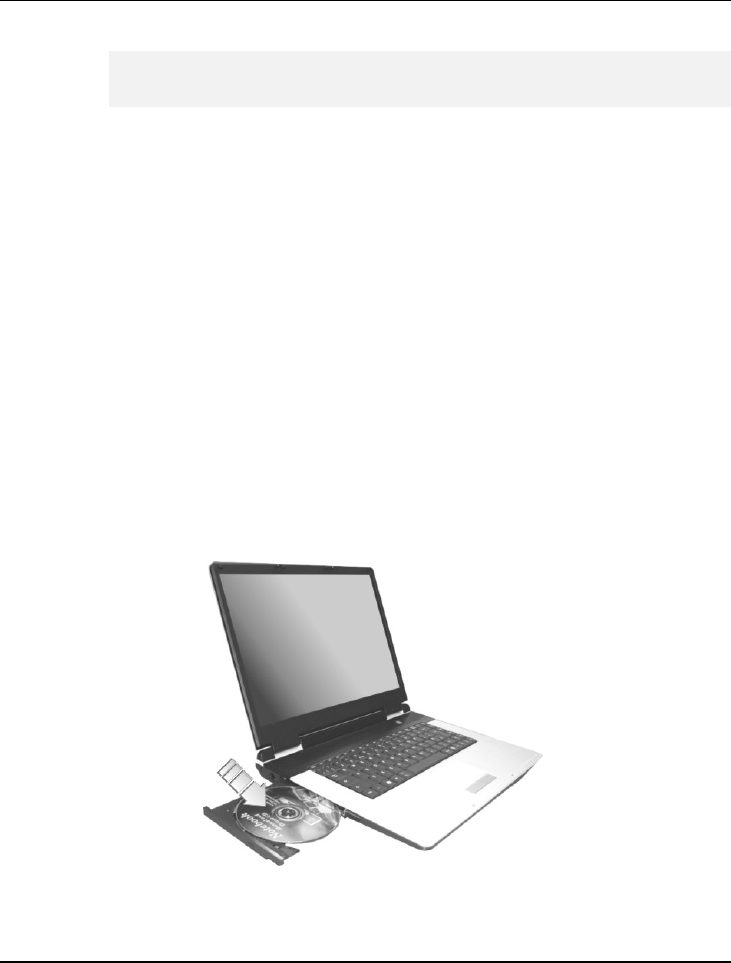
Notebook User Guide
56
If you wish to replace your hard disk, contact Everex (see page 120) for
more information about upgrading your computer.
3.7 How to Access the Optical Drive
Your system ships with an optical disk drive installed on the left side of your
computer. You would normally use the drive for installing operating system
and software application programs.
To insert and remove a disc on the drive:
1. Make sure the computer is turned on. Press the eject button found on the
door cover of the optical drive. The DVD/CD tray mechanism will pop-
out slightly and slowly pull out the whole length of the tray.
2. Place the disc on top of the DVD/CD tray with the label side facing up.
Gently press the compact disc onto the center spindle to secure the disc.

Using Your Notebook 3
57
3. To remove the disc, press on the center spindle and pull up the disc from
the side until the disc snaps out of the spindle lock.
If the eject function is disabled by software or a power failure occurs, the
Emergency Eject Hole allows you to manually remove a CD from the
reader.
4. To close the optical drive, simply push the CD tray inside. The optical
drive LED will activate when the disc is detected. Wait until the LED has
turned off and then start to read the disc.
How to care for Optical Disks (CDs, DVDs, etc.)
When you handle CDs and DVDs, pay attention to the following guidelines:
• Always pick up the disk by its edges.
• Avoid scratching or soiling either side of the disk.
• Do not write with the hard ball-point pen or apply labels on either side of
the disk.
• Keep the disk away from direct sunlight or high temperatures.
• Clean fingerprints or dust from the disk by wiping it with a soft cloth.
The above points also apply to other optical storage media.
The optical drive is a Class 1 Laser Product.
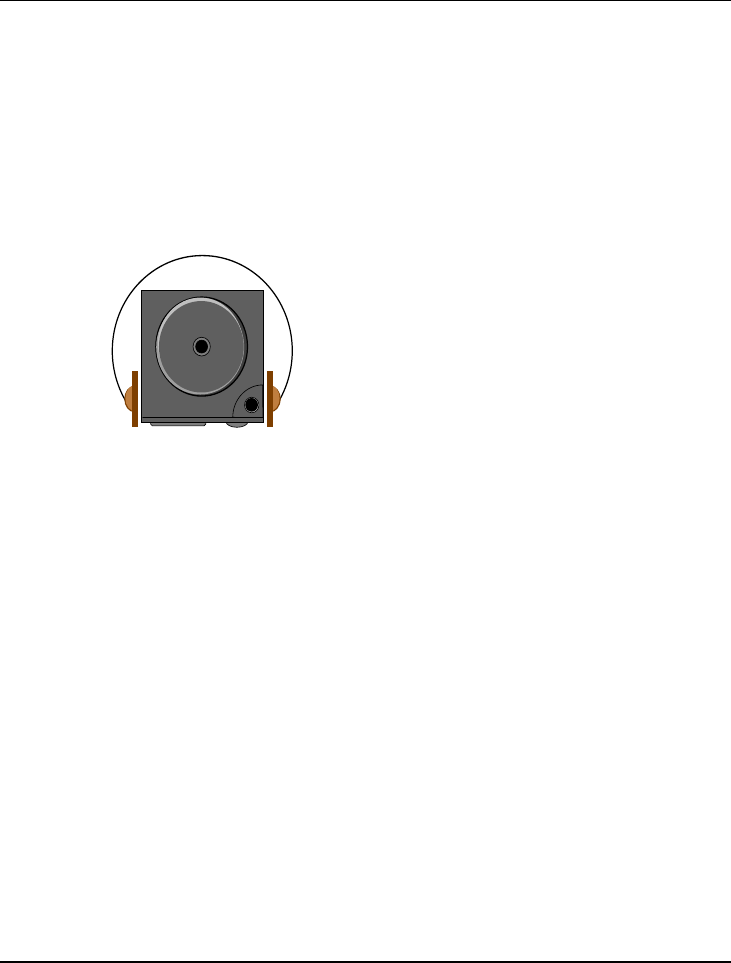
Fun with Multimedia 4
59
4 Fun with Multimedia
This chapter describes how to make full use of the
multimedia features available on your Everex
computer. You will learn how to adjust and alter the
built-in sound system and use the optical disk drive
to view and create multimedia files.

Notebook User Guide
60
4.1 Notebook Multimedia Features
Your notebook computer is rich in multimedia features that make your
computing fun, comfortable, exciting and easy. Your computer is well able to
perform all multimedia tasks through the following:
• Intel® Celeron® M Processor Dothan
• Up to 2GB DDRII SDRAM
• DVD/CD-RW Combo or DVD Dual (Optional)
• Integrated VIA VN800 graphics engine.
• 16-bit Audio Sound System with built-in speaker and microphone.
4.2 Audio Sound System Features
Your computer has a built-in 16-bit stereo sound controller that allows you to
record, store, and playback voice, music and other sound effects with built-in
mixer controls. An integrated full-duplex microphone and mini-speaker also
allows you to record and playback sound anytime and anywhere.
On the left side of your computer, you will find the audio ports that include
the following:
• External 1/8-inch microphone jack that connects external microphone for
recording purpose.
• Earphone or headphone jack for personal listening.
• Sound volume adjust by K/B hot-key
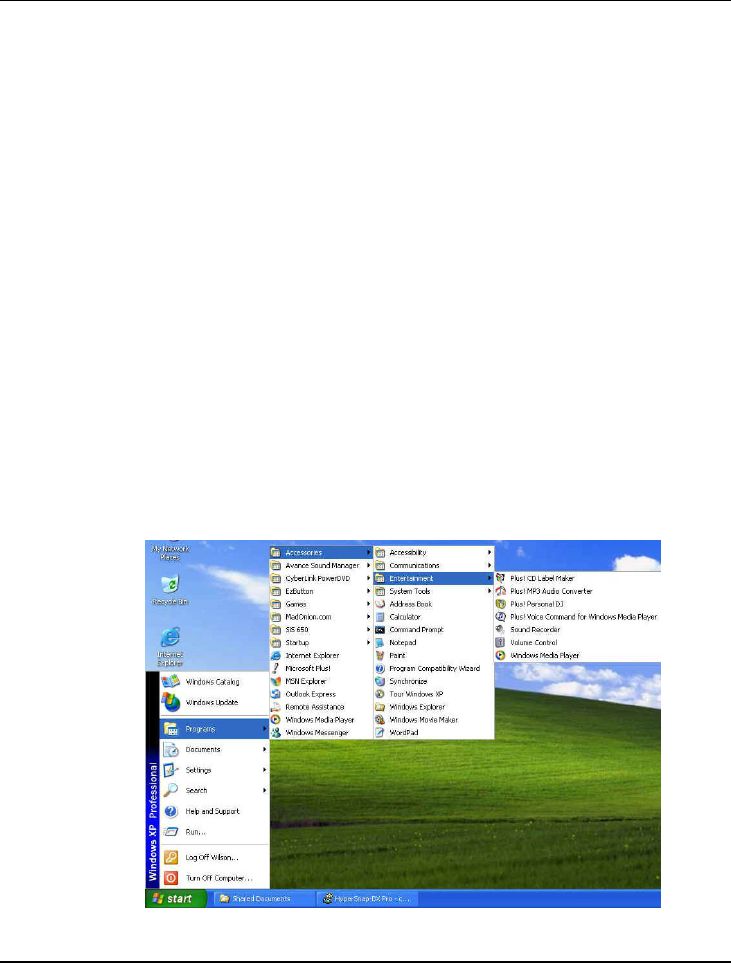
Fun with Multimedia 4
61
4.3 Setting up the Audio Driver
Properties
Your StepNote computer comes with Microsoft® Windows® pre-installed,
and does not need additional audio driver setup. If you wish to customize the
audio properties of our computer, visit the Windows® Help and Support
document located on your computer
4.4 Windows Multimedia Programs
Windows provides several multimedia programs that you can run with the
built-in features of your computer. Pointing the Start button, Programs,
Accessories, then Entertainment, you will find the Multimedia programs
group. (The section below use Window XP as examples)

Notebook User Guide
62
Figure 4-1 Entertainment Programs Group
The standard multimedia components are as follows:
• Windows Media Player - for playing sound, video and animation files
• Sound Recorder - for recording sounds and playback
• Volume Control - for adjusting the volume of mixer
For more information on how to operate these multimedia components, run
the program and click on the Help menu.
4.5 Recording Sounds
Your computer allows you to record voice and other sounds in several ways
and stores them as files on your hard disk. These voice or sound files can then
be played back through the internal speaker or earphone jack using an external
speaker, headphone, or earphone set. You can also use the files as voice
annotations on many applications for more real presentation. This section will
describe briefly how you can record sounds under Windows operating system.
To record sounds, you need to run the Sound Recorder program from the
Multimedia program groups. The control buttons of the Sound Recorder are
simple to understand which comprise of the Fast Rewind, Fast Forward, Play,
Stop, and Record buttons. Click the Help menu on how to operate the Sound
Recorder.
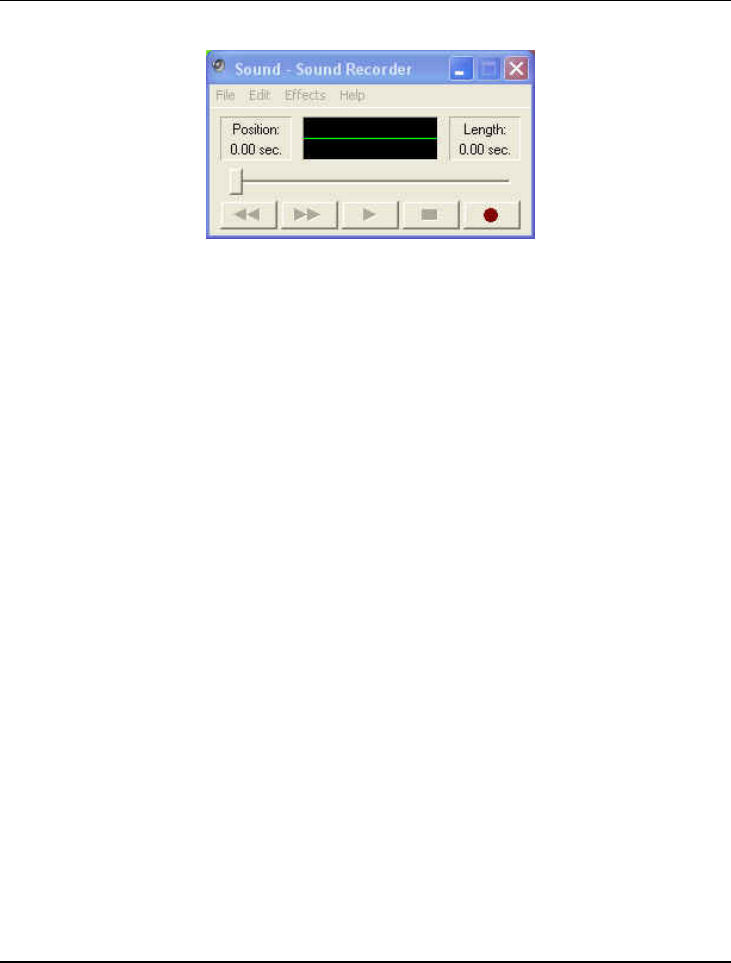
Fun with Multimedia 4
63
Figure 4-2 Sound Recorder
The Sound Recorder also allows you to record sound from different input
audio source like the following:
• From the external microphone
• From the Optical drive
Since you could record sound from different input sources, you must first set
the proper audio input recording device under the Recording Control panel.
To do this:
1. Double-click on the Volume Control on the taskbar or click Start button,
then point to Programs, Accessories, Entertainment and then click on
Volume Control.
2. Click Properties in the Options main menu.
3. Click the round button for Recording and tick off each component that
list in the "Shows the following Volume Controls" box.
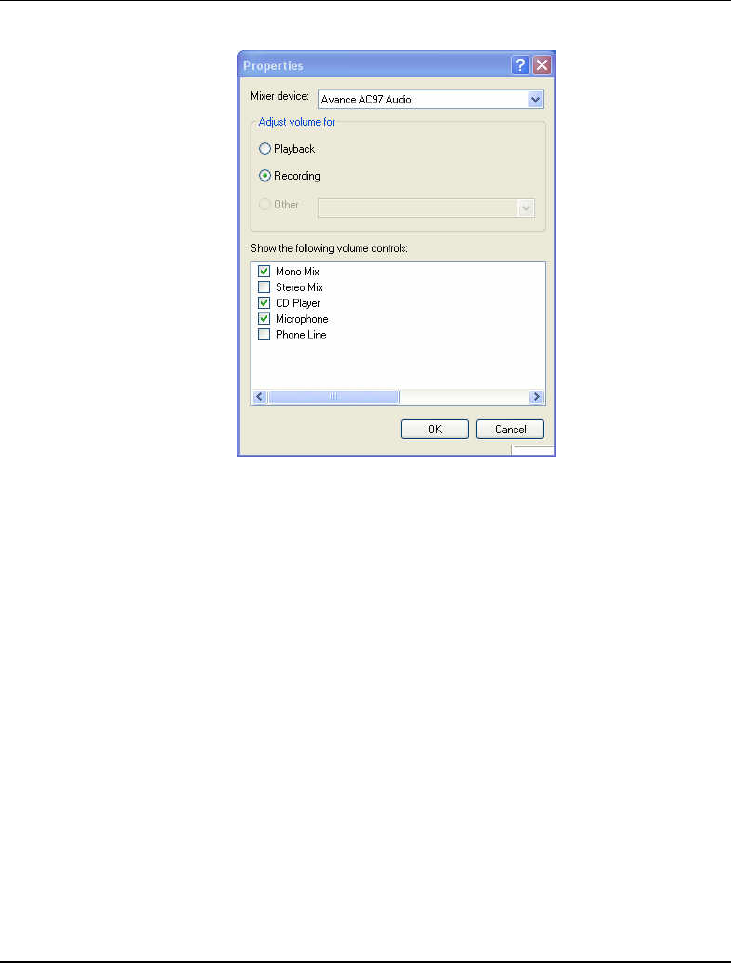
Notebook User Guide
64
Figure 4-3 Audio Properties
4. Click OK and the Recording Control dialog box will appear. Here, you
will select the input device for the recording source. If you want to record
from the optical drive with audio music, you must click on CD Player.
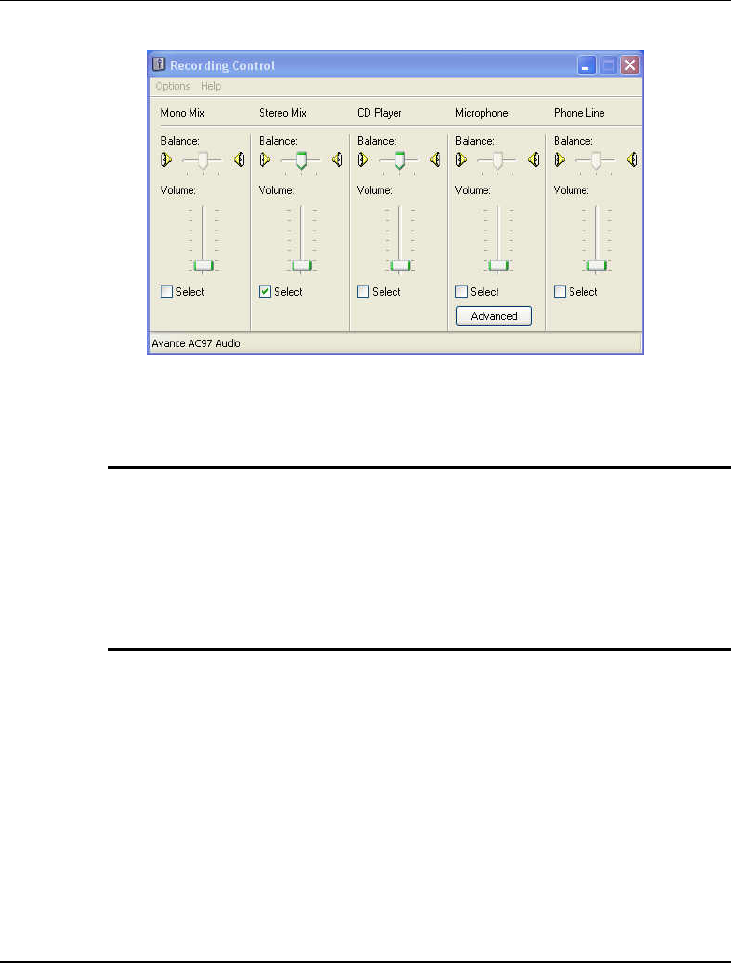
Fun with Multimedia 4
65
Figure 4-4 Recording Volume Control
USING AN EXTERNAL MICROPHONE
Your computer allows you to connect an external microphone for high quality
recording. The external microphone jack is found on the left side of your
computer. Use only microphone with 1/8-inch mini-jack connector. Follow
the same procedure for recording voice.
USING THE BUILT-IN OPTICAL DRIVE
You would normally use the optical drive for recording audio music from the
Audio CD. Follow these steps:
1. Activate CD Player volume on the Recording Control as discussed earlier.
2. Run the Sound Recorder program.
3. Insert the audio CD into the optical drive. Unless you have disabled the
CD auto-insertion notification for supporting Suspend mode, the CD
Player should automatically run after you have inserted an audio compact
disc and will start playing the audio CD.
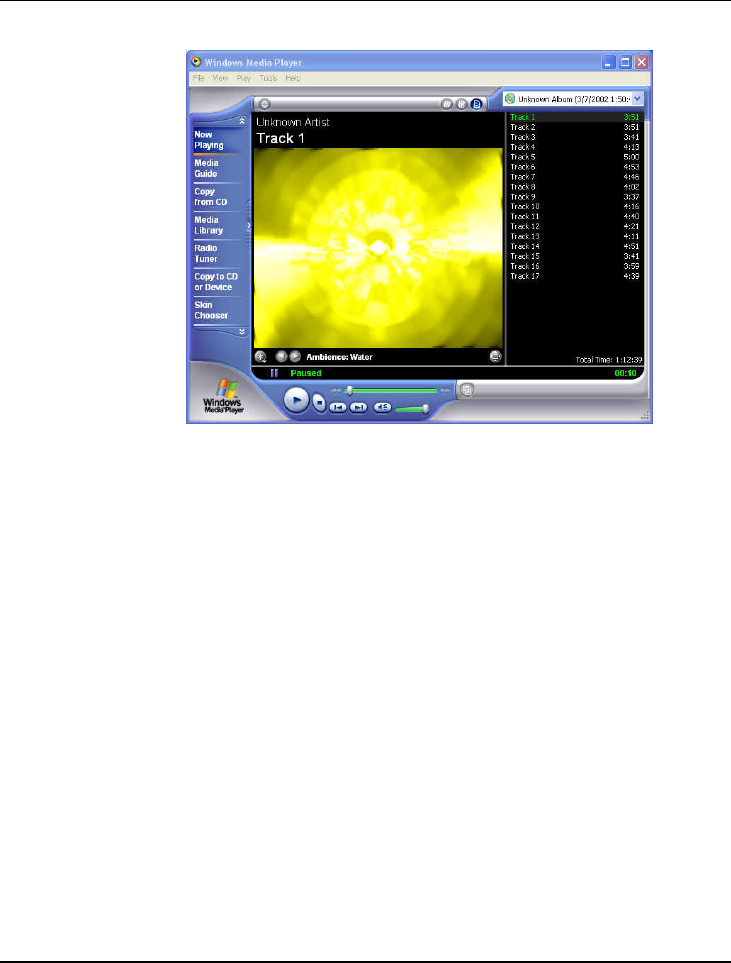
Notebook User Guide
66
Figure 4-5 Play Audio CD by Windows Media Player
4. Select the starting point where you want to start recording.
5. Switch to the Sound Recorder and press the Record button.
6. Switch immediately to the Windows Media Player and press the Play
button. You can adjust the volume control so you can also hear the music
while in recording.
4.6 Playing Audio and Sound
Your computer has built-in one speaker to playback audio and sound. You can
also adjust the volume manually by adjusting the volume control hotkeys
found on the keyboard.

Fun with Multimedia 4
67
For more quality sound output, you can choose to connect an external
amplified speaker or earphone from headphone jack. Always minimize the
volume first before placing the phone set to your ear.
USING THE WINDOWS MEDIA PLAYER
The easiest way to playback multimedia media files is to run the Windows
Media Player. Follow these steps:
1. Click on Start, point to Programs, Accessories, and then
Entertainment.
2. Click on Windows Media Player to start program.
3. Click on the File menu and select the file you want to play.
4. When the file is recognized and open, click on the Play button to start
playback.
4.7 Playing Video and MPEG Files
Your computer is capable of running video motion files as well as MPEG
(Motion Picture Expert Group) files on CD, DVD, or CD-RW. By using
software MPEG program, you can watch real full-motion picture on your
computer. You can also run the Windows Media Player under the
Entertainment programs group as well to show all media device programs.
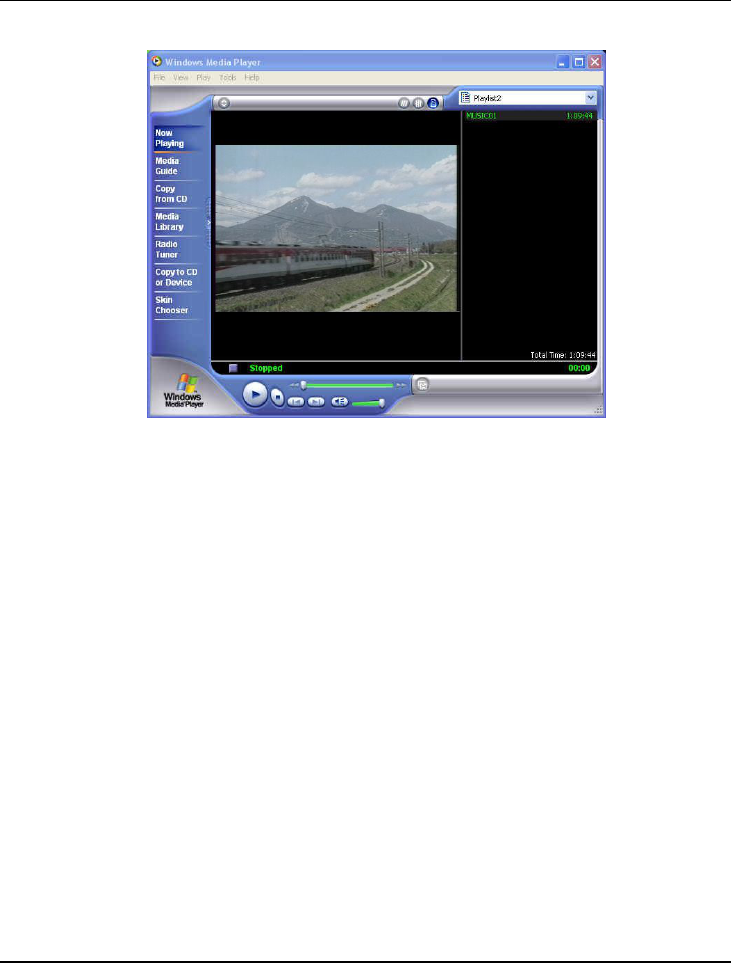
Notebook User Guide
68
Figure 4-6 Windows Media Player
4.8 Using DVD
DVD is the breakthrough in superb full-motion picture playback. One disc can
contain at least 4.7GB of information, capable of holding one full-length
movie with soundtracks, subtitles, and different languages. Much more, the
DVD-ROM drive of your computer is backward compatible with CD-ROM
drive so it allows you to use any CD as well. It also works the same as the CD-
ROM.
To playback DVD titles, you would need a software MPEG-2 program and the
DVD-ROM drive at least. Your Notebook computer has installed Windows
XP for operation system and its Windows Media Player supports DVD’s
playback..
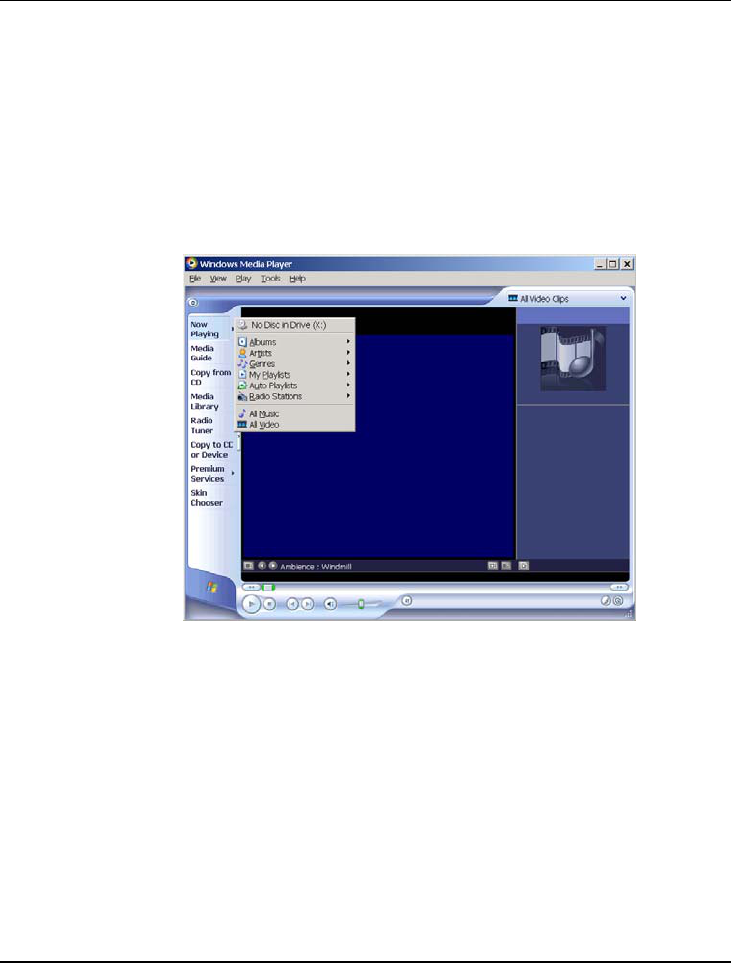
Fun with Multimedia 4
69
You can use Windows Media Player to watch DVDs on your Notebook
computer. Like a conventional DVD player, by using the Player, you can skip
to specific titles and chapters, play sequences in slow motion, gain access to
special features, and switch audio and caption languages. In addition to these
conventional DVD player tasks, you can also retrieve information about each
disc from the Internet.
Figure 4-7 To play a DVD
On the Play menu, point to DVD, VCD or CD Audio, and then click the drive
that contains the DVD. In the Playlist pane, click a DVD title, or chapter
name, if appropriate.
To eject a disc, on the Play menu, click Eject. To play a selected title in a DVD
repeatedly, on the Play menu, click Repeat. A check mark appears next to the
command to indicate it is turned on.

Notebook User Guide
70
4.9 Using Rewritable Optical Disk Drive
DVD/CD-RW Combo Device Pack
This device pack can write data to CD-R or CD-RW CD for you to backup the
data and also can read DVD/CD title.
DVD dual (Dual Rewritable DVD combo) Device Pack
This device pack combines following two standard packs. Using the suitable
media, you can make any format of CD or DVD as you want.
DVD-RW combo:
This device pack can write data to CD-R or CD-RW and DVD-R or DVD-
RW media and also can read DVD/CD title. This media is commonly used on
DVD video player.
DVD+RW combo:
This device pack can write data to CD-R or CD-RW and DVD+R or
DVD+RW media for you to backup the data and also can read DVD/CD title.
This media is commonly used on newer DVD video player.
Please pay attention to the copyright of the software or data you want to
backup. Backup or distribute the software or data might be illegal
according the restriction of the law.
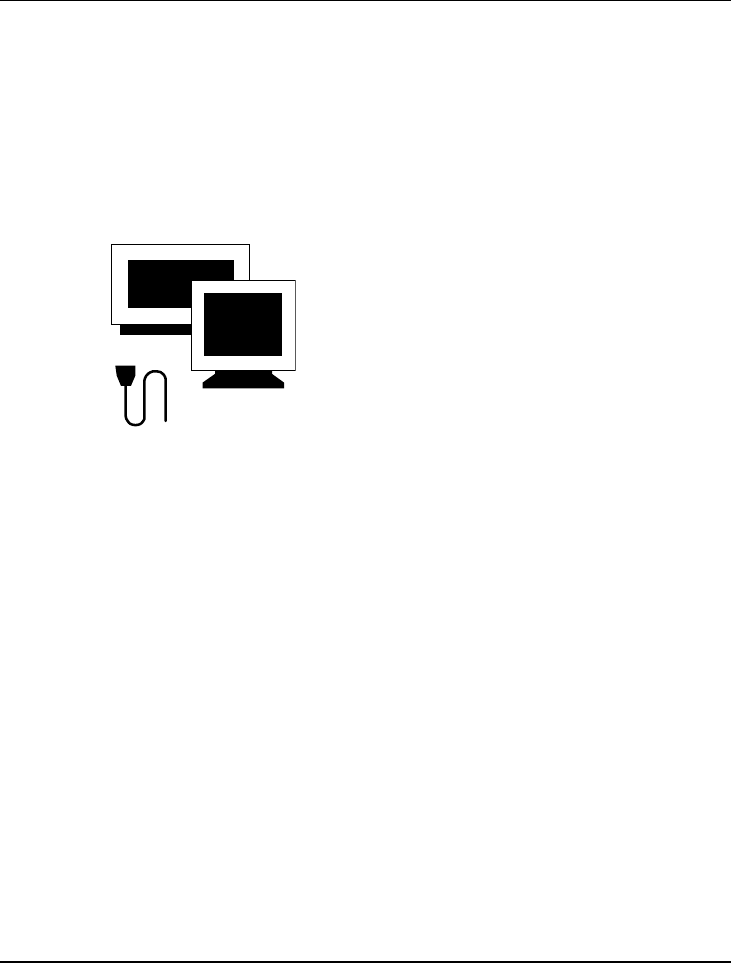
Connecting to Peripherals 5
71
5 Connecting to Peripherals
This chapter describes how you attach additional
peripheral devices to your notebook*. The Everex
StepNote allows you to add a printer or mouse;
connect an external monitor and keyboard, or other
compatible peripheral device. Use of additional
devices is described in this chapter.
* Additional peripheral devices sold separately
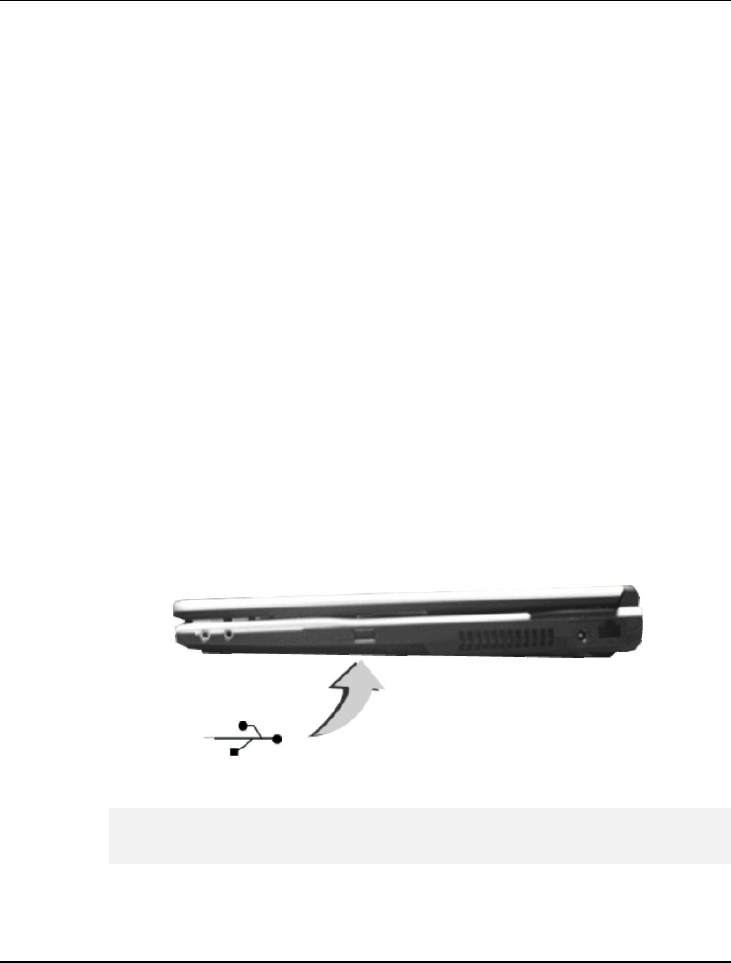
Notebook User Guide
72
5.1 Using the USB Port
USB (Universal Serial Bus) is a hardware interface that enables you to connect
multiple devices (such as printers, mice, keyboards, storage devices, joysticks,
digital cameras, and video conference cameras, etc.) to your notebook
computer, and up to 127 devices can be attached. Besides, USB’s hot swap
capability allows everything to be plugged in and unplugged without turning
the system off.
Microsoft, HP, Compaq, Intel, Agere, NEC and Philip are seven core
members of USB-IF to have worked on USB 2.0 standardization. USB 2.0
offers data transfer rate up to 480Mbps (megabits per second) compared to
USB 1.1 devices, which transfer at speeds of 12Mbps. So, you could know that
USB 2.0 can transfer data between the computer and its peripherals 40 times
faster than USB 1.1. However, USB 2.0 is fully backward compatible, you will
be able to use a USB 1.1 device in a USB 2.0 compliant system.
Depending on your operational requirements, you may need to disable
other ports in order to release system resource for the USB port.

Connecting to Peripherals 5
73
The USB bus distributes 0.5 amps (500 milliamps) of power through each
port. For the purpose of power saving, please disconnect your USB device
while not in use.
5.2 Using an External Monitor Port
Your computer has a 15-pin Monitor port for supporting any external CRT or
LCD color monitor. You need a display signal cable (usually provided with the
monitor). One end of the cable must have a 15-pin connector for the system.
To connect an external monitor:
1. Turn off your computer and make sure the monitor power switch is
turned off.
The notebook computer must be powered off or suspended while the
monitor is being connected. Although you can connect the external Monitor
without power off the computer and the external monitor, however, it is
harmful to both devices and it shortens the life of these devices.
2. Connect the connector cable of the monitor to the VGA port at the back
of your computer. Secure the cable connection with the screws provided.
3. Connect the monitor power cable and plug it into a properly grounded
wall outlet.
4. Turn on the power of the monitor.
5. Turn on your computer. Both the LCD panel and the monitor screen will
show the display. Your computer is set at default to run at simultaneous
display mode.
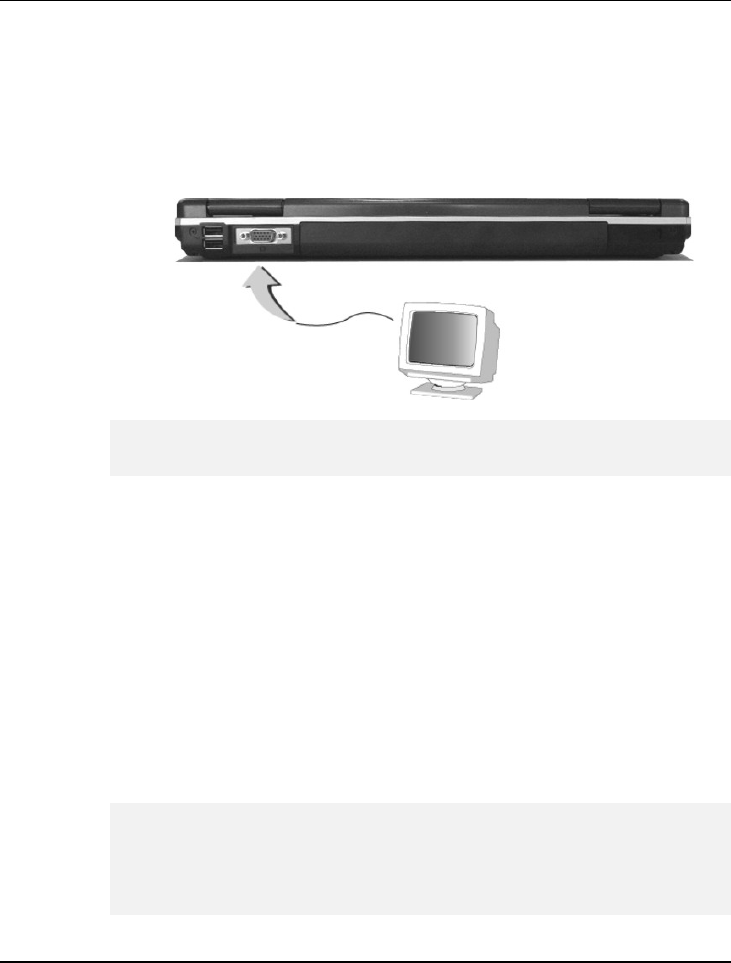
Notebook User Guide
74
6. If you only want to show the display on the external monitor or projector
and shut off the LCD display, you can use the <Fn> + <F3> hot-key to
switch display type between LCD and external monitor. Keep pressing the
hot-key until you get the display to external monitor only.
Refer to Chapter 3 regarding the possible External CRT resolutions and
how to change the display properties.
5.3 Using the External Audio System
At the left side of your computer, you will find the built-in audio ports. You
can connect Microphone jacks, earphone or powered speaker.
To connect to a audio jack:
1. Locate the audio port (Microphone, Headphone) that you want to use to
the target device.
2. Plug the jack into the port on the left side of the system.
If you use external speaker and experience the sound distortion or
feedback, please lower the volume. Some factors is caused by too close
locating the microphone and speaker from each other, moving away the
external audio option from the unit may also help.
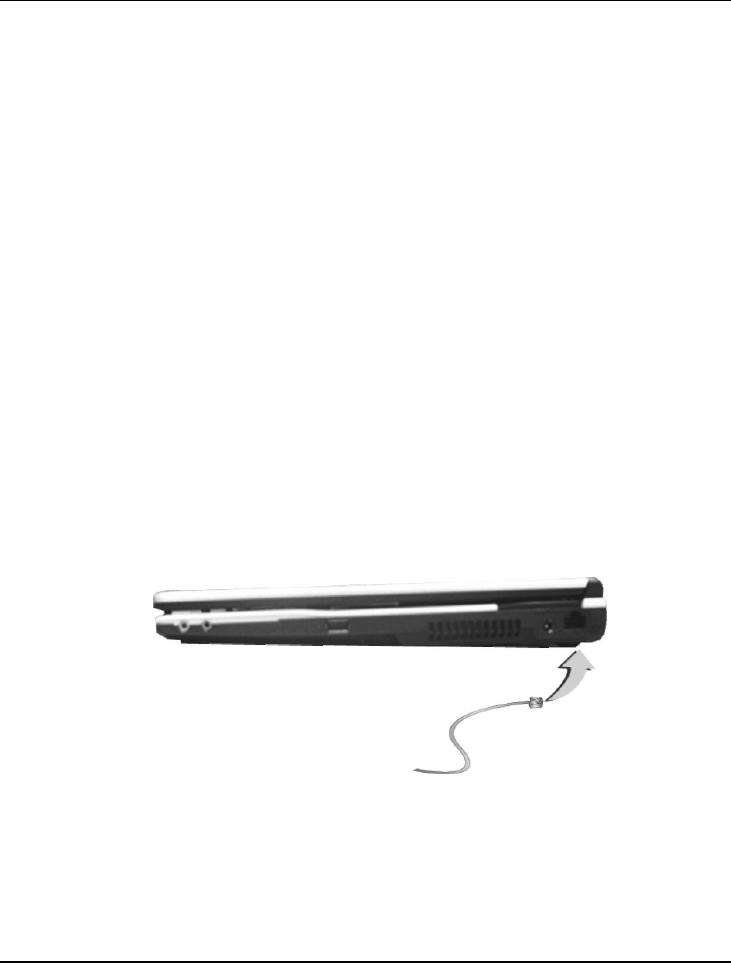
Connecting to Peripherals 5
75
5.4 Using the LAN Port
This notebook comes with an internal 10Base-T/100Base-TX LAN module
that connects your computer to other computers/networks through a local
area network (LAN) and supports data transfer rates at 10Mbps and can be up
to 100Mbps. The 10Base-T standard also called Twisted Pair Ethernet is
connected with RJ-45 connectors. The 100Base-TX is based on the older
Ethernet standard. Because it is 10 times faster than Ethernet, it is often
referred to as Fast Ethernet.
The built-in LAN module provides a standard RJ-45 connector.
To connect the twisted-pair cable to your LAN port:
1. Locate the twisted-pair cable in the accessories box in notebook shipping
carton. Each end of the cable has a RJ-45 connector.
2. Connect one end of the cable into the network wall outlet or HUB.
3. Connect the other end of the cable into the computer RJ-45 LAN port.

Notebook User Guide
76
5.5 Using the Wireless LAN
Wireless LAN is the major breakthrough in computer communication
technology. It lets user connect to the LAN environment without using any
wire to traditional RJ-45 jack. User can enjoy the wireless connection within
the range of Access Point (AP) of LAN.
Access Point (AP) is the wireless transmission and receiving device, it generally
connects to the server of a LAN environment or act as a LAN hub with
wireless connection. Access point can be set in an office environment, airport,
major railway station, etc. that depends on the construction of each country. In
most case, you probably can use it at office, please consult with the network
department of your company for more details.
This computer integrates built-in 802.11 b/g wireless LAN module. IEEE
802.11b standard supports 11 Mbps wireless connection speed. However,
IEEE 802.11g supports 54Mbps wireless connection speed, and is backward
compatible with the slower 802.11b. Wireless LAN module is similar to LAN
module. You need to install software driver before using it. Please refer to
chapter 2.5 on how to install the driver.
5.6 Using the Modem Port
This notebook comes equipped with a 56K internal fax/data modem that
allows you to communicate with others via fax, email, or to connect to an
online service or bulletin board.
The built-in fax/data modem provides on standard phone connector.
To connect the analog phone cable to your modem:
1. Locate the analog phone cable in the accessories box in notebook
shipping carton. Each end of the cable has a RJ-11 connector.
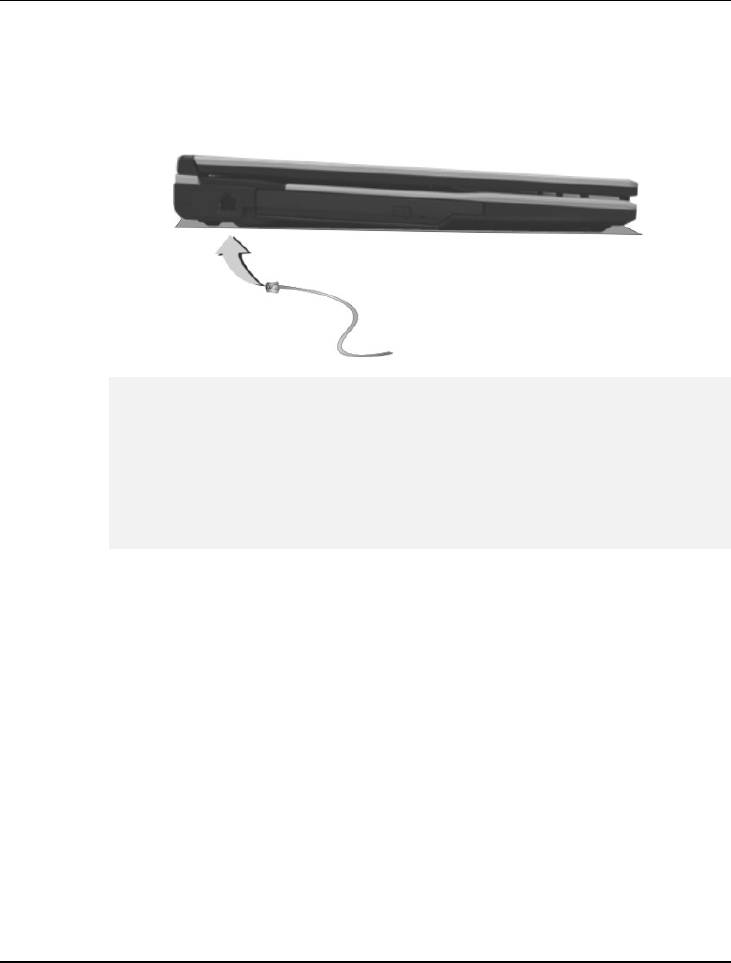
Connecting to Peripherals 5
77
2. Connect one end of the cable into a standard wall outlet.
3. Connect the other end of the cable into the computer modem port.
The speed of data transmission is dependent on the quality of telephone
lines. Digitally terminated lines improve the speed of data transmission.
Contact your service provider for more information.
The analog phone cable is an industry standard cable. Longer cables are
available at your local electronics store.
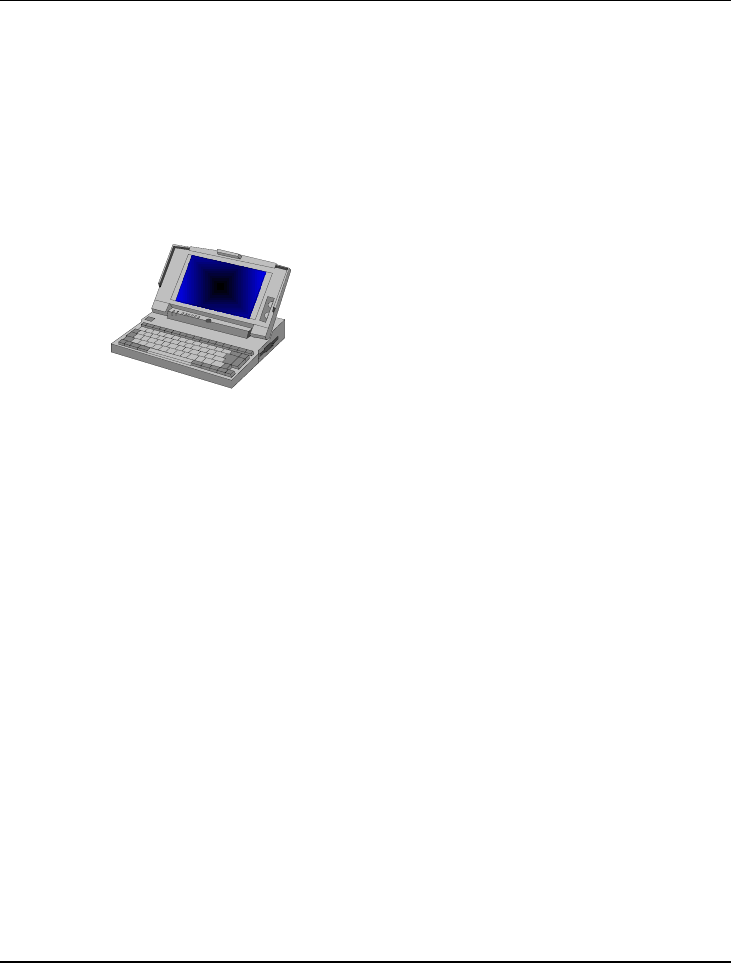
Customizing Your Notebook 6
79
6 Customizing Your Notebook
Your computer uses the Phoenix BIOS Setup
program allowing your system configuration to be
altered to best suit your computing needs: User-
adjustable options include system time and date, disk
drive configuration and password setup.
BIOS information stored in the CMOS RAM will
remain permanent unless changed. Default factory
settings are used top optimize performance of your
notebook computer and do not need further
alteration to operate your computer. Use caution
when changing any BIOS settings.

Notebook User Guide
80
6.1 Running the BIOS Setup Program
Your computer is setup and pre-configured. The computer’s BIOS (Basic
Input-Output System) Setup program may be used to change system
configuration information such as the current date and time, or your hard disk
drive type. The Setup program can be accessed when you power on the
system and pressing the <F2> function key before the Microsoft® Windows®
operating system begins.
The settings that you specify within the Setup program are recorded in a
special area memory called the CMOS RAM. This memory is backed up by a
battery so that is will not be erased when you turn off or reset the system.
Whenever you turn on the computer, the system will read the settings stored in
the CMOS RAM and compare them to the equipment check conducted during
the Power On Self Test (POST). If an error occurs, an error message will be
displayed on the screen, and you will then be prompted to run the Setup
Program.
As the POST (Power-On Self Test) executes during the boot up process, the
screen will display the following message:
Press <F2> to Enter SETUP
Press the <F2> key to run the BIOS Setup program. The BIOS Setup
program is organized into five menus which you can select using the <-- and --
> keys. To move from one option to another, you use the up and down arrow
keys while using the <F5> and <F6>, or <+>and <-> keys to change the
settings. On the right hand side of the screen are some brief help descriptions
of each item you want to change.
On the BIOS Setup program, you will find the following parts on the screen:

Customizing Your Notebook 6
81
• Item Specific Help
The right side of the screen. This area describes each parameter and its
available settings.
• Menu Bar
The top line of the screen. Each of the five selections displays its own
screen.
• Parameters
The left side of the screen. This area lists the parameters and their current
settings.
• Key Status Bar
The bottom part of the screen. These lines display the keys available to
move the cursor, select a particular function and so forth.
To exit the BIOS Setup program, simply press the <Esc> key and select from
the Exit menu whether you want to Save changes and exit; Discard Changes
and exit.
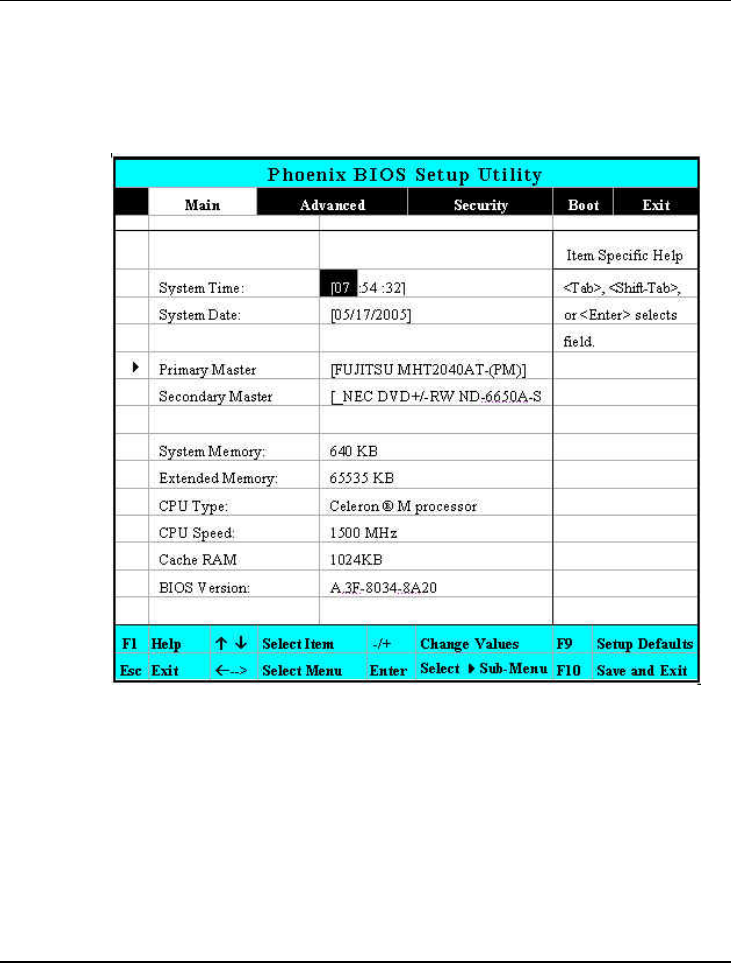
Notebook User Guide
82
6.2 Using the Main Menu Setup

Customizing Your Notebook 6
83
• System Time
Allows you to change the system time using the hour:minute:second
format of the computer.
Enter the current time for reach field and use the <Tab>,
<Shift>+<Tab>, or <Enter> key to move from one field or back to
another.
You can also change the system time from your operating system.
• System Date
Allows you to set the system date using the month/date/year format.
Enter the current time for reach field and use the <Tab>,
<Shift>+<Tab>, or <Enter> key to move from one field or back to
another.
You can also change the system time from your operating system.
• Primary Master
This field display various parameters for the hard disk drive. If type [Auto]
is selected, the system automatically sets these parameters. If type [User] is
selected, Cylinders, Heads and Sectors and other value can be edited.
• Secondary Master
This field is for information only as the BIOS automatically detects the
optical drive.
• System Memory
This field reports the amount of base (or conventional) memory found by
the BIOS during Power-On Self-Test (POST).
• Extended Memory
This field reports the amount of extended memory found by the BIOS
during Power-On Self-Test (POST).

Notebook User Guide
84
• CPU Type
This field reports the CPU type information detected by the BIOS during
Power-On Self-Test (POST).
• CPU Speed
This field reports the CPU speed information detected by the BIOS
during Power-On Self-Test (POST).
• Cache RAM
This field reports the CPU L2 Catch information detected by the BIOS
during Power-On Self-Test (POST).
• BIOS Version
This field is for information only as the BIOS displays the BIOS version
during the Power-On Self-Test (POST).
6.2.1 INTERNAL HDD SUB-MENU
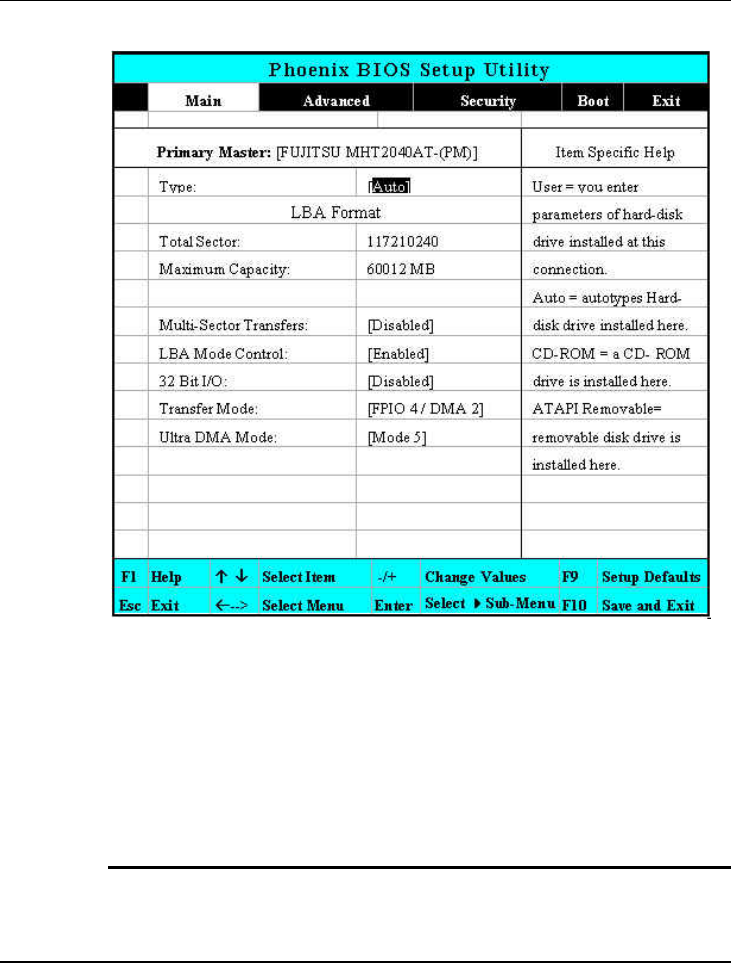
Customizing Your Notebook 6
85
Use the Type field to select the drive type installed. You can select different
drive types as CD-DVD, User, Auto or None by pressing <Space> bar. Set
this option to Auto so your computer will automatically detect the drive type
during power on. Set this option to None when your computer is not installed
any devices. Press <Esc> to return to the Main Menu.
6.2.2 INTERNAL OPTICAL DRIVE SUB-MENU
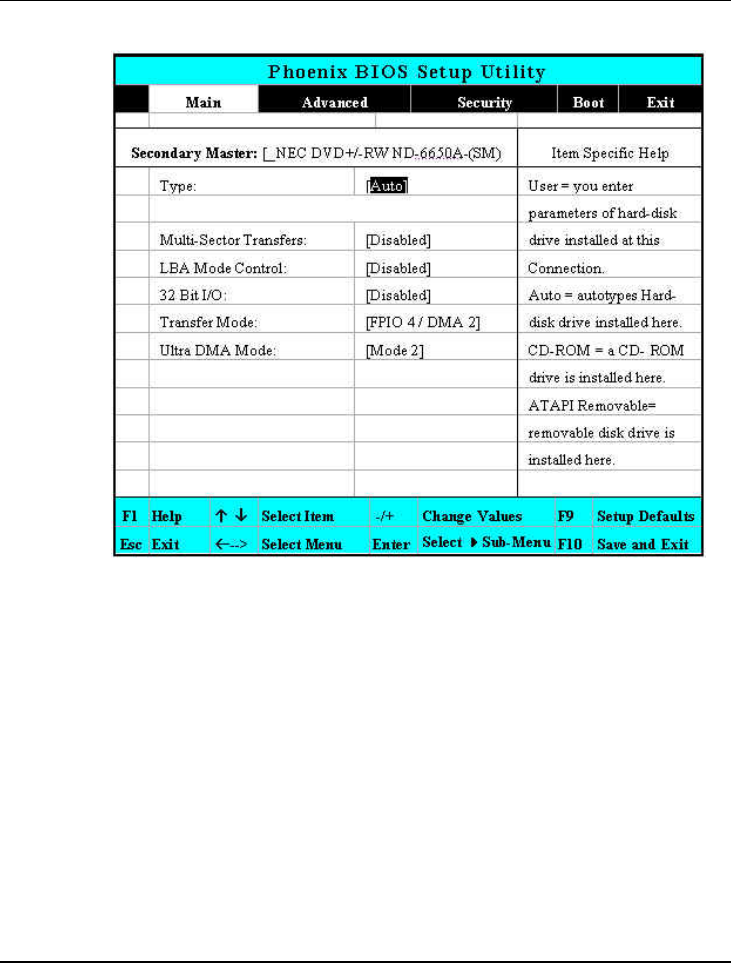
Notebook User Guide
86
Use the Type field to select the drive type installed. You can select different
drive types by pressing <Space> bar. Set this option to Auto so your
computer will automatically detect the drive type during power on. Set this
option to None when your computer is not installed any devices. Press <Esc>
to return to the Main Menu.
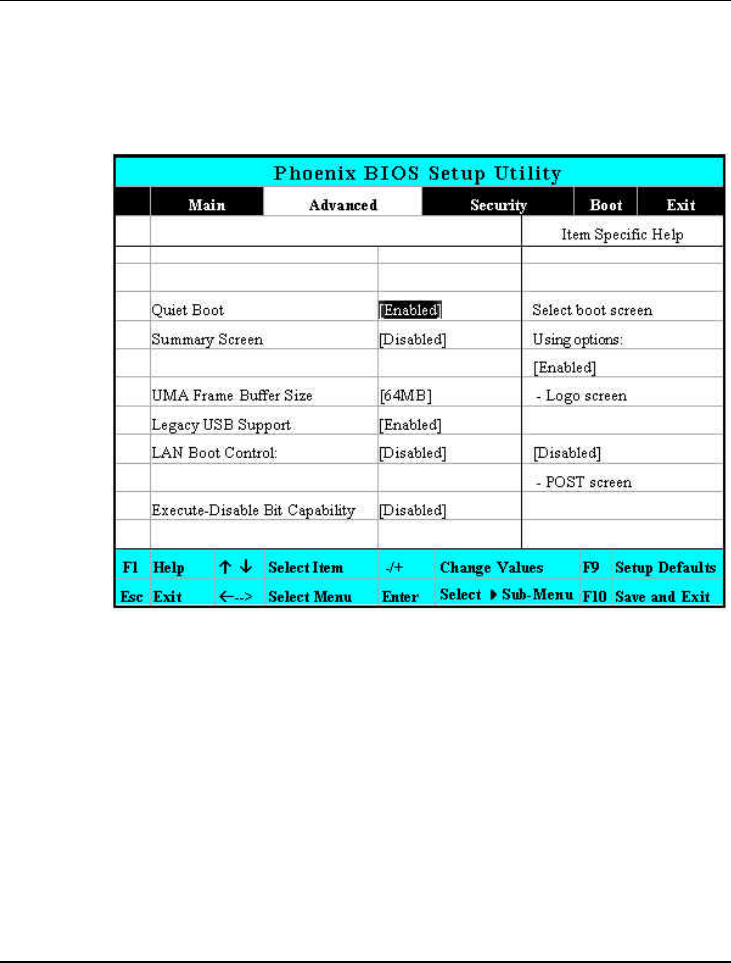
Customizing Your Notebook 6
87
6.3 Using the Advanced CMOS Setup
• Quiet Boot
Lets you specify the boot screen to Logo screen or POST screen by
choosing Disabled or Enabled, respectively.
• Summary Screen
Displays system configuration on boot.
• UMA Frame Buffer Size
Lets you reserve memory space [32MB]/[64MB]/[128MB] for UMA
frame buffer for video devices. The default value is [32MB].

Notebook User Guide
88
• Legacy USB Support
Enable or disable the USB Bus support when in connection with USB
device.
• LAN Boot Control:
Lets you specify Enabled or Disabled for booting the notebook from
Network or not.
• Execute-Disable Bit Capability
When disabled, forces the Execute-Disable Bit Capability extended
feature bit to always return 0. When disabled, forces the Execute-
Disable Bit Capability extended feature bit to always return 0.
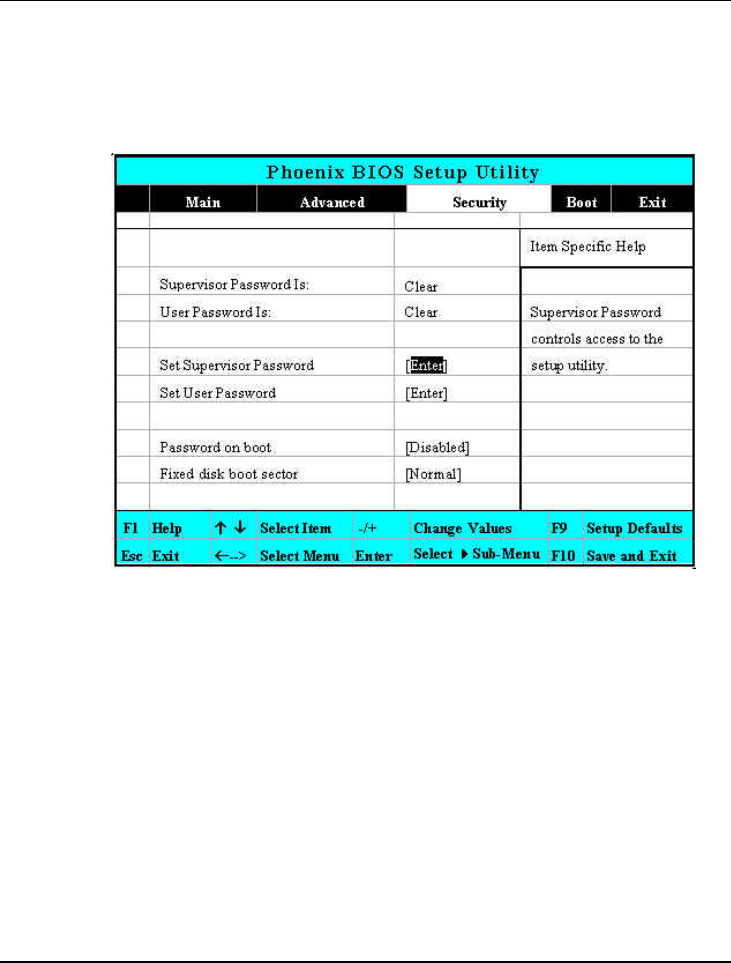
Customizing Your Notebook 6
89
6.4 Security Menu Setup
• Supervisor Password Is
Set/Clear selections show that the notebook is under controlled by
Supervisor Password or not.
• User Password Is
Set/Clear selections show that the notebook is under controlled by User
Password or not.

Notebook User Guide
90
• Set Supervisor Password
Supervisor password gives you the authority in accessing the setup utility.
You also need to enter this password in system booting and resuming
from suspend mode. When you press <Enter> in this field, the Set
Supervisor Password dialog box appears. Enter a new password with up
to 8 alpha-numeric characters, and then re-enter it for confirmation.
• Set User Password
This field is only available when Supervisor Password has set. Enter the
user password when boot the system or resume from suspend mode. But
if the Write Protect is set in the Fixed disk boot sector field, you should
enter a supervisor password to access the fixed disk when boot the system
or resume from suspend mode.
• Password on Boot
If you set this field to Enabled, your computer will always ask for the
password every time you boot your computer.
• Fixed Disk Boot Sector
If you set this field to Write Protect, the write protect boot sector on hard
disk will protect against viruses. In this situation, only the supervisor can
access the Boot Sector of fixed disk.
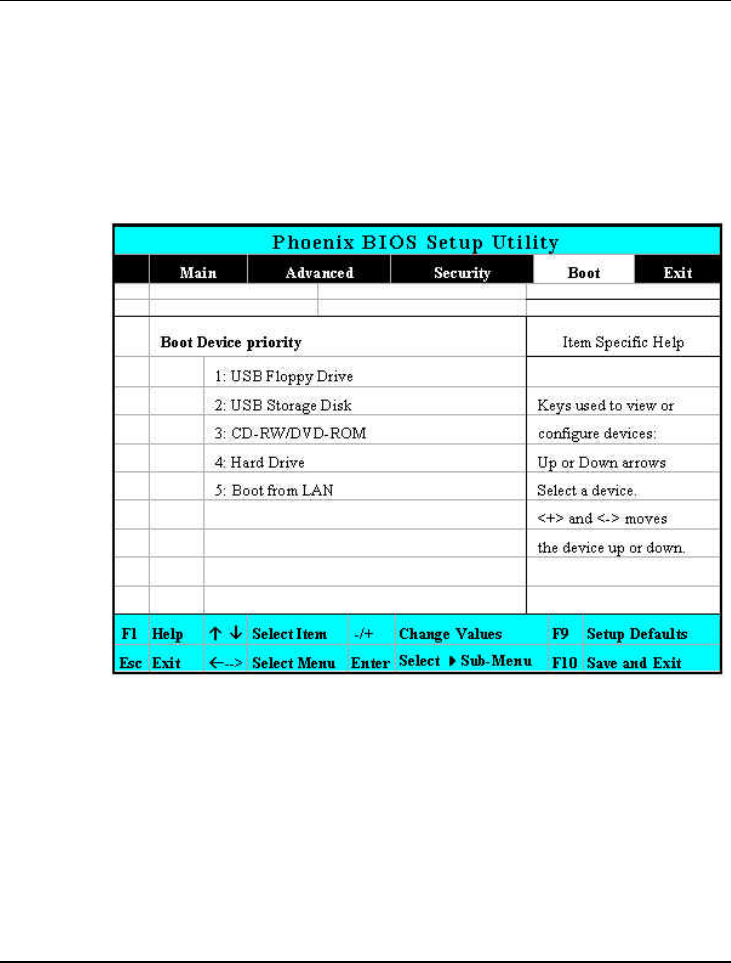
Customizing Your Notebook 6
91
6.5 Using the Boot Setup
This item allows you to set the search drive sequence where the system will try
to boot up first.
This page allows you to set the search drive sequence where the system will try
to boot up first.
To select the boot device, you can use the up or down arrow key, then press
<+> to move up the device in the list or press <-> to move down the device
in the list. To exit from this menu, press <Esc>.
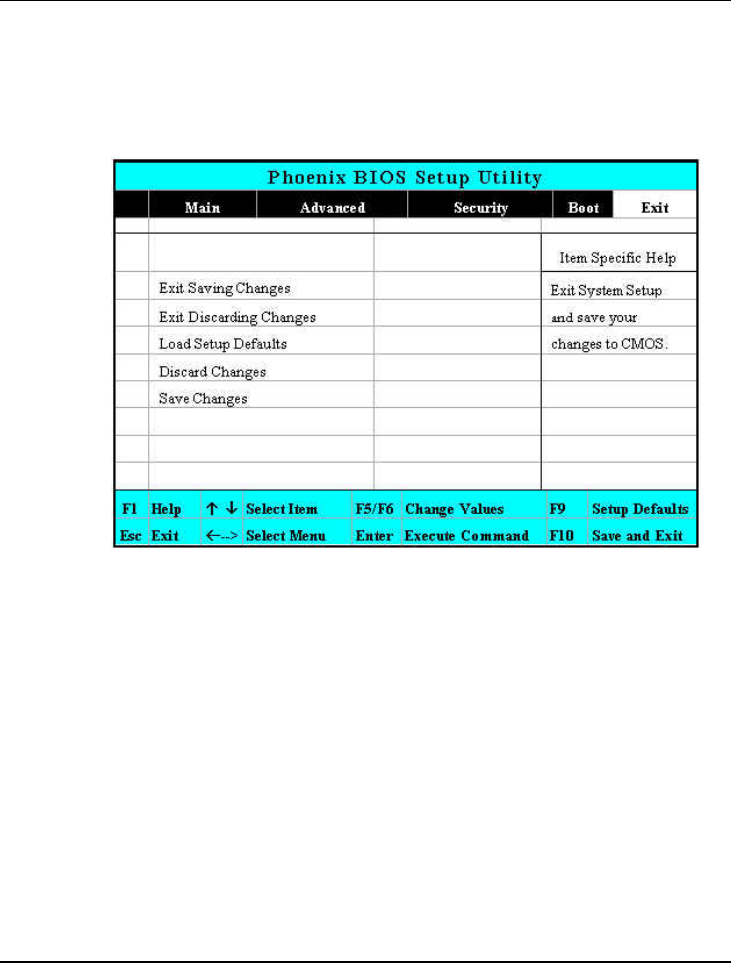
Notebook User Guide
92
6.6 How to Exit the Setup Program
There are two choices to escape from the Setup program.
• Exit Saving Changes
Saves all changes to CMOS while running the BIOS setup program and
exit from the system setup program.
• Exit Discarding Changes
Allows you to discard all changes made while running the BIOS setup
program and exit from the system setup program.
• Load Setup Defaults
Lets you load the default values for all setup items.
• Discard Changes
Reverts to previously selected settings.

Customizing Your Notebook 6
93
• Save Changes
Saves Setup data to CMOS.
6.7 How to Upgrade the BIOS
Your computer uses EPROM Flash BIOS chip that allows you to easily
upgrade the BIOS program. When you update the BIOS, any customized
settings you made are lost.
To upgrade the BIOS:
1. Put in the BIOS Update data into the USB device.
2. Power on the system with the USB device inserted in the USB port.
3. On the DOS prompt, type the following command.
A:\>Phlash XXXXXX.ROM (BIOS filename) or
A:\>XXXXXX.BAT (Batch file for BIOS file)
Press <Enter> to run this BIOS utility. After the system has been
successfully run this program, a message similar to the following appears:
Flash memory has been successfully programmed,
press any key to restart the system. If the
system does not restart, turn it off, then turn
on again.
4. Press any key to restart this system.
Contact your dealer for the latest BIOS update file.
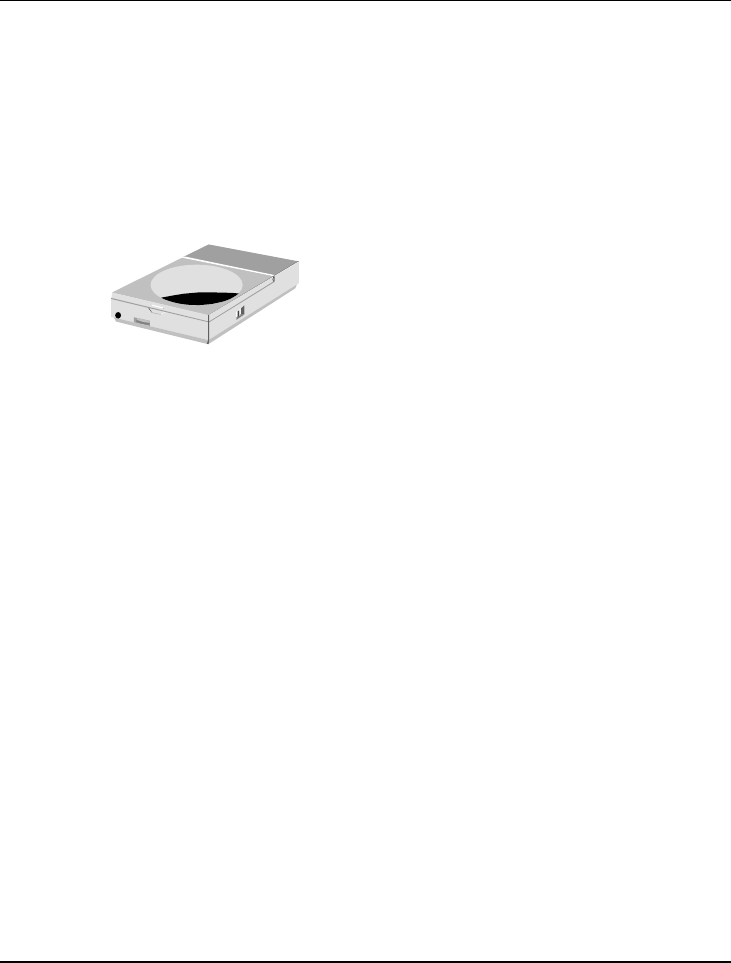
Using Options 7
95
7 Using Options
This chapter describes the advanced features and
expandable architecture in your notebook. For
additional system specifications, upgrades and
available accessories visit www.everex.com
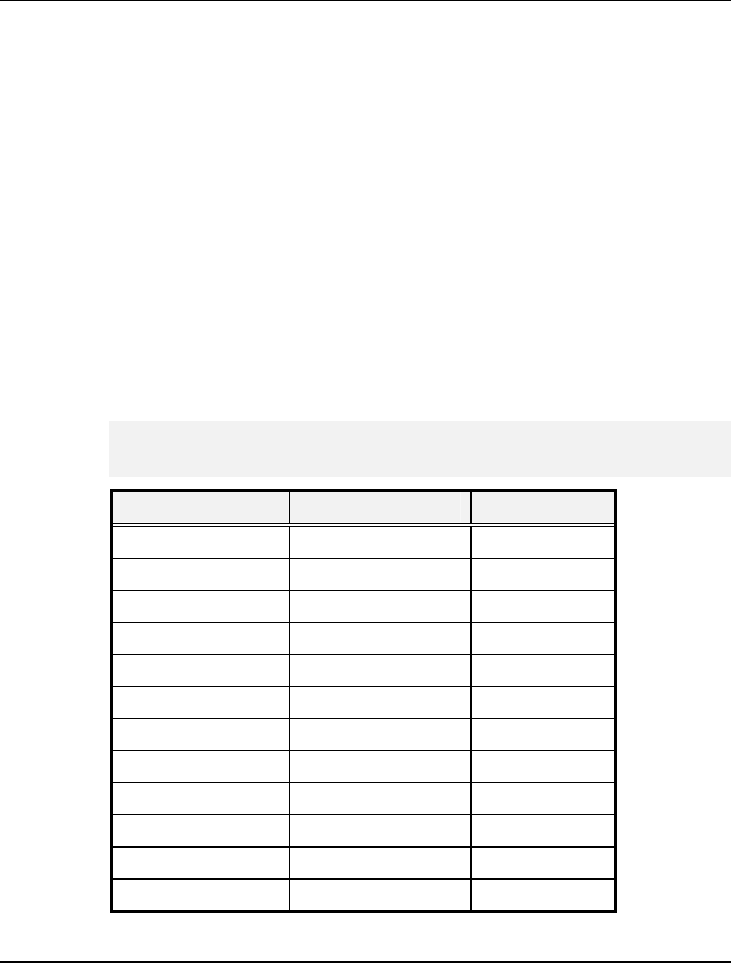
Notebook User Guide
96
System Upgrade
This section provides some steps in doing system upgrade for your notebook
computer. The upgrade procedures include the following:
7.1 Memory Upgrade
Your notebook computer offers 200-pin SODIMM (Small Outline Dual Inline
Memory Module) with at least 256MB DDRII-SDRAM. The memory
compartment is located inside your computer. The table below lists the
possible combinations of different memory module and memory size.
Please contact dealer for changing or adding DDRII-SDRAM module. It is
not available for users to change it by themselves.
Based Memory Installing Memory Total
256 MB 0 MB 256 MB
256 MB 256 MB 512 MB
256 MB 512 MB 768 MB
256 MB 1024 MB 1280 MB
512 MB 0 MB 512 MB
512 MB 256 MB 768 MB
512 MB 512 MB 1024 MB
512 MB 1024MB 1536 MB
1024MB 0 MB 1024 MB
1024MB 256 MB 1280 MB
1024MB 512 MB 1536 MB
1024MB 1024MB 2048 MB
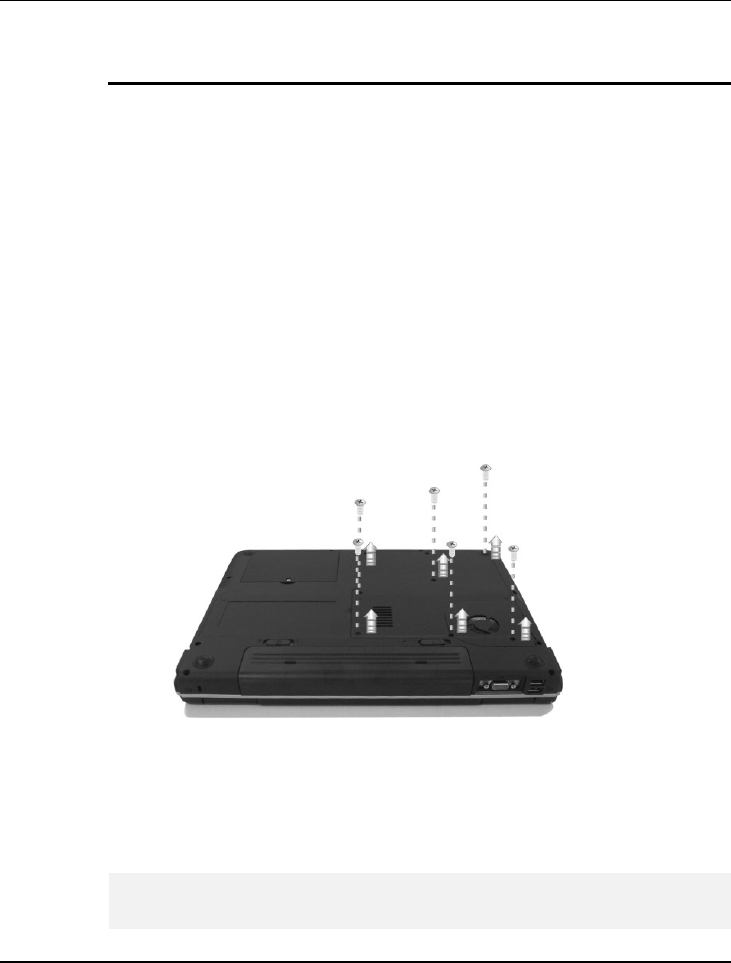
Using Options 7
97
INSTALLING A MEMORY MODULE
Your computer comes with standard 256 MB, 512MB or 1024MB of
synchronous DDRII SDRAM. You can increase system memory to a
maximum of 2048 MB, by installing two small outline double inline memory
modules (SO-DIMMs).
256MB, 512MB And 1024MB memory modules may be used to upgrade your
computer memory.
To install the memory module:
1. Make sure the system is powered off, the battery also is removed and that
no peripheral devices are attached.
2. Turn the computer upside-down and locate the screw that secures the
DIMM door at the underside of the notebook.
3. Remove the screws and open the DIMM cover by your finger.
4. Locate the memory module into the empty memory module sockets.
(Your system comes with one memory module already installed in the
socket.)
Avoid touching the exposed components inside the system. Doing so may
damage the system.

Notebook User Guide
98
5. Insert the connector of the memory module into the socket. Make sure
the notch of the memory module fits the nose of the socket.
y Hold the memory module at a 30-degree angle and push its
connector into the memory socket of the notebook.
y Press down on the edge of the memory module until the locking
tabs on both sides is locked.
6. Put the DIMM door back and secure the screw on the DIMM door.
7. Turn the system over.
To remove a memory module, push the locking tabs aside from the memory
module until the module pops up. Then, remove the memory module.
*Everex recommends using only Everex approved upgrades and accessories.
Use of non-approved Everex memory modules are not guaranteed compatible
with the StepNote line of computers and are not covered under the Everex
Standard Warranty Agreement. Visit www.everex.com to view the complete
line of approved accessories.
7.2 Hard Disk Upgrade
Your notebook computer offers one 2.5" format, 9.5mm height hard disk. If
the volume does not fit your need or it become inoperable, you can upgrade it
by replacing with new hard disk. Please do the following steps to change it.
1. Remove the screw and open the cover by lifting its upper side cover.
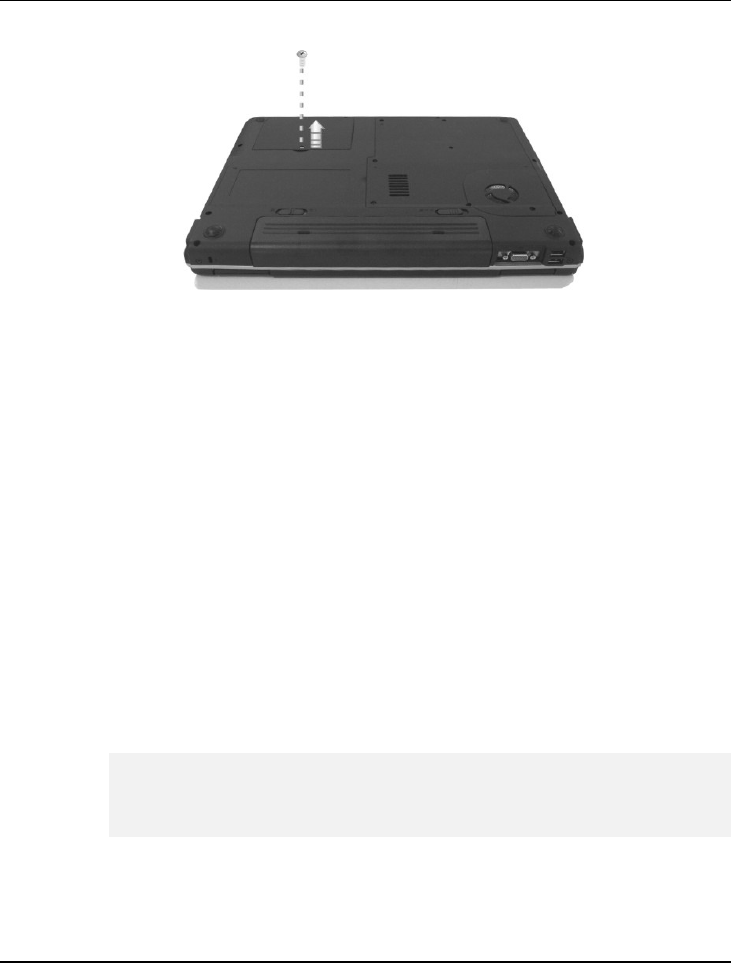
Using Options 7
99
2. Take out the hard disk from the compartment by finger carefully
3. Remove the connector from the hard disk gently.
4. Remove the crane screws located at each side of the hard disk.
5. Rotate and tighten the crane screws to the new hard disk.
6. Attach the connector to the new hard disk precisely.
7. Place the hard disk back to the compartment.
8. Cover the lid, then rotate and tighten the screws.
9. Set the boot device as optical drive and Primary Master as Auto on BIOS
setup menu. Please refer to Chapter 6 about the setting of BIOS setup
menu. Then, boot the system by using WinXP CD-ROM and the system
will detect the hard disk automatically and prompt you how to format the
new disk.
Please tighten the screws located at each side of the hard disk before
operating the hard disk. Any vibration may cause damage for the running
hard disk.

Notebook User Guide
100
Please contact Everex before attempting to change the hard disk drive.
Damage caused by improper HDD installation will void the Everex
Standard Warranty Agreement
7.3 Wireless Module Installation
This computer uses mini-PCI wireless LAN module at the bottom of this
notebook for wireless connection.
Please contact Everex before adding or changing the wireless module. Any
damage that caused by improper installation of the wireless module will
void the Everex Standard Warranty Agreement

Caring for Your Notebook 8
101
8 Caring for Your
Notebook
Your Everex StepNote is a fully IBM compatible
personal computer with the latest features in mobile
computing and multimedia technology. If properly
cared for and maintained, the performance and
reliability of the computer can be greatly prolonged.

Notebook User Guide
102
8.1 Important Safety Instructions
This section provides detailed information about how to maintain a safe
working environment while using the notebook computer. You can maintain
its condition and performance by following these guidelines. Please read it
carefully to ensure maximum safety.
• Before cleaning the notebook computer, make sure it is disconnected
from any external power supplies (i.e. AC adapter, car adapter and so on).
• When cleaning, do not use liquid or sprayed detergent for cleaning.
Instead, use moisture sheet or a cloth for cleaning.
• The socket-outlet shall be installed near the notebook computer and shall
be easily accessible.
• Please keep the notebook computer from humidity.
• Lay the notebook computer on a reliable surface when installing. A drop
or fall may cause injury.
• The openings on the enclosure are for air convection hence the notebook
computer can be protected from overheating. DO NOT COVER THE
OPENINGS.
• Be careful of using power supply. The notebook computer has specific
power requirements.
• Use only a power adapter approved for use with this notebook computer.
• The power adapter may have a 2-prong plug. This is an important safety
feature. A compatible outlet is required. If it is not available, find a
qualified electrician to install one.

Caring for Your Notebook 8
103
• While unplugging the power cord, disconnect it by the plug head, not by
its wire.
• Make sure the socket and any extension cords you may use can support
the total current load of all the connected devices.
• Though your AC adapter is suitable for universal international voltage, it
still requires a stable and continual power supply. Make sure the voltage of
the power source when connect the notebook computer to the power
outlet. If your are unsure of your local power specifications, consult your
dealer or local power company.
• Place the power cord in such a way that people can not step on it. Do not
place anything over the power cord.
• All cautions and warnings on the notebook computer should be noted.
• If the notebook computer is not in use for a long time, disconnect it from
mains to avoid possible damage by transient over-voltage.
• Never pour any liquid into openings as this may cause fire or electrical
shock.
• Never open the body of notebook computer. For safety reason, the
notebook computer should only be opened by qualified service personnel.
• If one of the following situations arises, have the notebook computer
checked by service personnel:
The power cord or plug is damaged.
Liquid has penetrated into the notebook computer.
The notebook computer has been exposed to moisture.
The notebook computer has not worked well or you can not get it
work according to user’s manual.

Notebook User Guide
104
The notebook computer has dropped and damaged.
The notebook computer has obvious sign of breakage.
• Do not leave this notebook computer in an environment unconditioned.
Storage temperature above 60ºC (140ºF) may damage the notebook
computer.
• An approved power cord has to be used for the notebook computer’s
power supply. For a rated current up to 6A and an equipment weight
more than 3 kg, a power cord not lighter than H05VV-F, 2G, 0.75mm2,
has to be used.
• To avoid any damage happened to the internal device, you should first
disconnect the AC adapter and remove the battery pack from the
notebook when replacing any internal device.
The sound pressure level at the operator's position according to IEC 60704-1
is equal or less than 70dB(A).
8.2 Cleaning Your Computer
When it is necessary to clean the plastic case and keyboard, use a soft, lint-free
cloth, slightly dampened with a mild detergent solution or use the contents of
any commercially available computer cleaning kit.
Never use alcohol, petroleum-based solvents, or harsh detergents to clean the
notebook. Also never spray any liquids directly on the computer case,
keyboard, or screen. If the liquid-crystal display (LCD) screen has become
smeared or dusty, clean the screen by first applying a mild glass cleaner to a
soft, clean, lint-free cloth, and gently wipe the glass. Never apply liquids
directly on the screen surface. Moreover, do not use paper towels to clean the
display screen. Paper can scratch the display screen matte.

Caring for Your Notebook 8
105
8.3 Maintaining the LCD Quality
When it comes to screen problems, heat plays a significant role. After a typical
working session, users routinely close the notebook the cover. The display
surface - no matter what type it is - and the components inside the computer
radiate heat; when you close the cover, you trap the heat against the screen. To
help prolong the life of your computer, leave the cover open for ten minutes
while the heat disperses.
You should also enable the power management of your computer to turn off
the LCD power and display when the system is inactive for some time.
Adding a screen saver also helps prolong the life of your notebook screen.
Follow the safety guidelines mentioned earlier and how to clean your
computer.
8.4 Maintaining Your Hard Disk
Losing your data has the same consequences as a system break down. Users
must make it a habit of doing hard disk maintenance every week or so. Here is
some maintenance you could do:
• Always back up your data files from your hard disk.
• Install the virus detecting program to monitor virus that could tamper
your files.
• Use SCANDISK occasionally to correct any errors found in the directory
and File Allocation Table. This will also free up space from any unused
sectors.
• Never move or raise the computer while the hard disk is being accessed,
most especially don't jar the hard disk as this may cause a hard disk crash.

Notebook User Guide
106
• Use hard disk maintenance programs like Disk Defragmenter of
Windows. These reorganize your hard disk by eliminating fragmentation
and improving your hard disk access time.
• Install a system password in your computer so others won't be able to use
the hard disk.
8.5 Battery Care Guidelines
The battery pack furnished with the computer requires reasonable care and
handling to ensure efficient operation and maximum life. There is a risk of fire
and chemical burn if the battery pack is handled improperly.
To ensure that the battery pack endures normal life cycle, always observe the
following precautions when handling the battery pack:
• Handle batteries carefully. Do not try to disassemble, crush, puncture,
open, drop, mutilate, short external contacts, disposed of in water or fire,
or expose it to temperatures higher than 60 C.
• Recharge batteries only as described in this manual and only in ventilated
areas. Never use an external charger other than the one supplied with your
computer.
• Do not leave batteries in hot locations for more than a day or two.
• Do not leave your battery in your computer for longer than 1 month
without plugging in the power adapter.
• Do not leave battery in storage for more than 2 months without
recharging it to prevent over discharge. Over discharge will hurt the
battery
• Dispose dead battery properly to protect the environment. The batteries
contain hazardous chemicals and should not be thrown out with
household or office trash.

Caring for Your Notebook 8
107
• You should always discharge your battery before recharging it on either of
these two conditions: first, this is the first time you start to use your
battery; second, you had not charge the battery for more than 2 months.
To discharge the battery, please execute the "Battery Refresh" function in
the BIOS Setup Utility.
8.6 When You Travel
For safety and convenience when traveling, please follow these instructions:
• Back up all needed files on your hard disk before traveling.
• Recharge your battery overnight to ensure full battery power before you
leave.
• Don't forget to bring along the AC adapter and extra battery pack.
• Try to bring backup software as well.
• Check the voltage rating and the outlet type of your destination. If the
power cord of the adapter is different, then you need to purchase a
suitable one. Consult your dealer.
• Carry your computer in its carrying case or in a briefcase. Never check-in
the computer as a luggage.
• Remember to apply those power saving features and techniques to save
battery power.
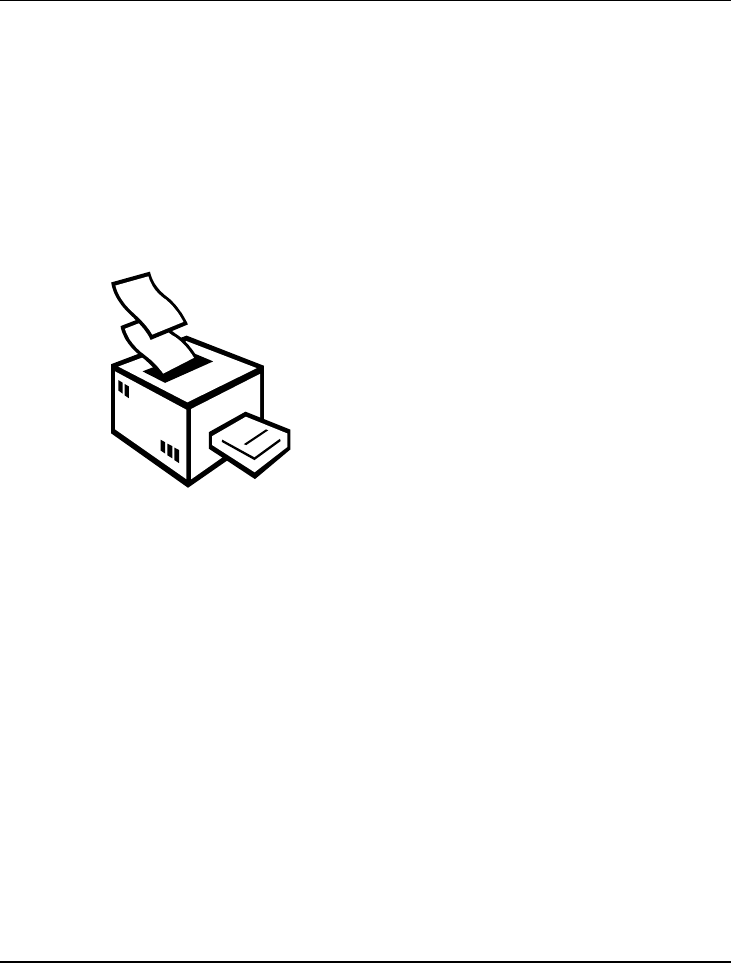
System Specification A
109
APPENDIX A
System Specification
This appendix provides technical specifications for
the Everex StepNote computer. Depending on the
specific Everex model, specifications may vary.

Notebook User Guide
110
System Specification
PROCESSOR UNIT
• Intel® Celeron® M Processor Dothan
• Above 1.3 GHz CPU
• 1MB integrated L2 cache for the processor
SYSTEM MEMORY
• Two 200-pin memory slots
• User-upgradeable to maximum 2GB using 200-pin SODIMM 256MB,
512MB or 1024MB modules
• DDRII –533 SDRAM modules
LCD DISPLAY
• 15.4" WXGA (16:10) Color TFT LCD, 1280x800
• Maximum 16M true colors on all LCD display
VGA SYSTEM
• Integrated VIA VN800 graphic engine
• Simultaneous LCD and external monitor (CRT) display
• Maximum 16 million colors on LCD display at 1280x800 resolution for
15.4" LCD

System Specification A
111
• Maximum 16 million colors on external monitor or projector at
1280x1024 resolution (Non-Interlaced)
STORAGE
• 2.5” Format 9.5mm High PATA HDD Module; Bus Mastering, Ultra
DMA ATA-133 Support for LBA Scheme
• Enhanced IDE bootable DVD/CD-RW Combo drive module
• Optional DVD Dual drive
AUDIO SYSTEM
• Full-duplex 16-bit stereo speaker with wavetable support
• H/W Audio Sound Blaster 16 compatible
• Built-in one speaker
• Audio input jacks for microphone (MIC)
• Audio output jack for external speaker or headphone (Line-Out)
• Digitized audio SPDIF port for high quality signal transmission.
• Sound volume adjust by K/B Hot-Keys
TOUCHPAD
Integrated Touchpad (Serial/USB mouse) pointing device with 2 click buttons
KEYBOARD
Full-sized 87-keys keyboard with Windows systems hot-keys, inverted T-cursor
keys, 6 hot keys, 12 function keys, and embedded numeric keypad

Notebook User Guide
112
FLASH BIOS
512K Flash ROM BIOS for easy BIOS upgrade
I/O PORTS
• 1 x 15-pin VGA port
• 1 x TV-Out Port (S-Video)
• 3 x Universal Serial Bus (USB 2.0)
• 1 x LAN port
• 1 x Modem port
WIRELESS DEVICES
IEEE 802.11b/g, Mini PCI 802.11b/g Wireless LAN Solution
AC/DC POWER SUPPLY ADAPTER
Universal auto-switching (100V~240V) 65W adapter, 20 Volt
BATTERY
Rechargeable 3 or 6 Cells Li-ion battery pack with Smart Battery function
WEIGHT AND DIMENSION
• 357(W) x 271(D) x 24 ~ 39(H) mm
• Approximately 3.18 kg
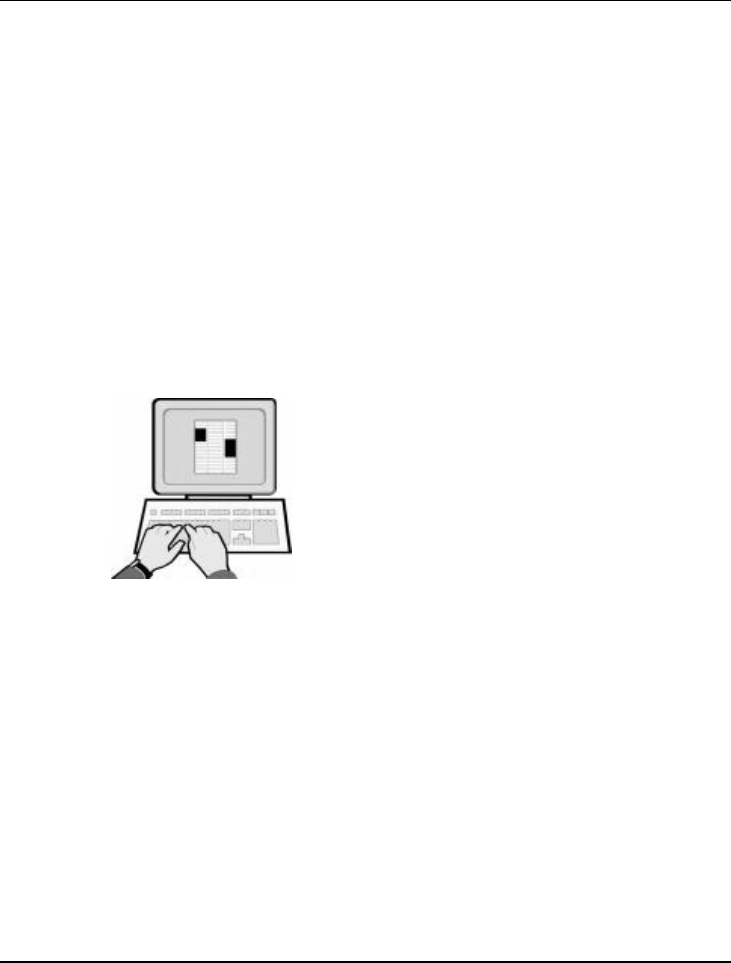
System Specification A
113
APPENDIX B
System Recovery, Driver
and Norton Installation
Appendix B provides information on how to install
the Driver Utility, Norton Internet Security 2006, and
how to restore the software and operating system of
your computer back to the original factory settings.
In the system recovery section, you will learn how to
recover all files to your system with or without
formatting the user partition.
Follow the step-by-step instructions carefully and
exercise caution to avoid data loss.
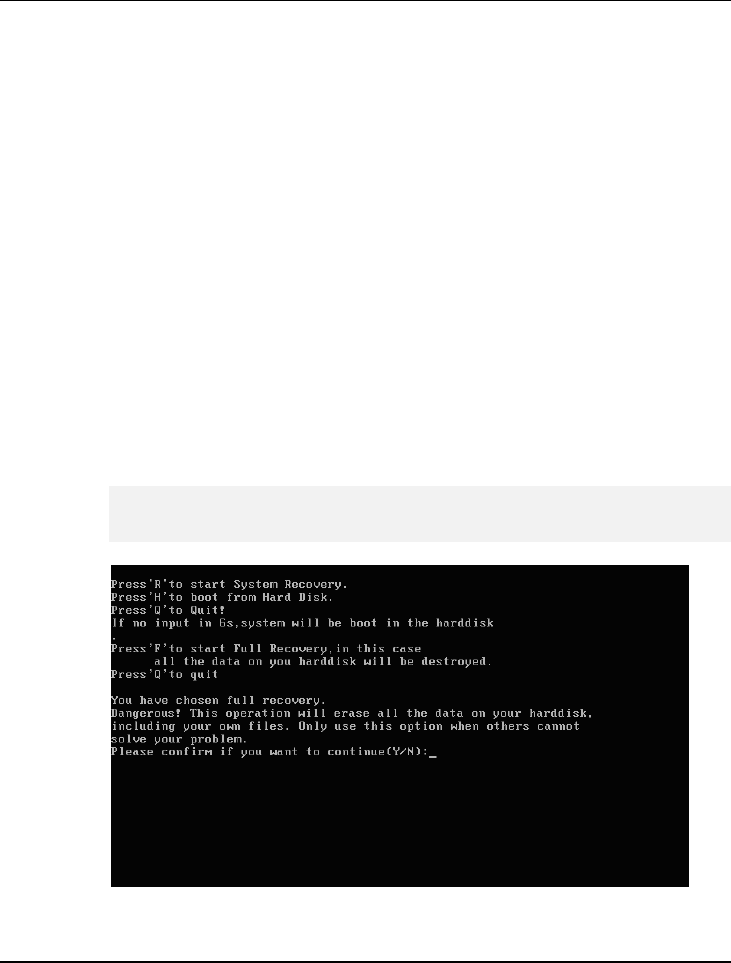
Notebook User Guide
114
System Recovery
1. Power on the system and place the recovery CD into Optical Disk Drive.
2. Press "F2" to display the BIOS Setup Utility, then choose "Boot" from
the main menu. Change the first boot-up device to "CD-ROM/DVD-
ROM".
3. Press "F10" to confirm the setup parameters.
4. When the recover screen appears, press "R" to start System Recovery.
(Figure 1)
5. Press "F" to start Full Recovery process.
6. Confirm the full recovery then press "Y" to continue.
FULL RECOVERY WILL PERMANENTLY ERASE ALL DATA ON
THE HARD DISK DRIVE, CONFIRM BEFORE PROCEEDING.
(Figure 1)
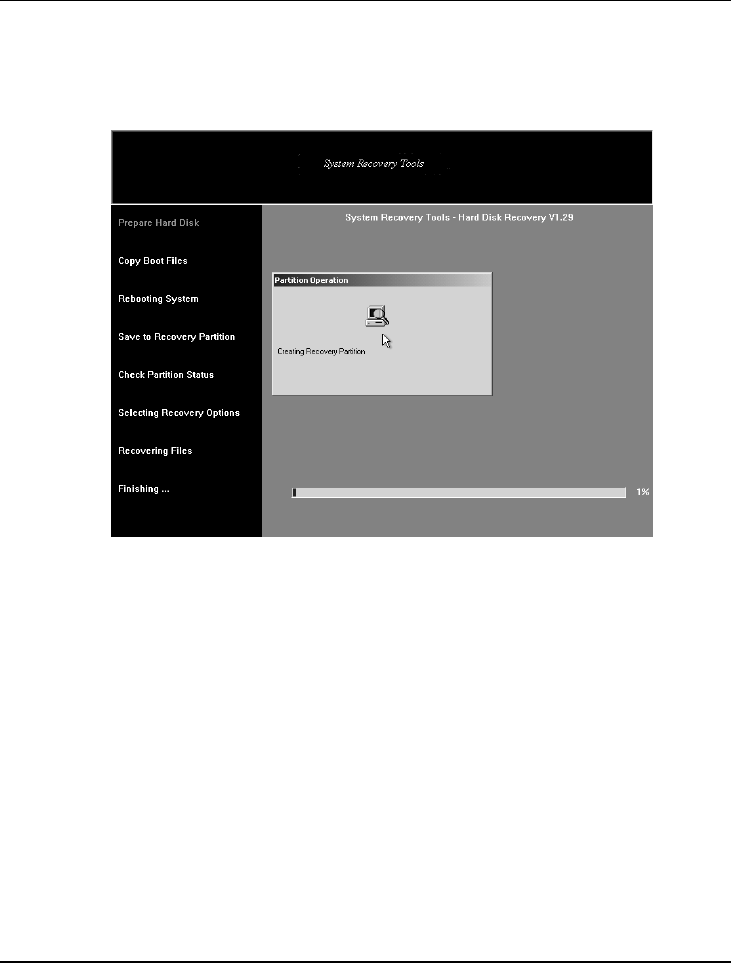
System Specification A
115
7. The recovery system tool will start running. (Figure 2)
(Figure 2)
8. While rebooting the system, press "H" (boot from Hard Disk) to
continue the recovery process. (Figure 3)
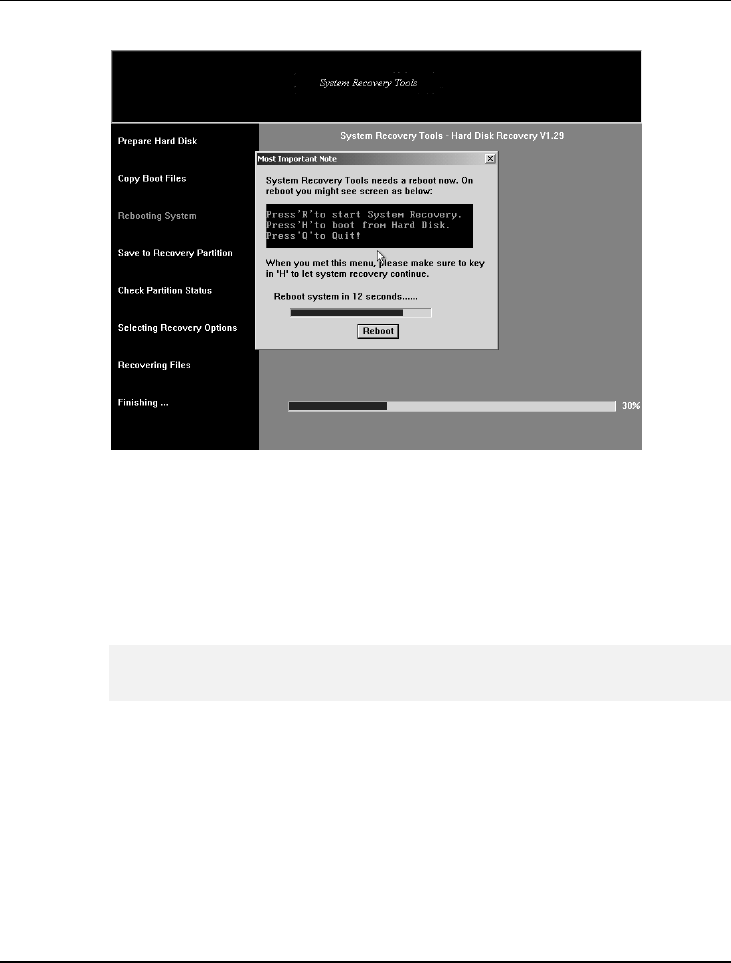
Notebook User Guide
116
(Figure 3)
9. For the finish stage of the Recovery process, a CRC verification
confirmation screen will be displayed. This step ensures all files in the
Recovery CD are fully restored to your hard disk without loss.
You may decide to perform this checking by selecting "Yes" or "No".
(Figure 4)
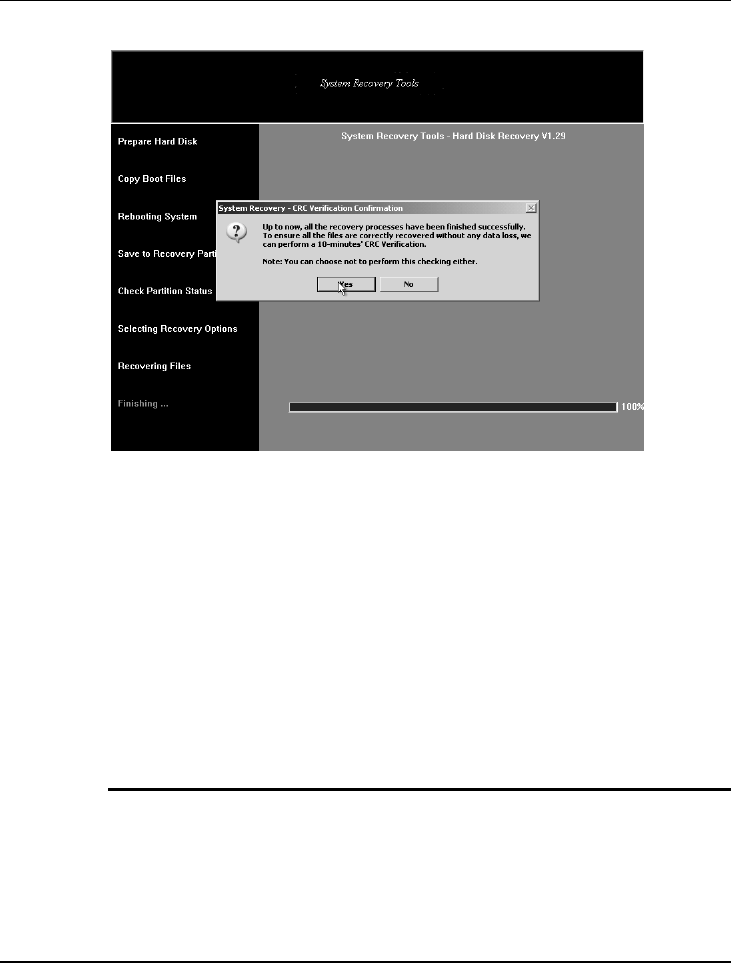
System Specification A
117
(Figure 4)
Device Drivers Installation
If you already have an operating system installed into your notebook
computer, it is best to install the needed device drivers for using the built-in
devices of your computer. Before installing the drivers, check with your dealer
first if they have already installed all the drivers along with the operating
system. If not, follow the procedures below:
INSTALLING WINDOWS XP FROM OPTICAL DISK DRIVE
To install Windows XP directly from your optical disk drive, please go to Boot
menu of BIOS setup menu. Use arrow key to select "CD-ROM Drive", then
use "+" or "-" to move it to the top. Go to Exit menu and select "Exit
Saving Changes". Accordingly, insert the Windows XP installation CD into

Notebook User Guide
118
optical disk drive with following the instructions on the screen to finish the
installation.
DRIVER INSTALLATION NOTE:
Please be notified that whenever you install the driver utility, it should be
install the CHIPSET Driver first.
INSTALLING THE CHIPSET DRIVER
Your notebook computer uses the advanced chipset. Installing the driver to
enhance the stability and performance.
Installing Chipset device driver for Windows XP
1. Click the Start button, then point to Run. The Run dialog box appears.
2. Click the Browse button and specify the directory as
"E:\Drivers\WinXP\Chipset\Setup.exe".
3. Click "OK" to execute the setup program. The Setup box appears.
4. Click "Next" continuously to install this driver when screen displays this
command.
5. Click "Yes" to accept the License Agreement .
6. Click “Next” twice to continue the installation.
7. Tick the option "Yes, I want to restart my computer now.", and press
“OK” to restart your system.
INSTALLING THE VGA DEVICE DRIVER
Following is the procedure for installing the Video Accelerator 3D Adapter
VGA driver to your computer:

System Specification A
119
Installing VGA device driver for Windows XP
1. Click the Start button, then point to Run. The Run dialog box appears.
2. Click the Browse button and specify the directory as.
"E:\Drivers\WinXP\VGA\Setup.exe".
3. Click "OK" to execute the setup program. The Setup box appears.
4. Press "Finish" to complete the installation.
INSTALLING THE AUDIO DEVICE DRIVER
Your notebook computer uses the Realtek Audio controller.
Installing Audio device driver for Windows XP
1. Click the Start button, then point to Run. The Run dialog box appears.
2. Click the Browse button and specify the directory as.
"E:\Drivers\WinXP\Audio\Setup.exe"
where the audio driver is located.
3. Click "OK" to implement the setup program to install this driver.
4. Click "Next" to continue the following steps.
5. Tick the option "Yes, I want to restart my computer now.",
and press "Finish" to restart your system.
INSTALLING THE MODEM DEVICE DRIVER
Please follow the procedures below for installing the Modem driver:
Installing Modem driver for Windows XP
1. Click the Start button, then point to Run. The Run dialog box appears.

Notebook User Guide
120
2. Click Browse button and navigate to the directory as
"E:\Drivers\WinXP\Modem\ssetup.exe"
3. Click "OK" to implement the setup program to install this driver.
4. Click "OK" to install the modem driver.
INSTALLING ENE - KEYBOARD CONTROLLER DRIVER
Installing ENE- Keyboard Controller driver for Windows XP
1. Click the Start button, then point to Run. The Run dialog box appears.
2. Click the Browse button and specify the directory as.
"E:\Drivers\WinXP\KBC\Setup.exe".
3. Click "OK" to implement the setup program to install this driver.
4. Click "Next" to execute the setup program.
5. Tick the option "Restart Windows now.", and press Finish to restart
your system.
INSTALLING THE WIRELESS LAN DEVICE DRIVER
Please follow the procedures below for installing the Mini PCI Adapter driver:
Installing Wireless LAN driver for Windows XP
1. Click the Start button and then click Run. The Run dialog box appears.
2. Click Browse button and specify the directory as
"E:\Drivers\Winxp\Wireless LAN\setup.exe"
3. Click "OK" to implement the setup program to install this driver.
4. Click "Next" twice to continue the installation.
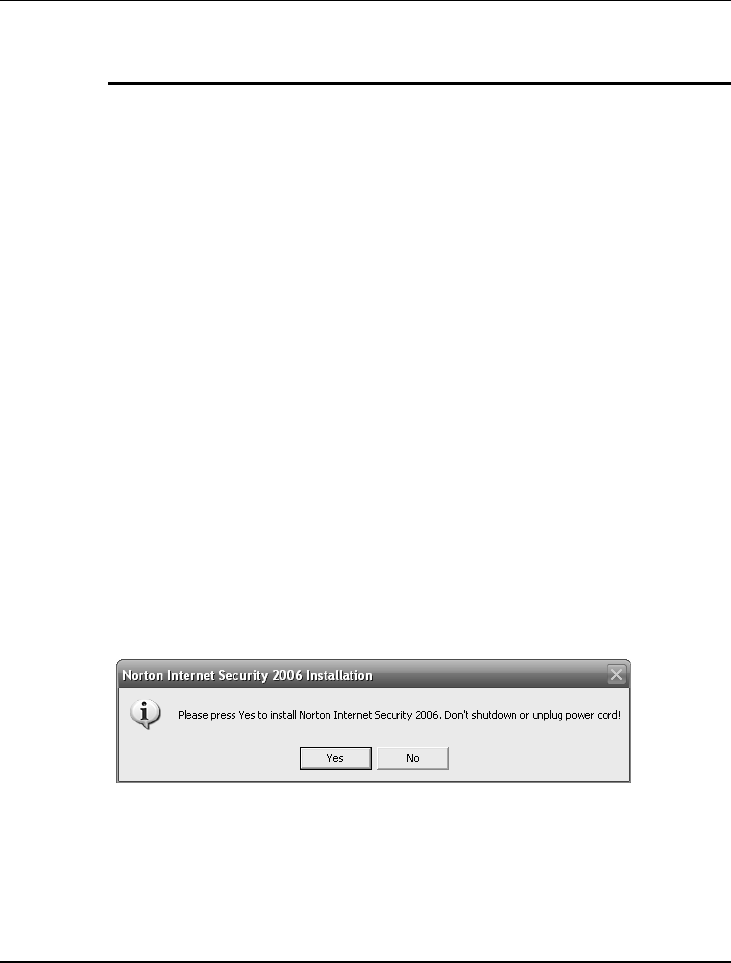
System Specification A
121
INSTALLING THE LAN DEVICE DRIVER
Please follow the procedures below for installing the LAN driver:
Installing LAN driver for Windows XP
1. Click the Start button, then point to Run. The Run dialog box appears.
2. Click the Browse button and specify the directory as.
"E:\Drivers\Winxp\LAN\WinSetup.exe "
3. Click "OK" to implement the setup program to install this driver.
Click "OK" to complete the installation.
Norton Installation
Norton Internet Security 2006 Installation
The installation process will initiate at the first launch of Windows desktop. If
you wish to manually start the installation process, please execute
C:\Apps\NIS2006\SymSetup.exe
1. Click "Yes" to continue.
2. Click "Start Scan" to check your computer
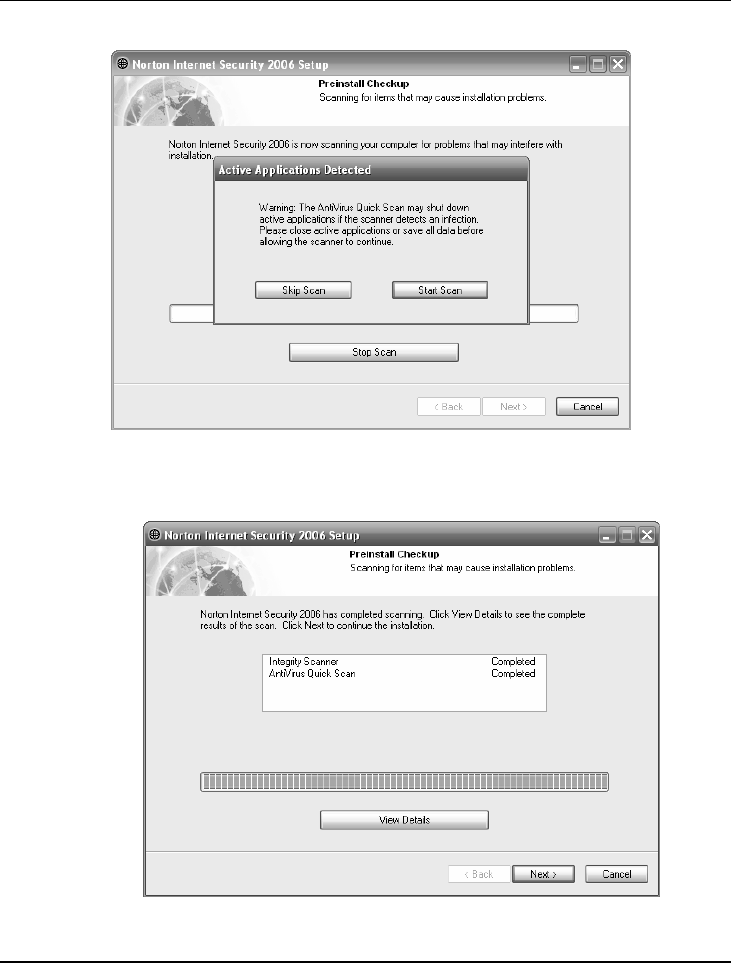
Notebook User Guide
122
3. Click "View Details" to see the complete results of the scan
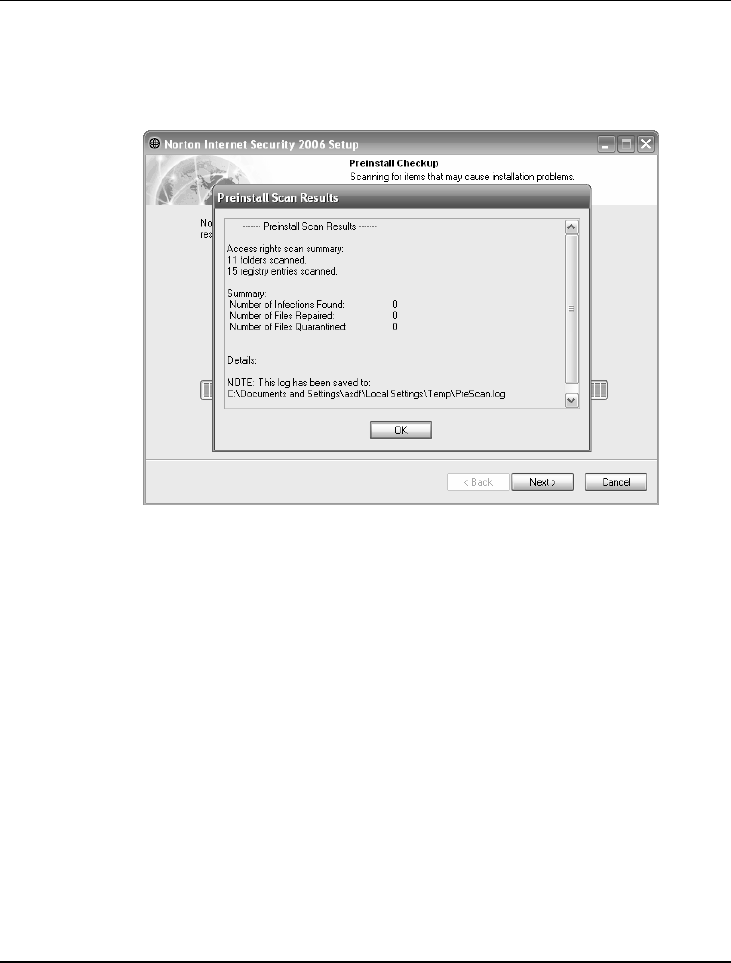
System Specification A
123
4. Scan Results
5. Click "Next" to continue.
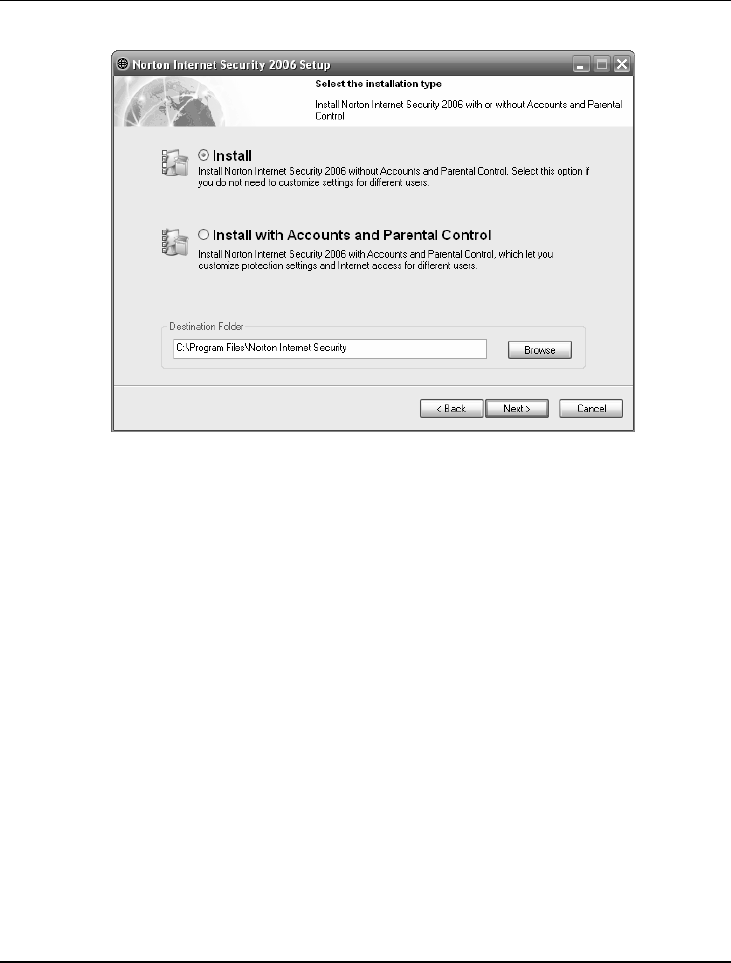
Notebook User Guide
124
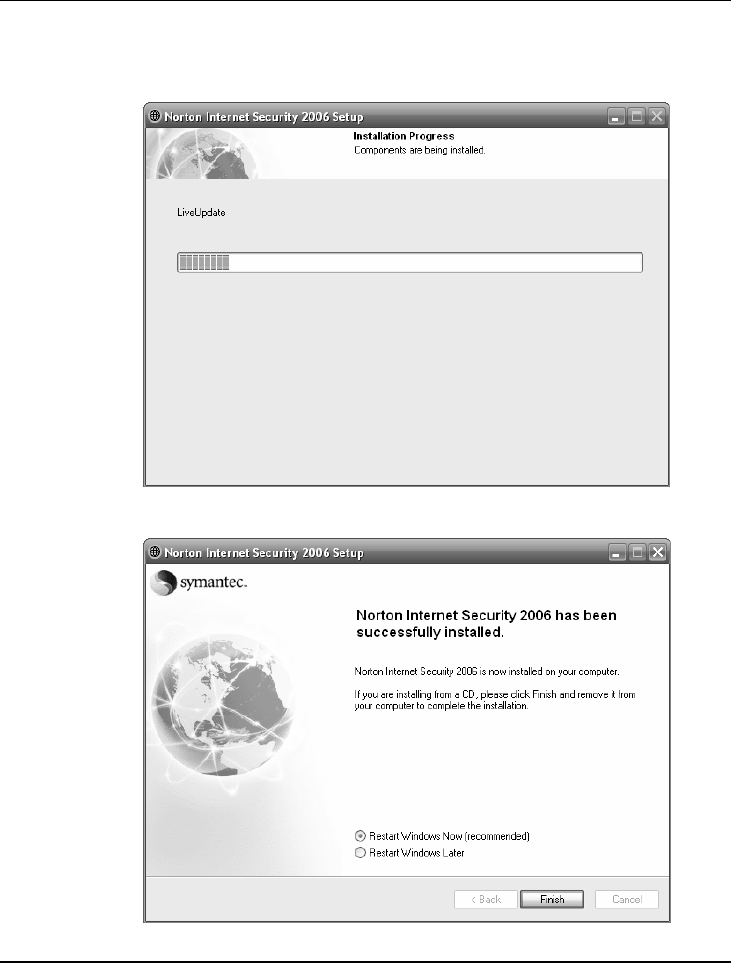
System Specification A
125
6. System now executes the installation.
7. When the installation completes, click "Finish" to restart the computer.

Notebook User Guide
126
TECHNICAL SUPPORT
For the latest Drivers and Support Documents or to chat online with a
Live Technician visit www.everex.com
To contact Technical Support via email, send your User Name, Model,
Serial Number and a brief Description of the issue at hand to
techsupport@everex.com
To register your product visit www.everex.com or simply email your User
Name (first and last), Model (NM3500W, NM3900W, etc.) and Serial
Number to customerservice@everex.com. Please use “Product
Registration – NMXXXX” as your email subject.
To speak with an Everex Technical Support Representative call our 24-
Hour response team at 1-866-850-8835 (toll-free)
Please complete the following information before contacting Everex Technical
Support:
User Name : _________________________________________
Model (NM3500W, NM3900W, etc.): ______________________________
Serial Number : _________________________________________
Problem Description : _________________________________________
____________________________________________________________
____________________________________________________________
Everex Systems, Inc., 440 Mission Court, #250, Fremont CA 94539,